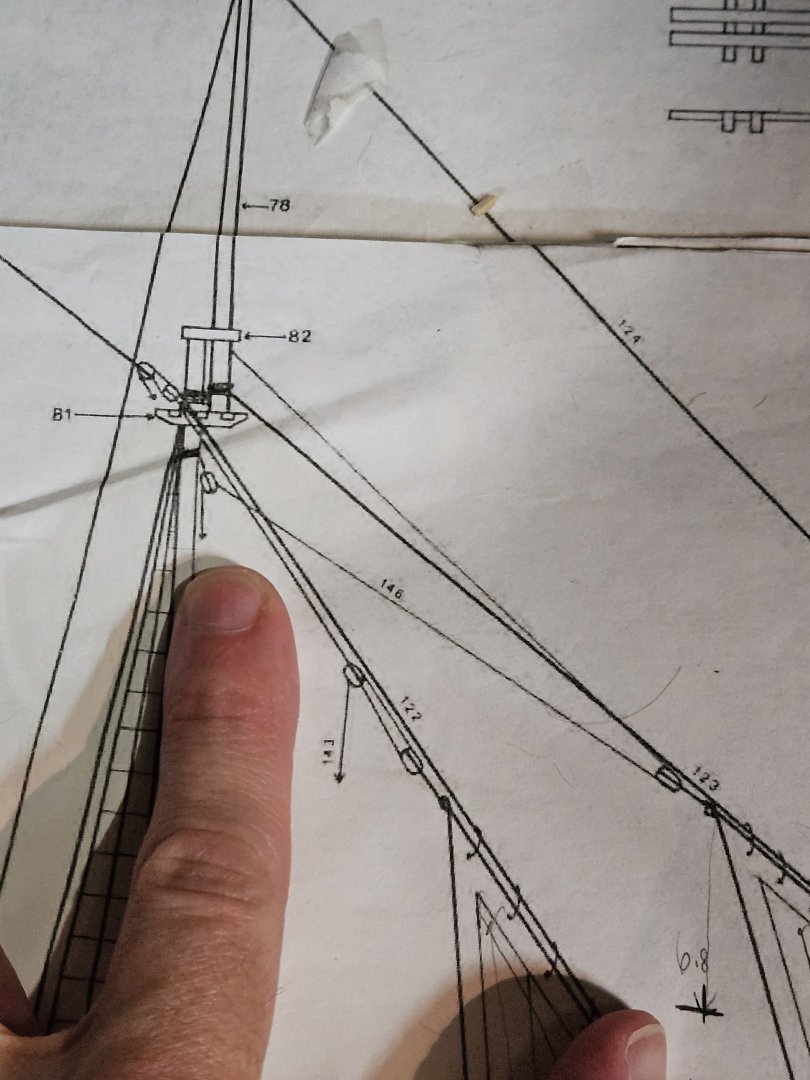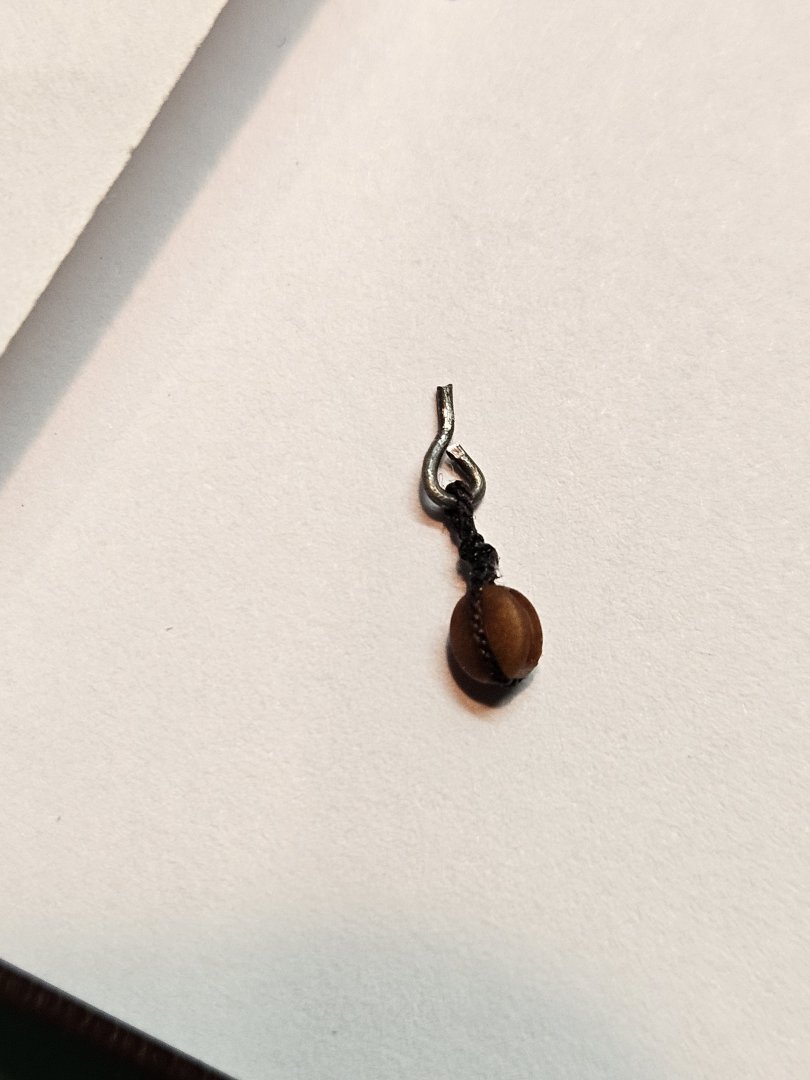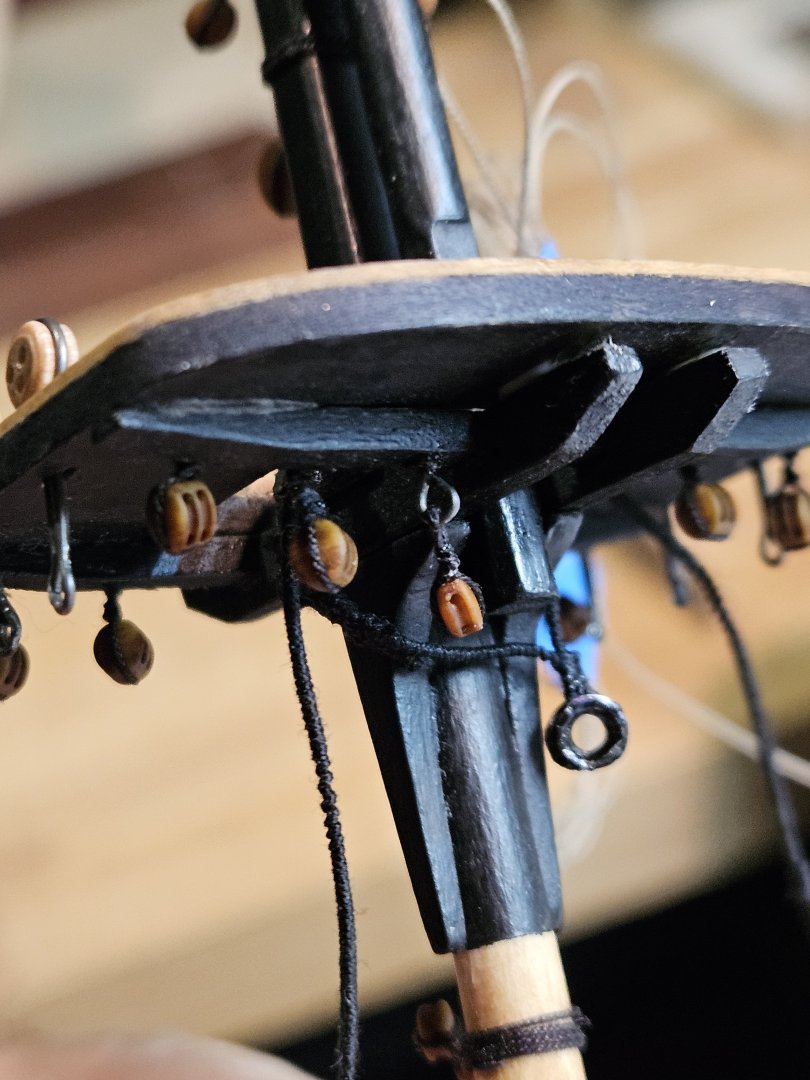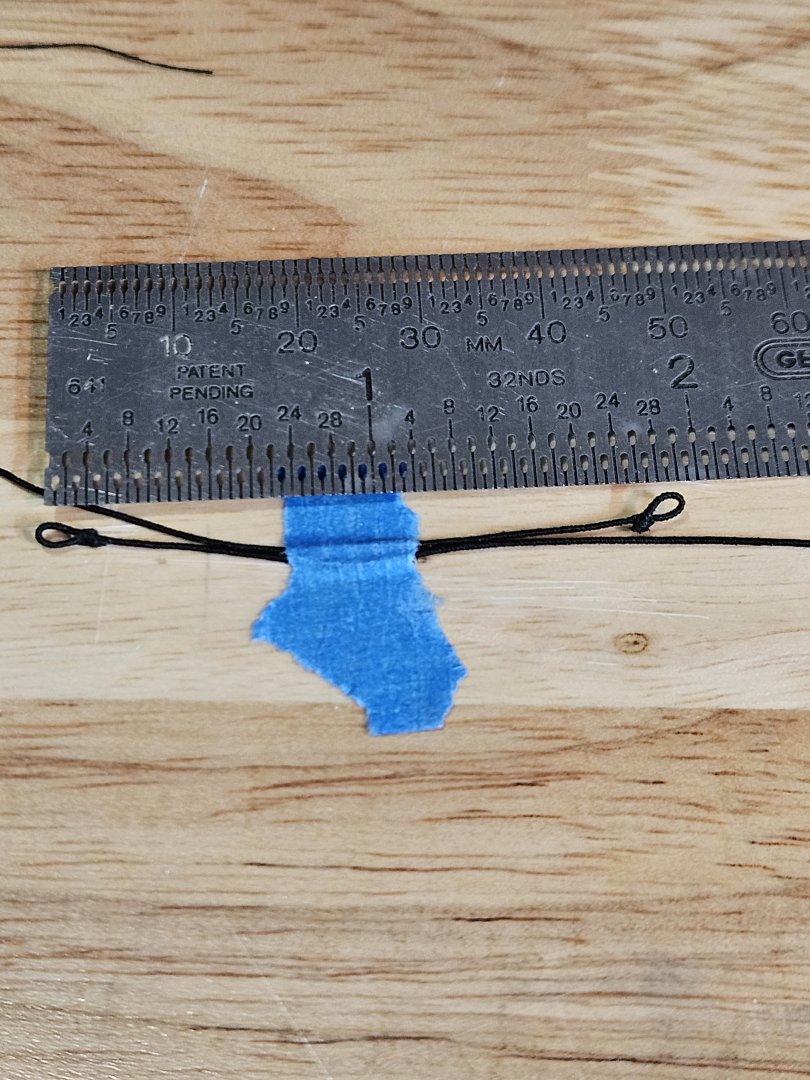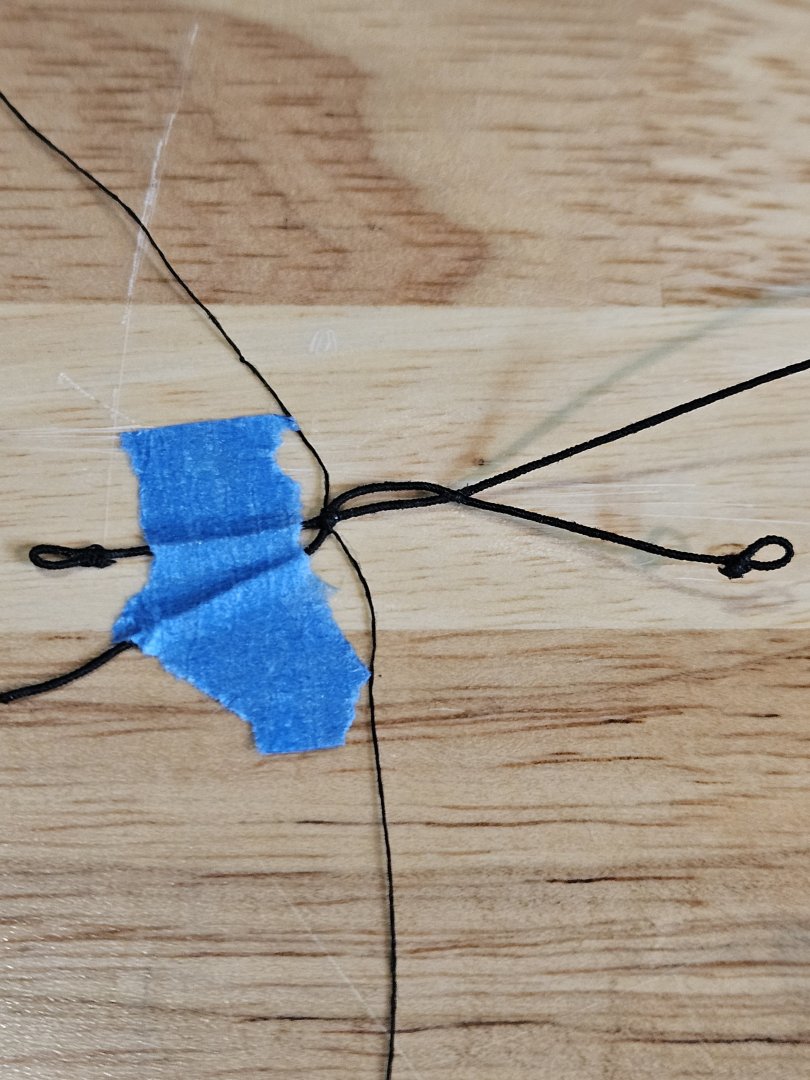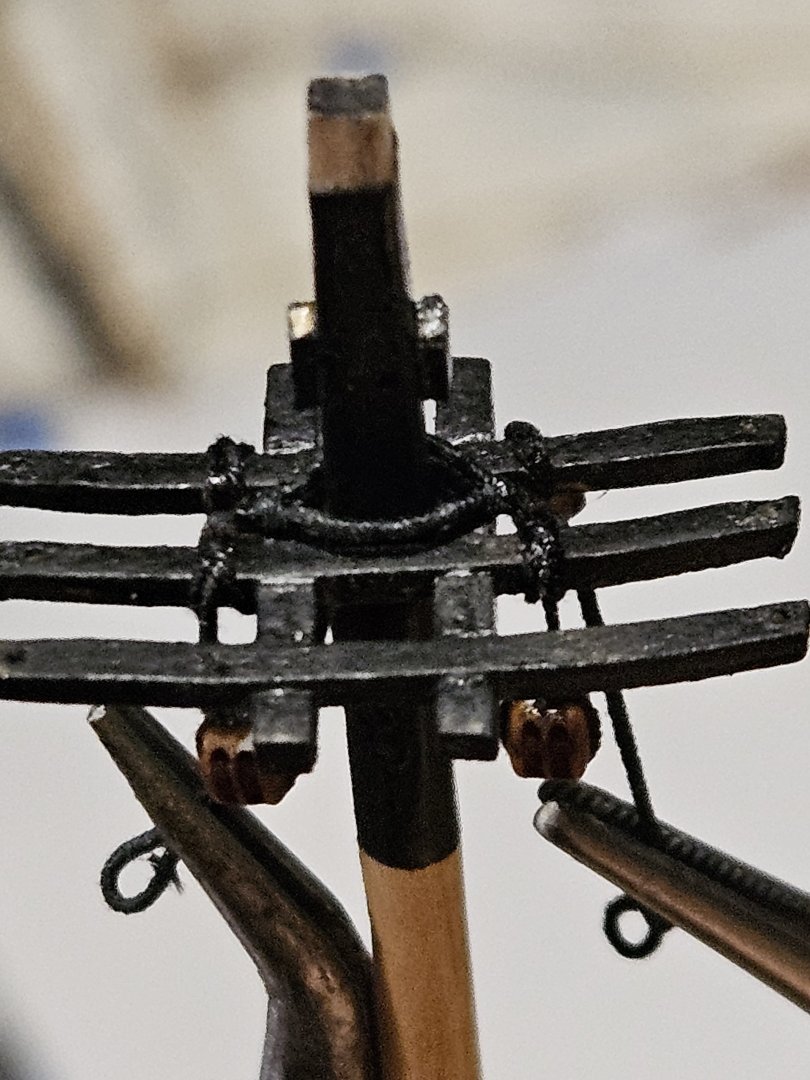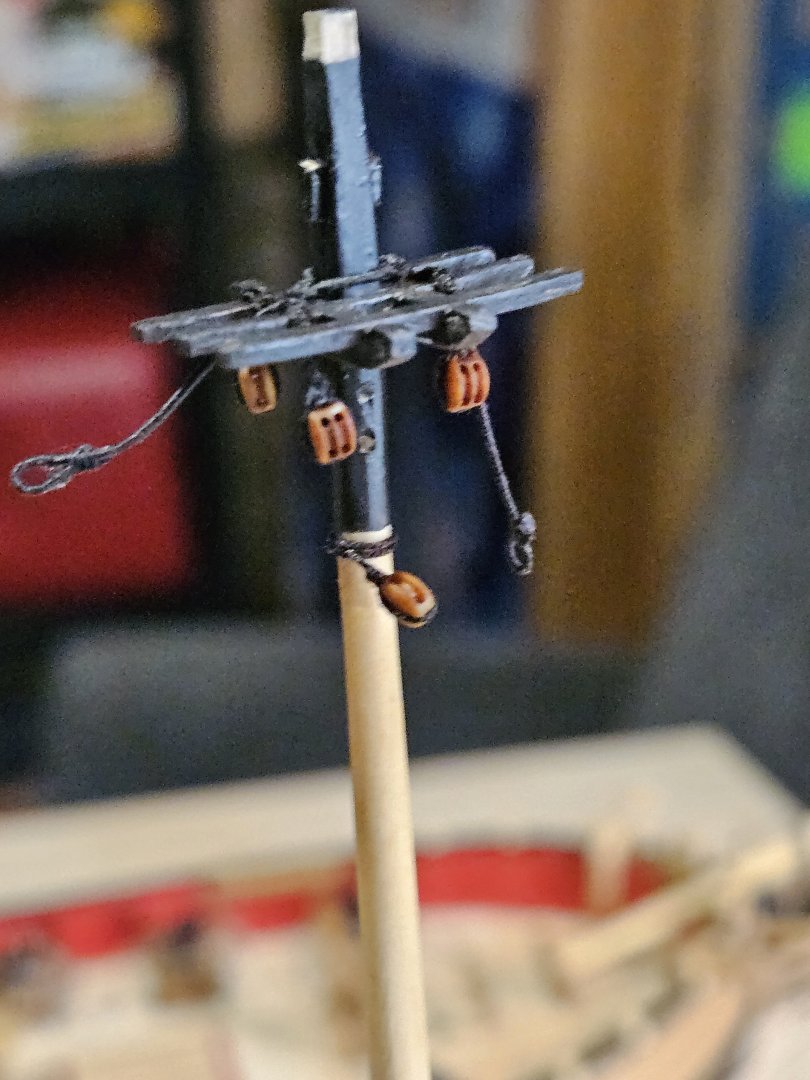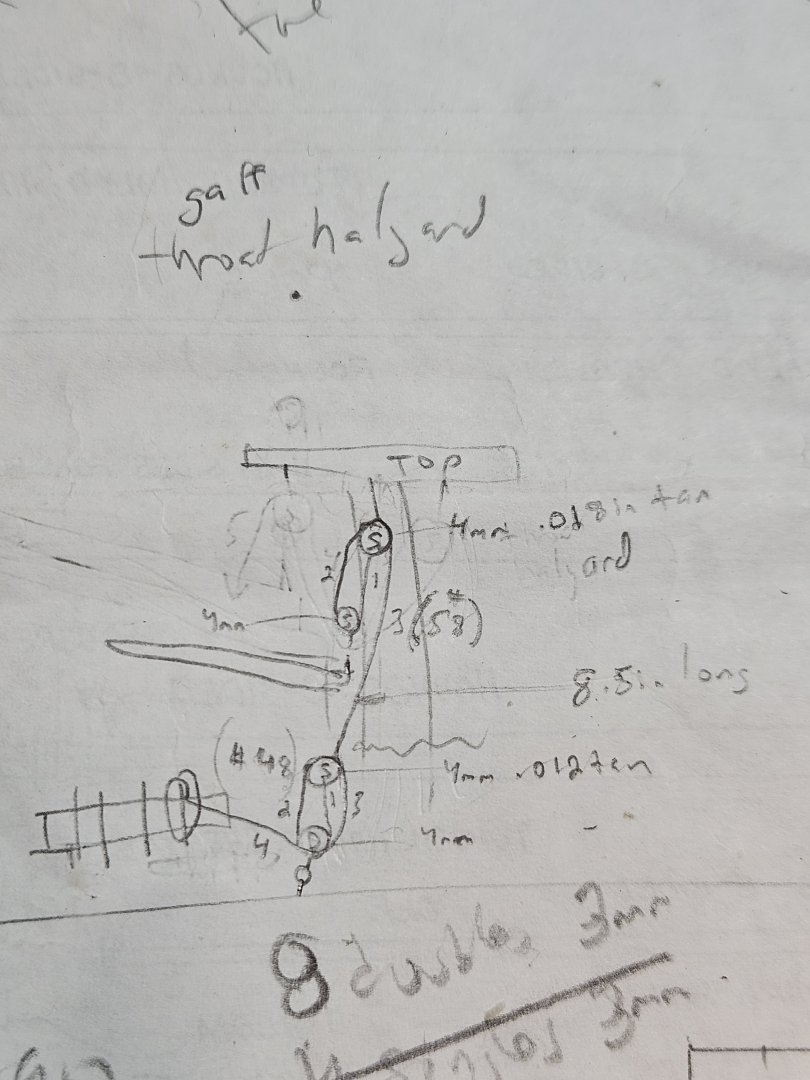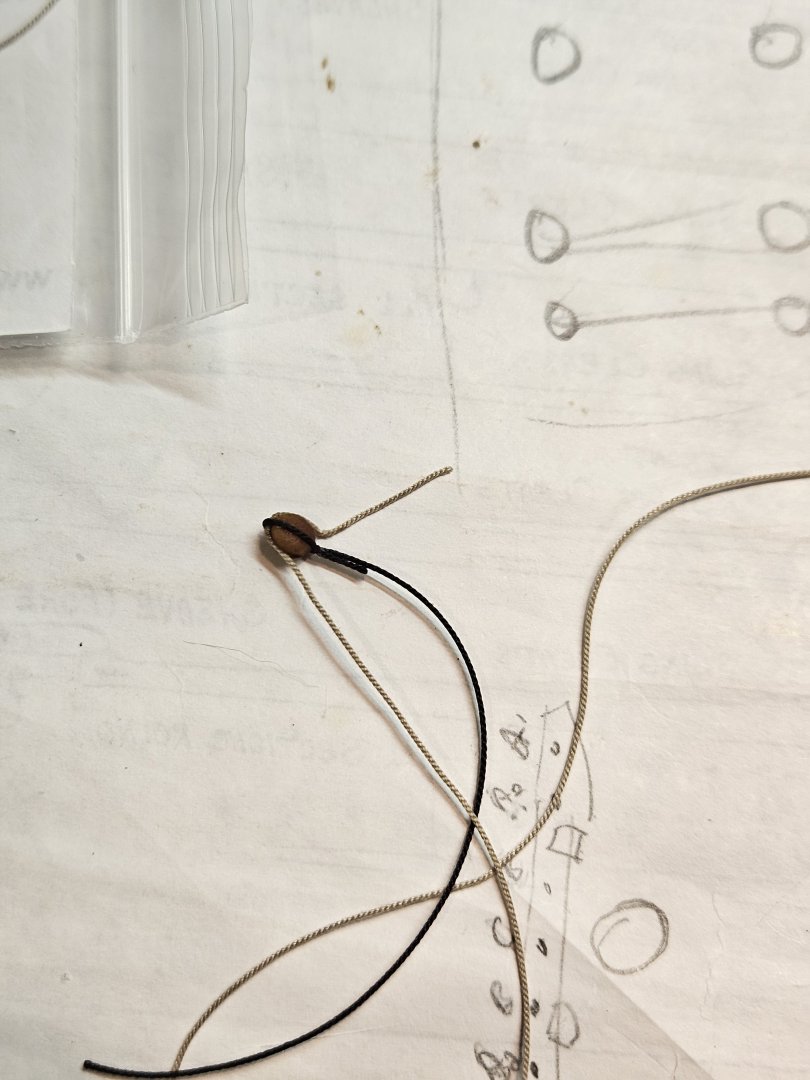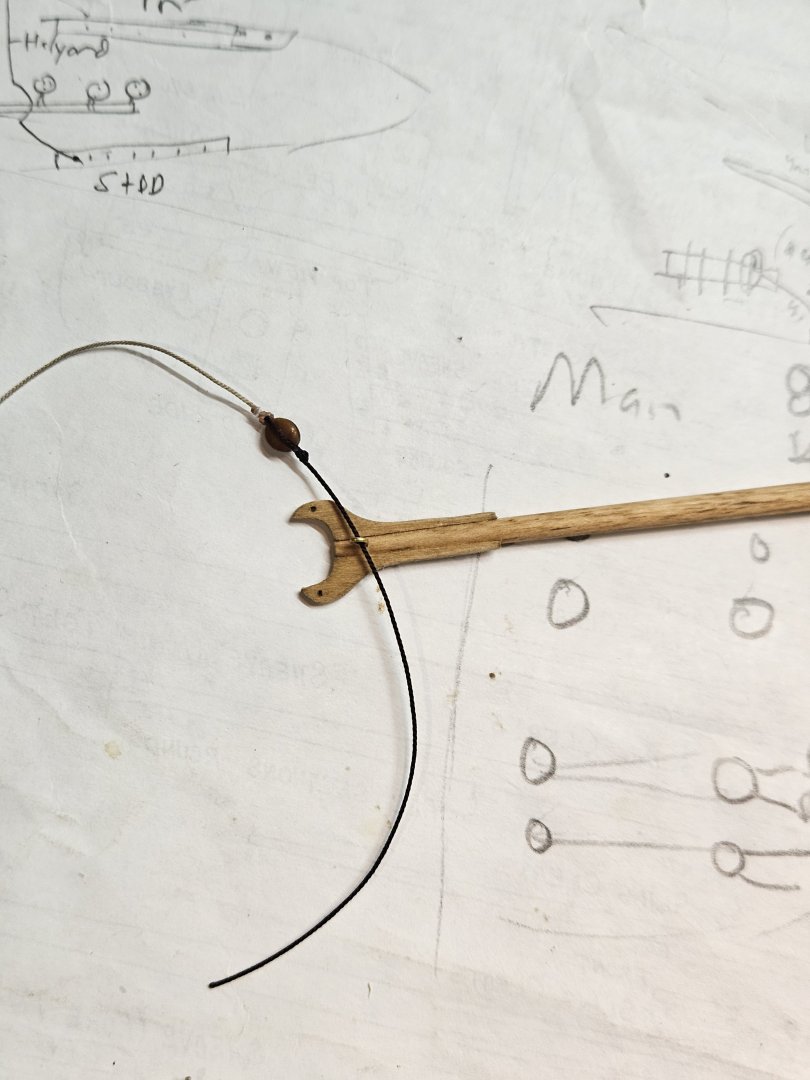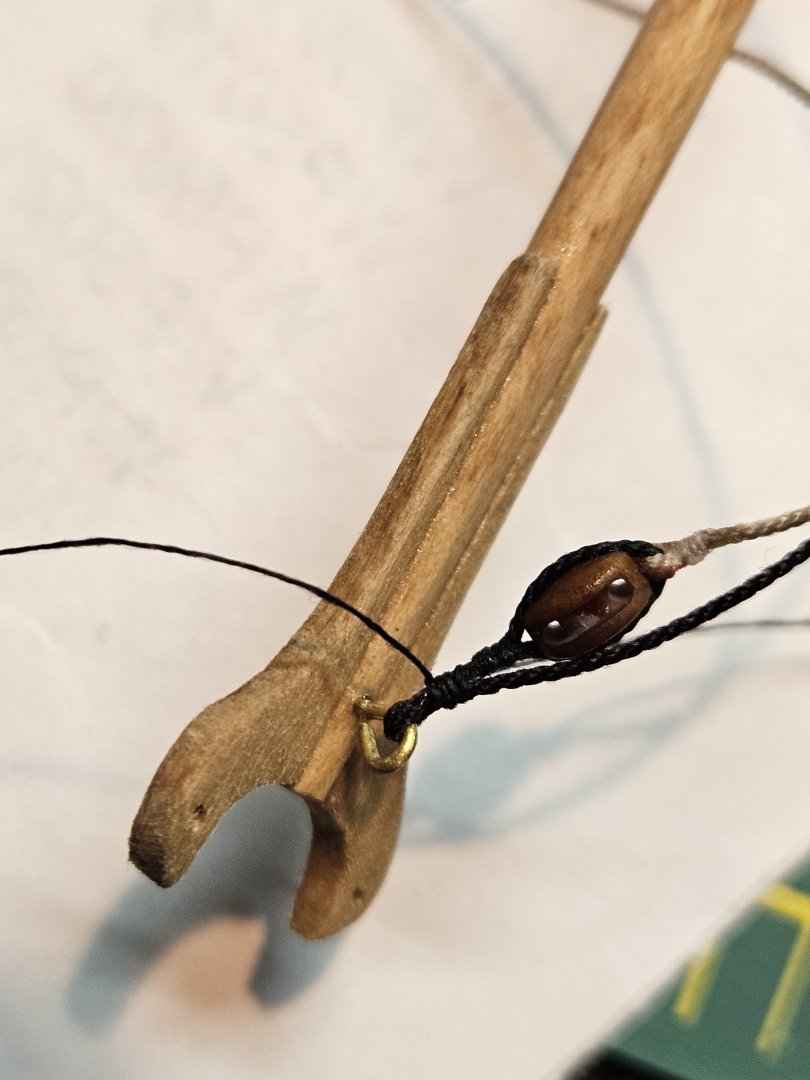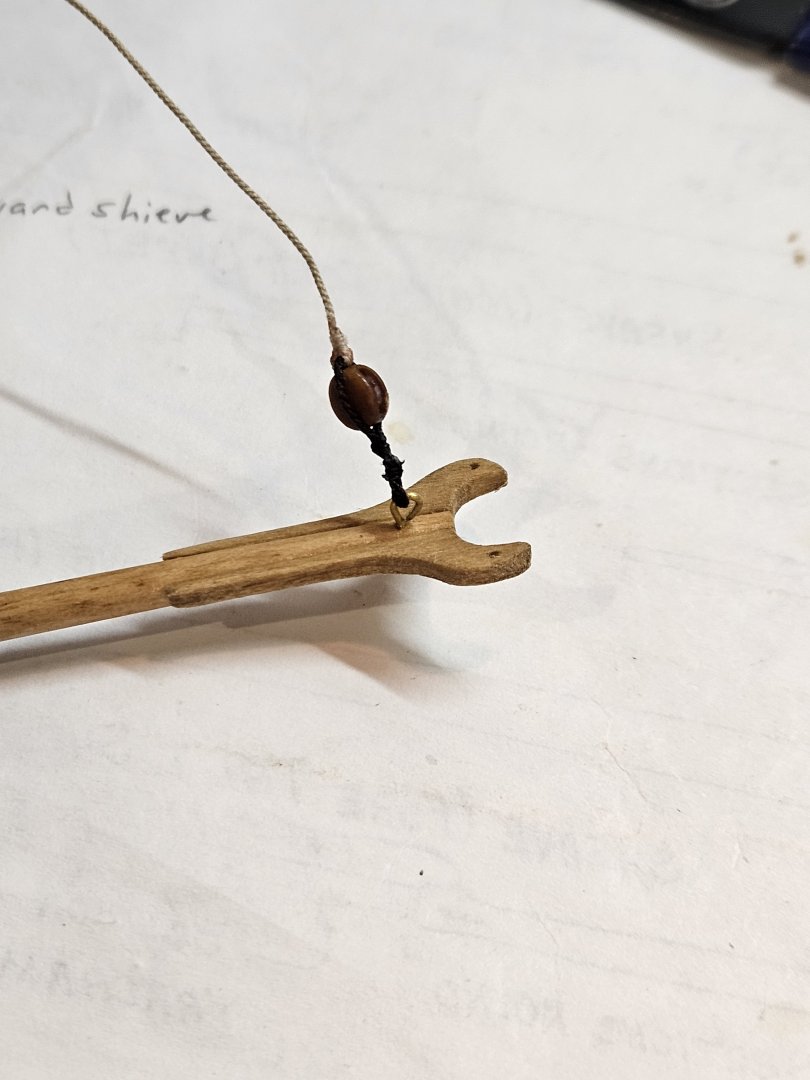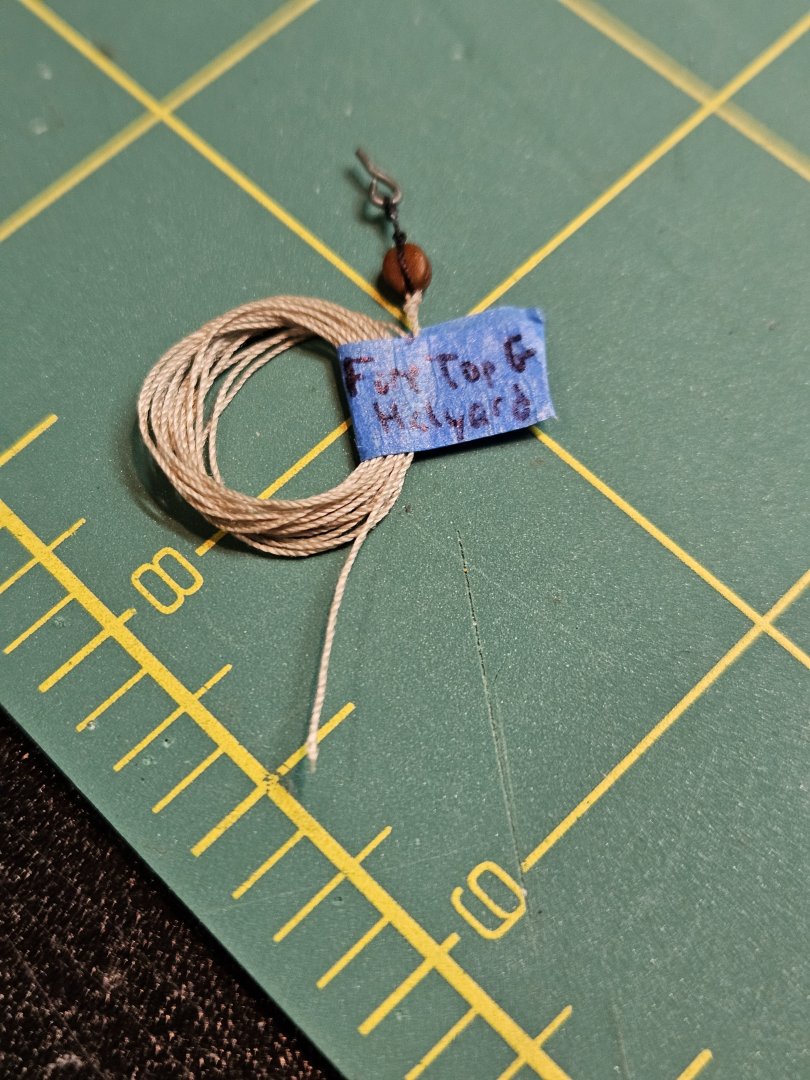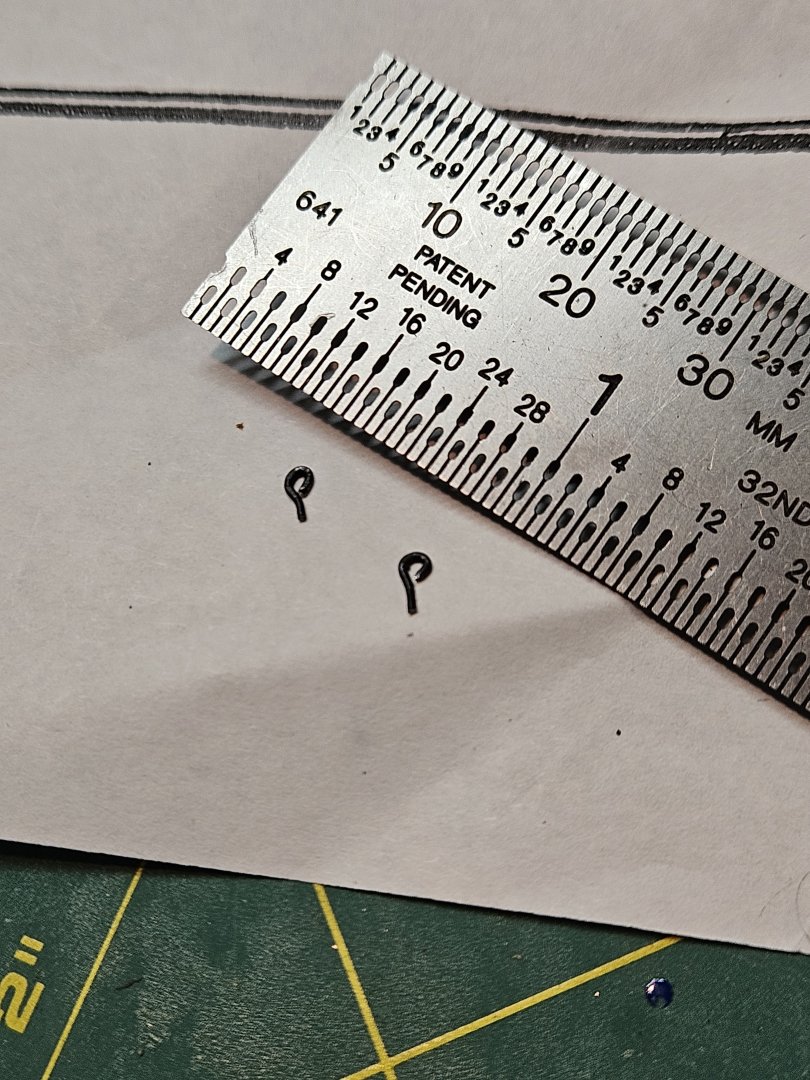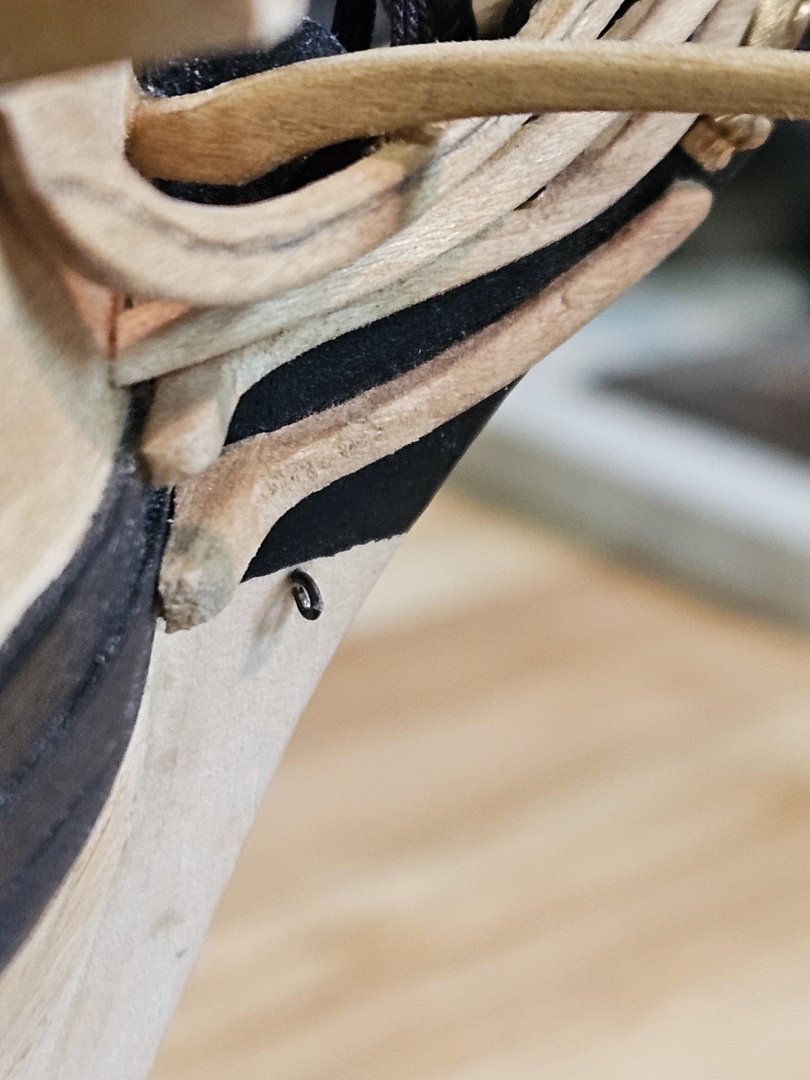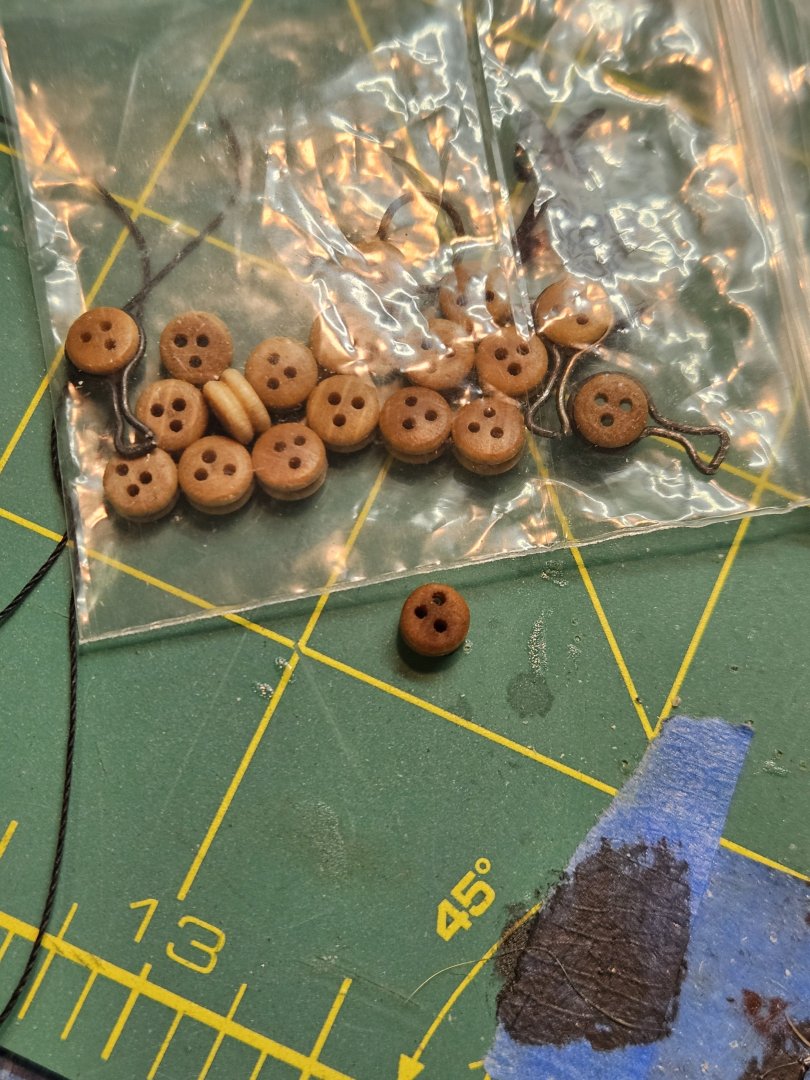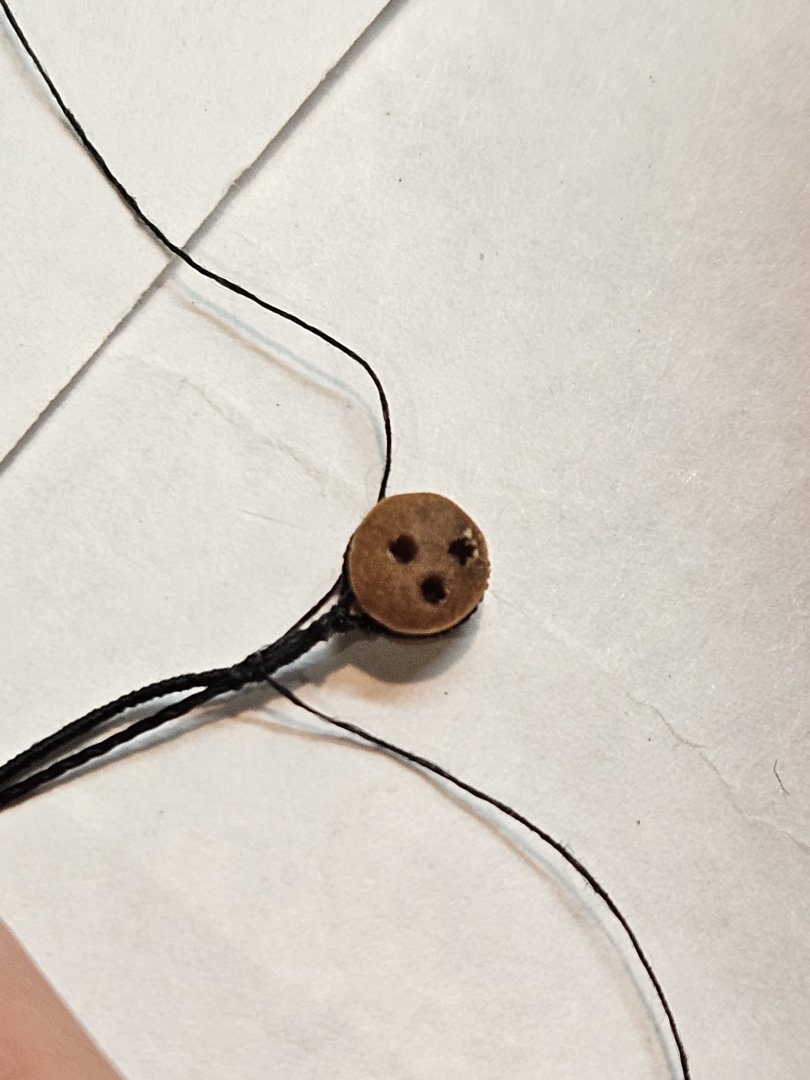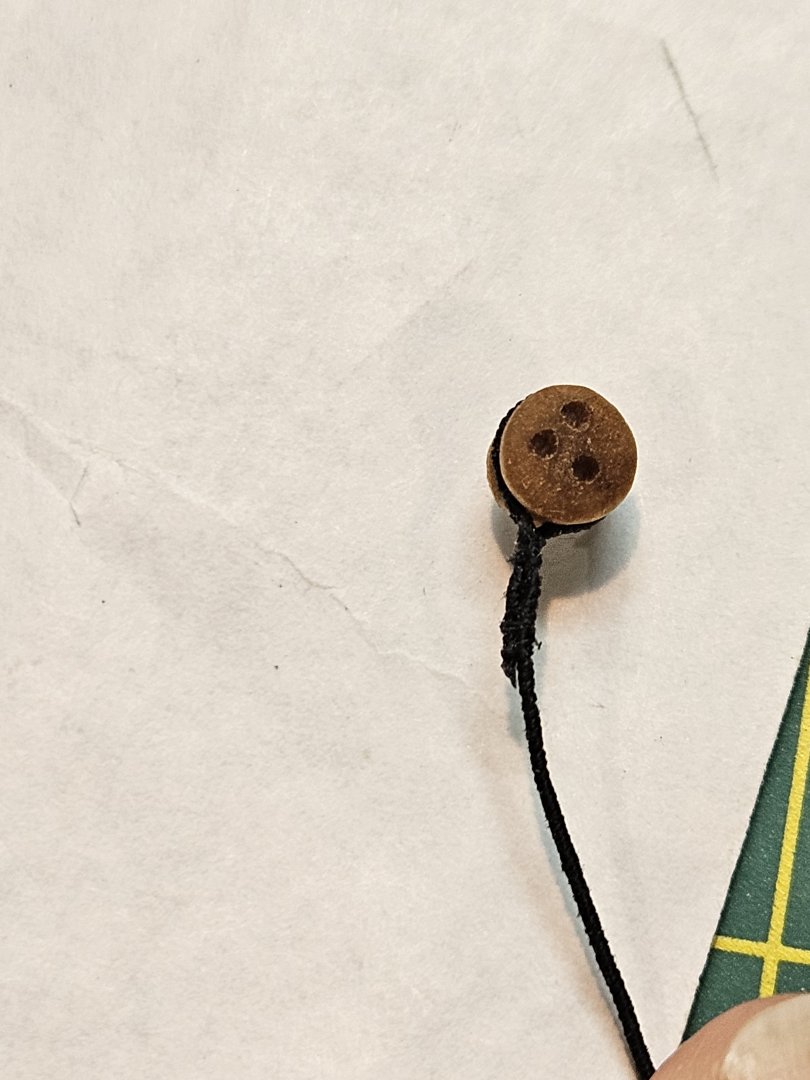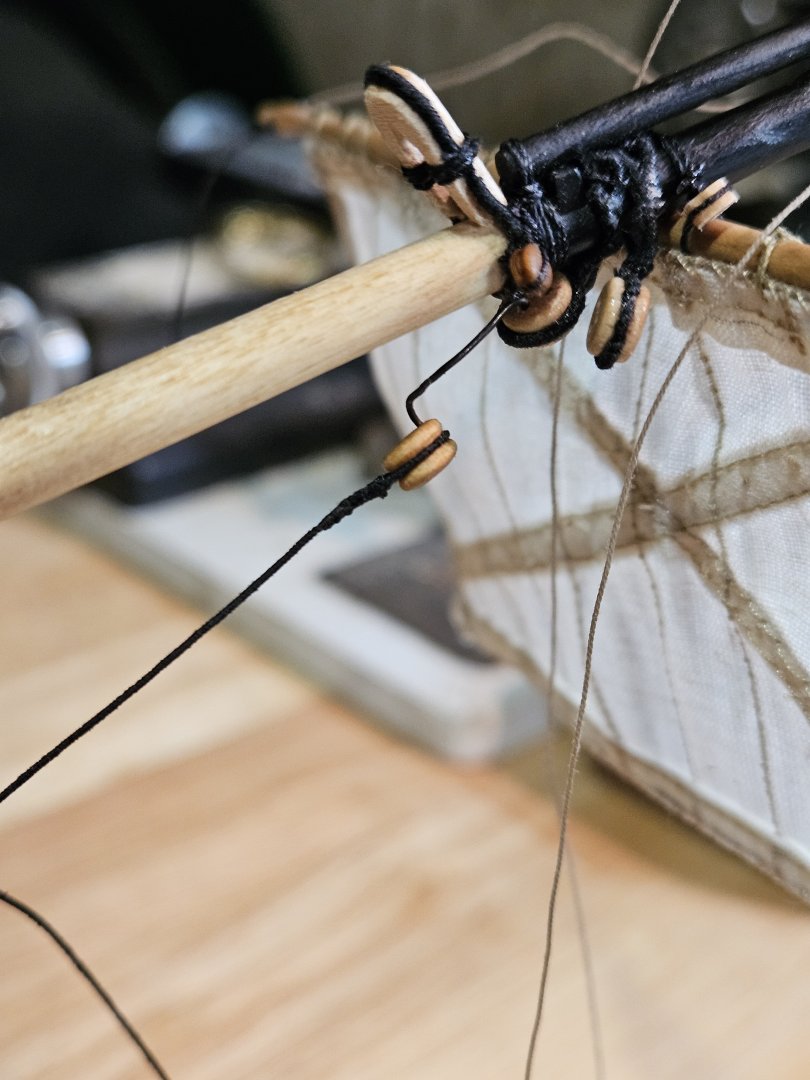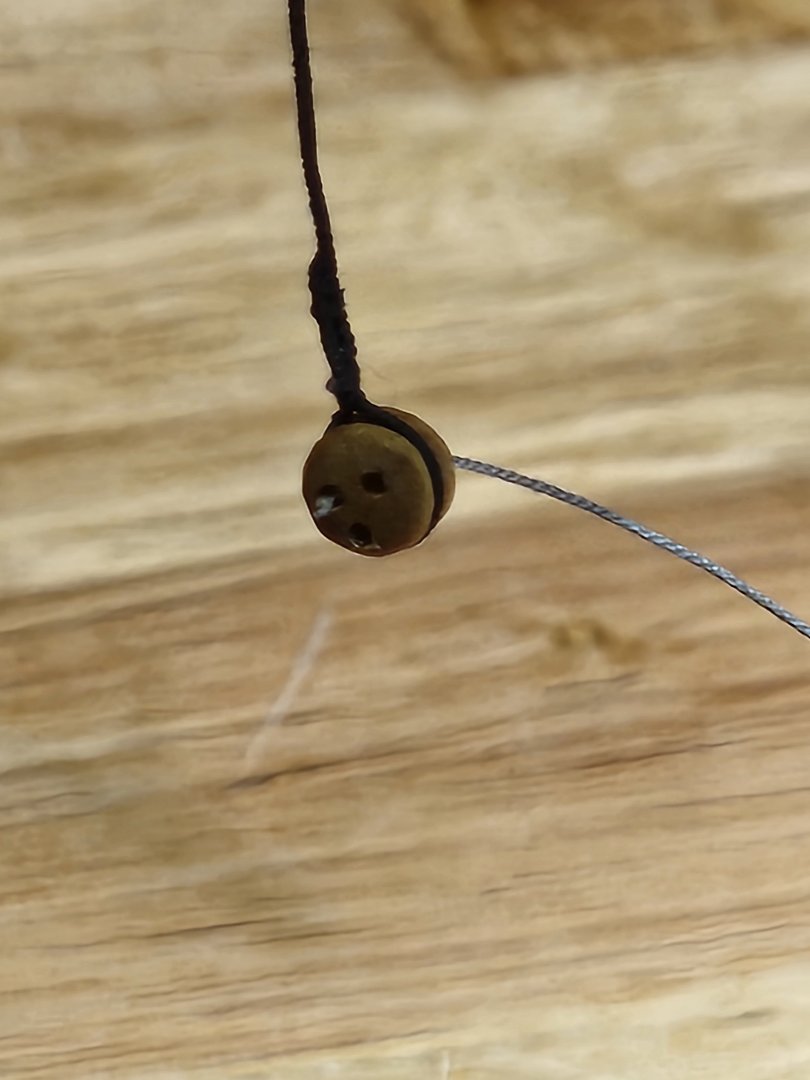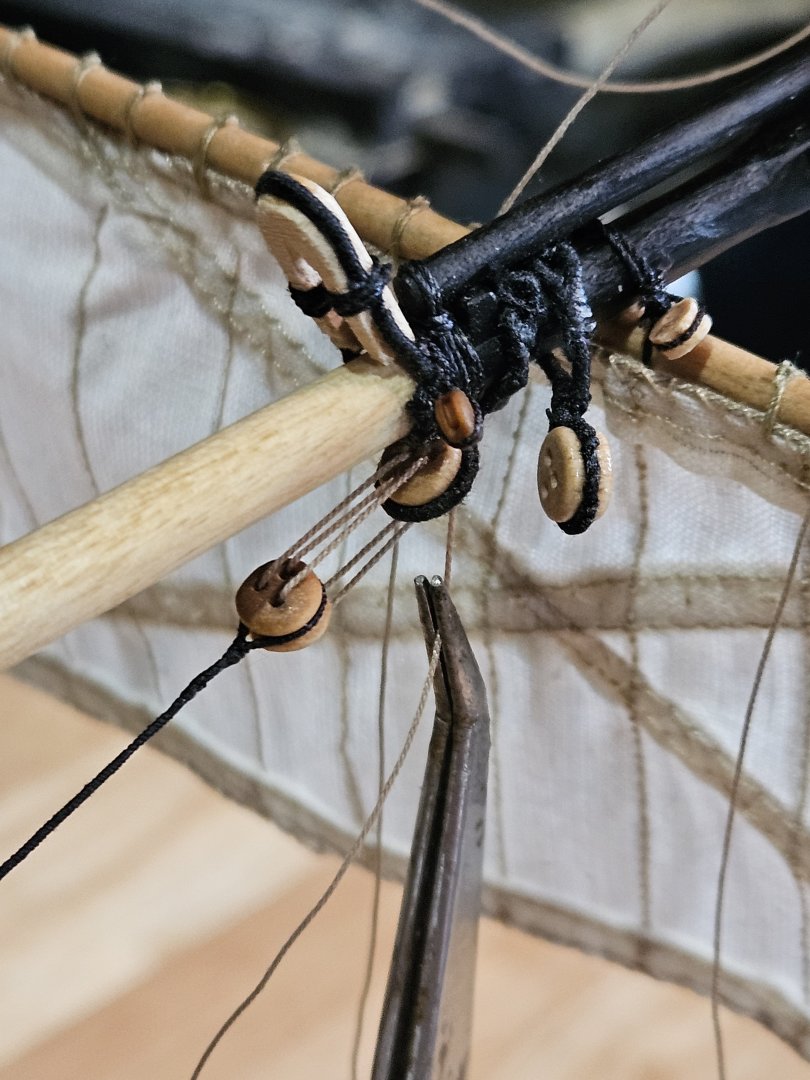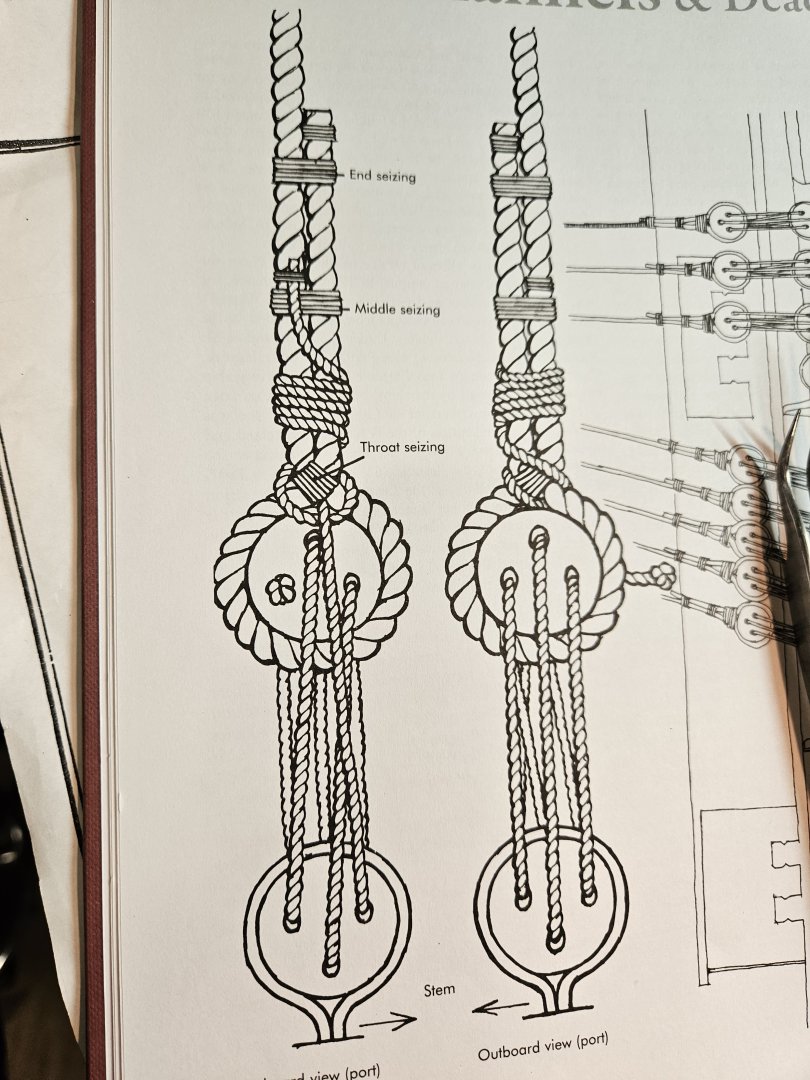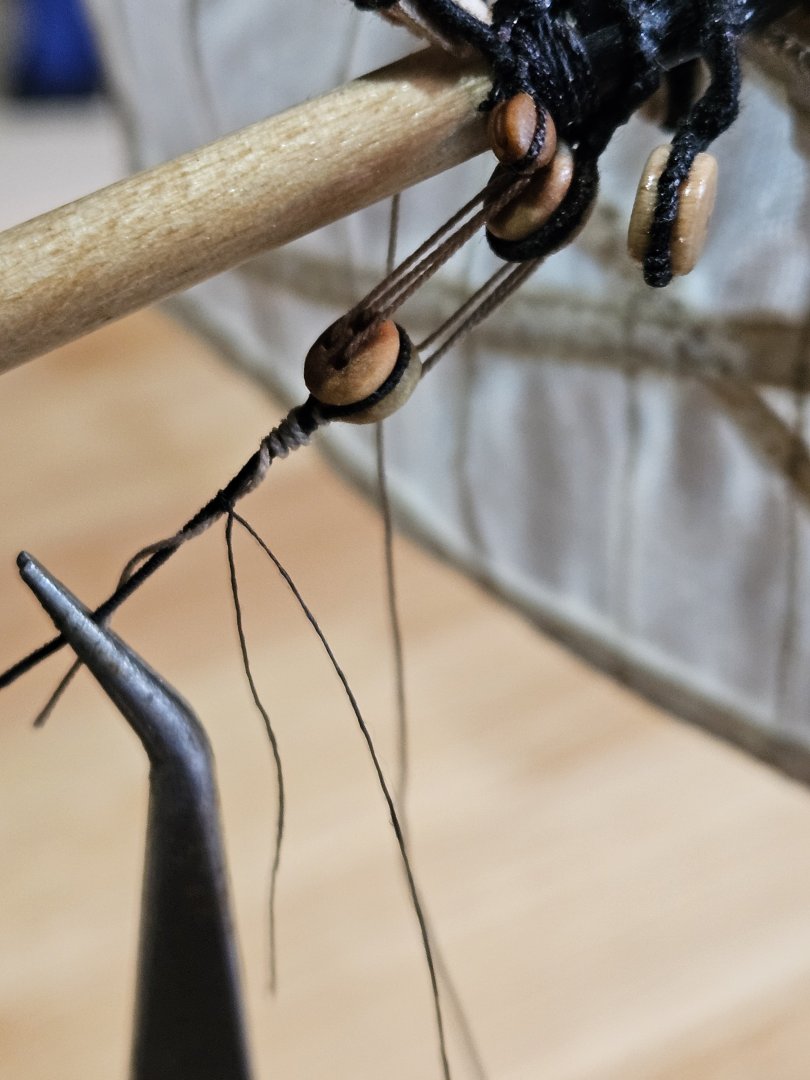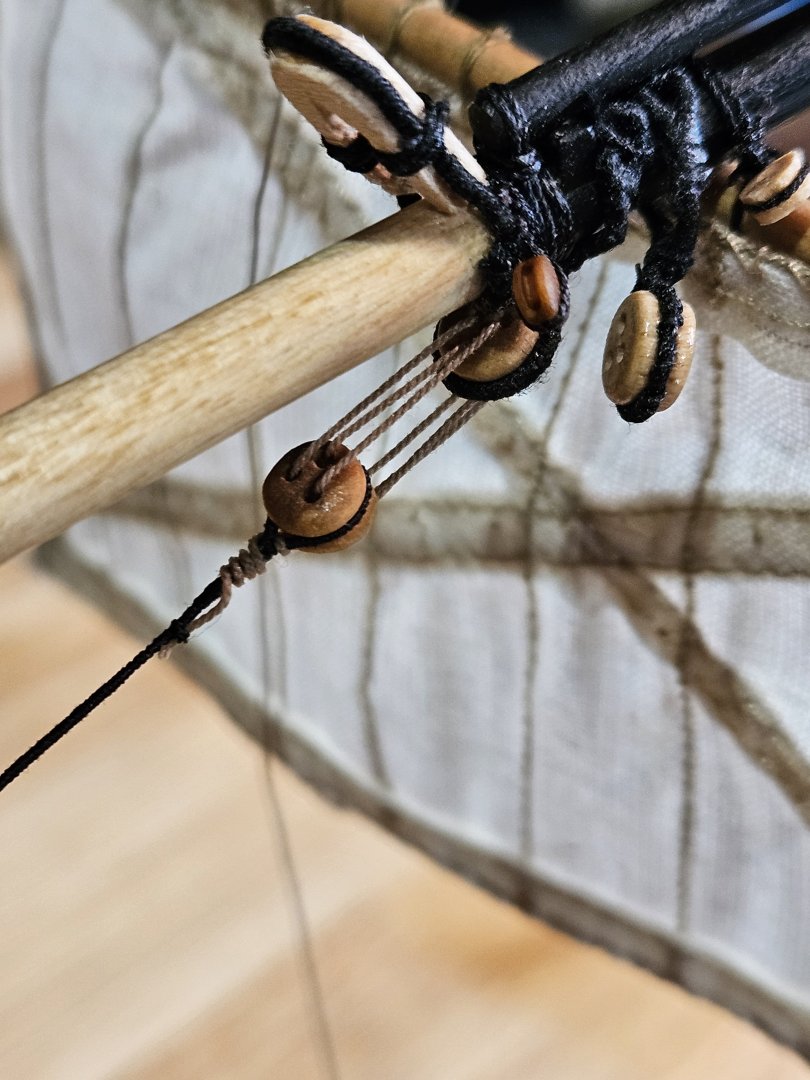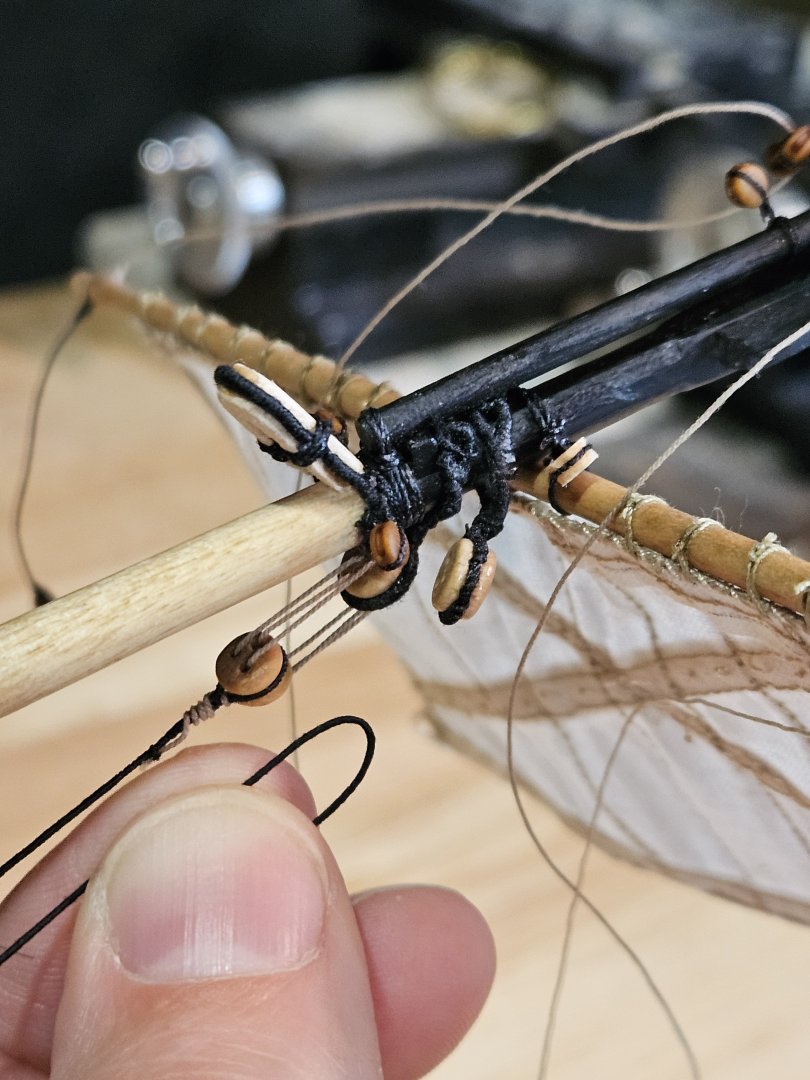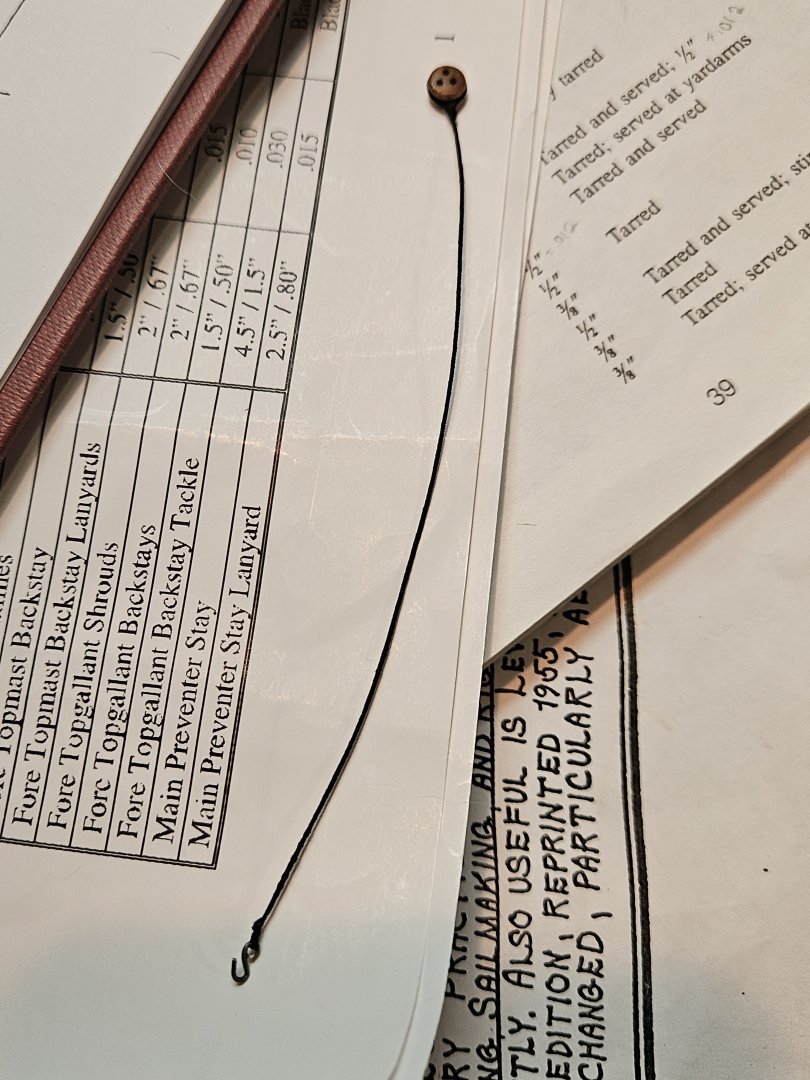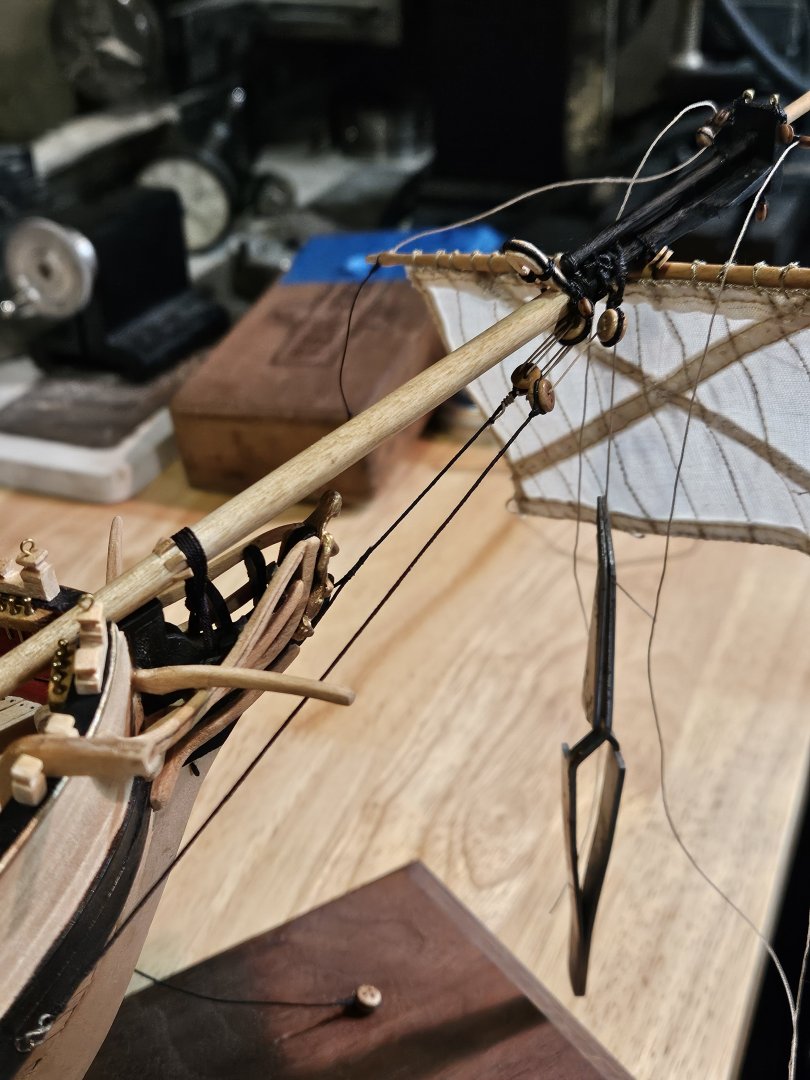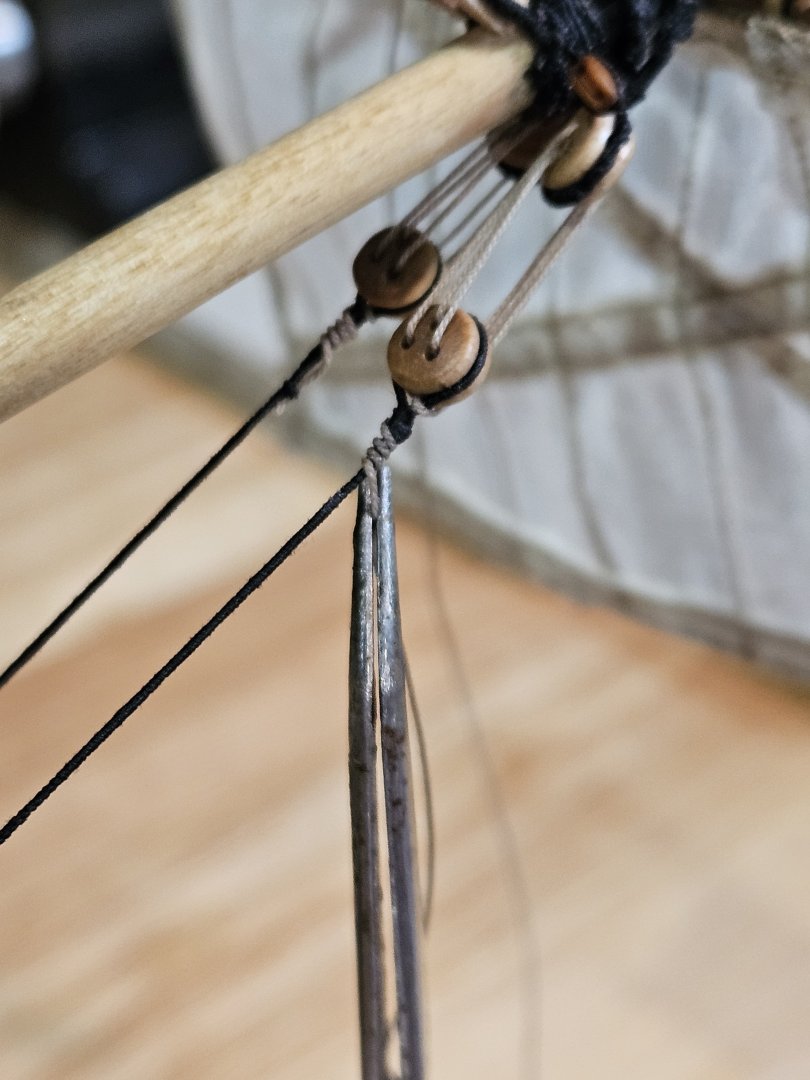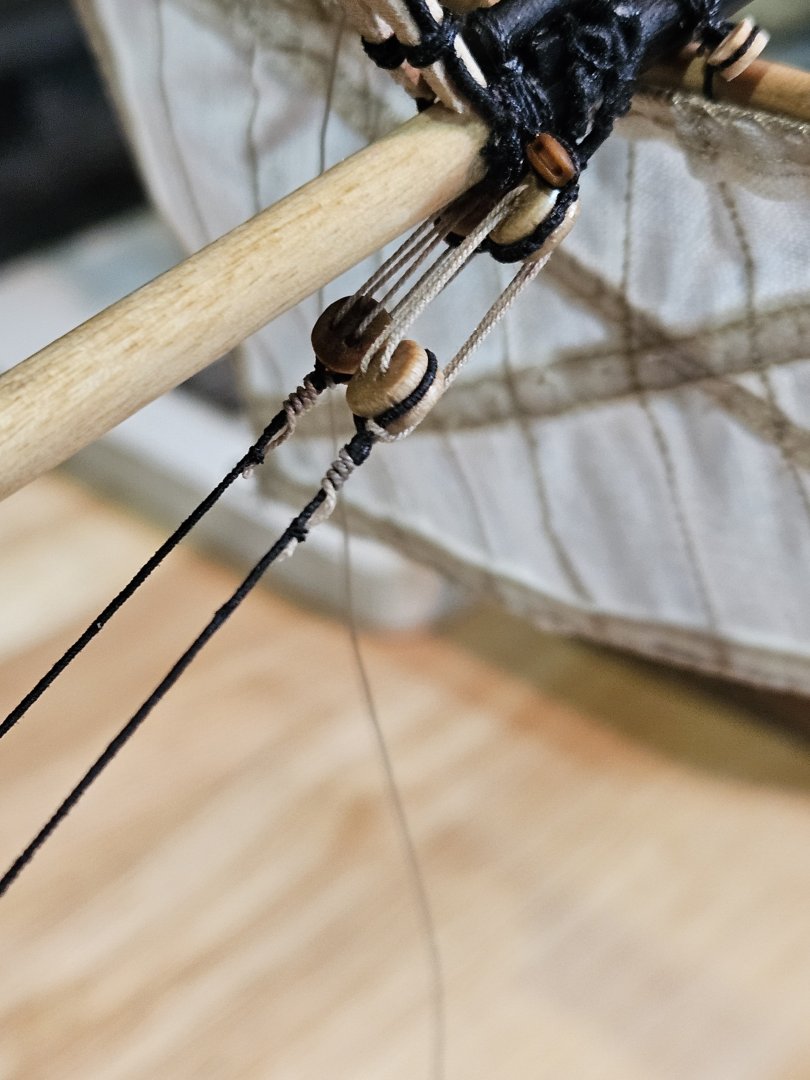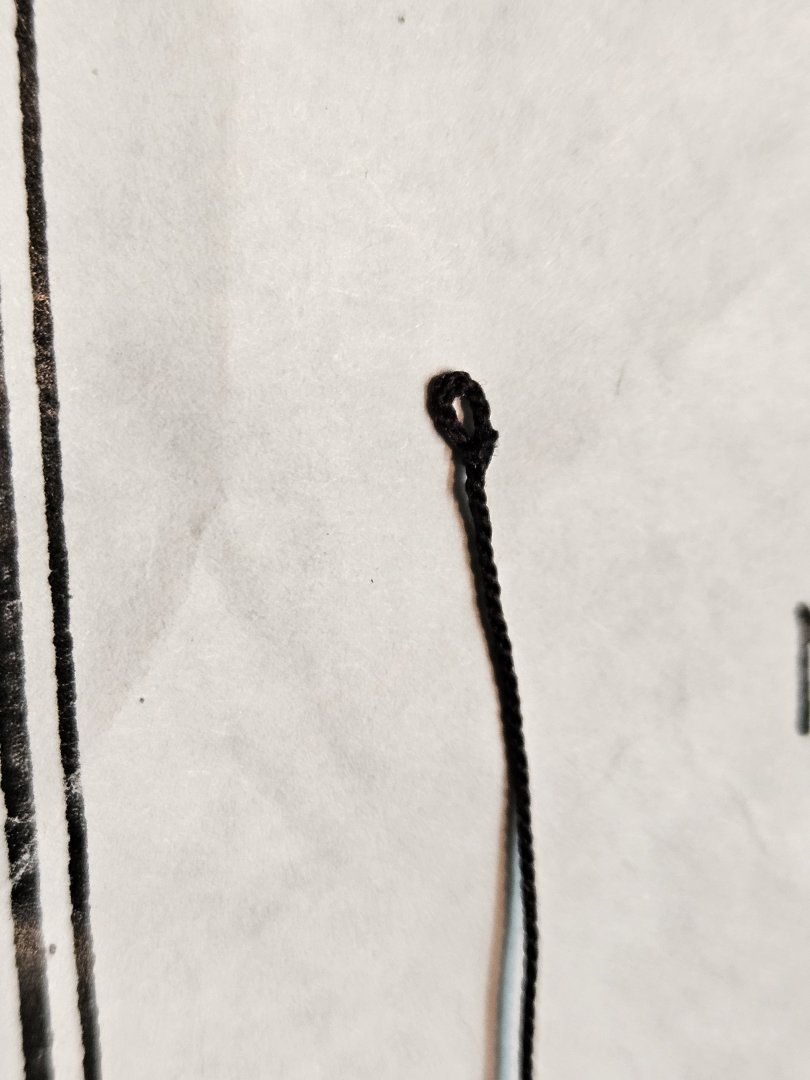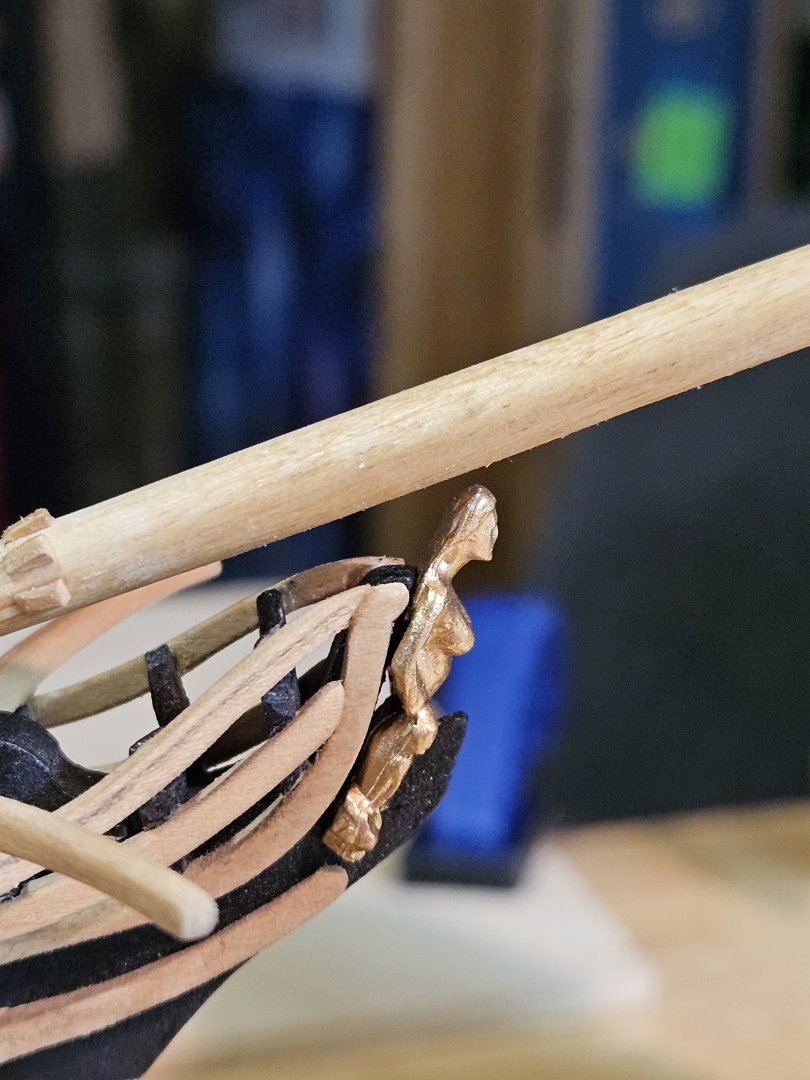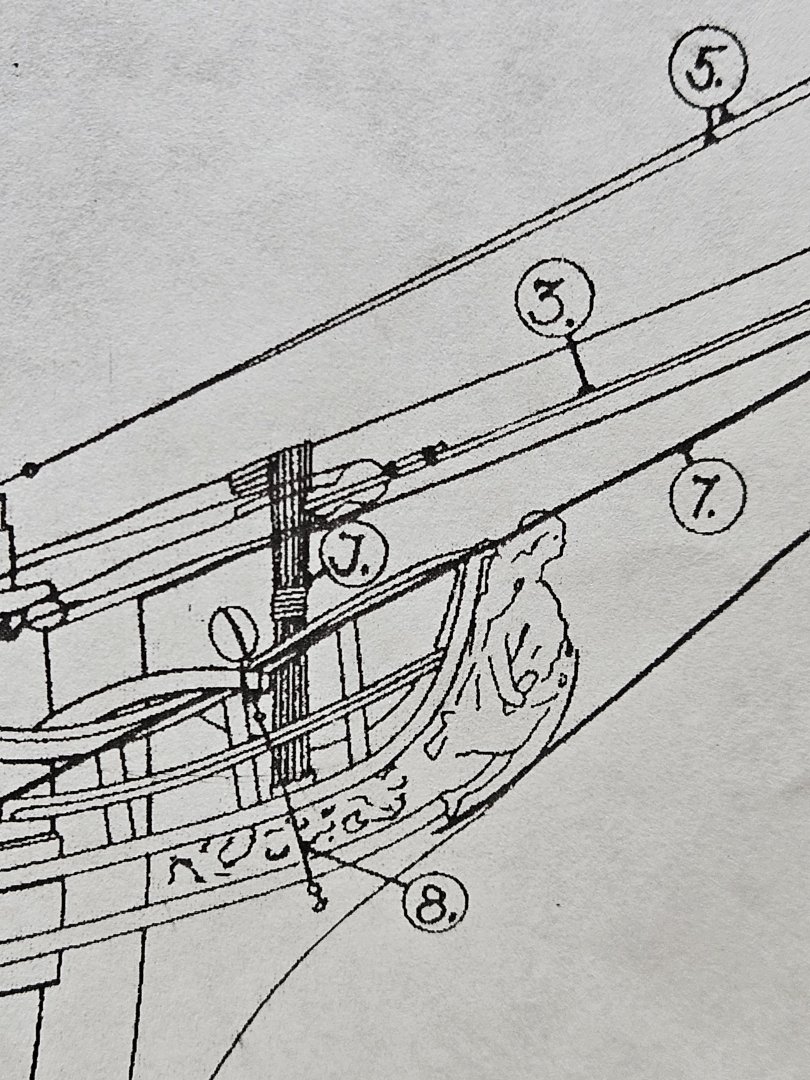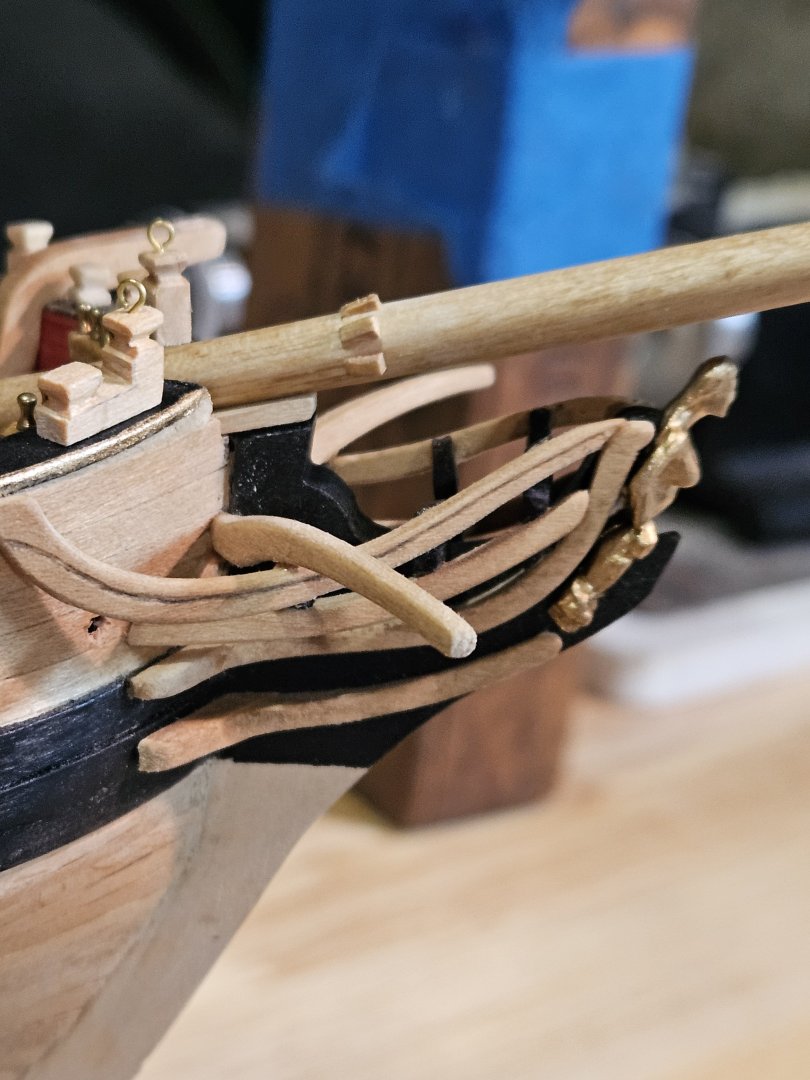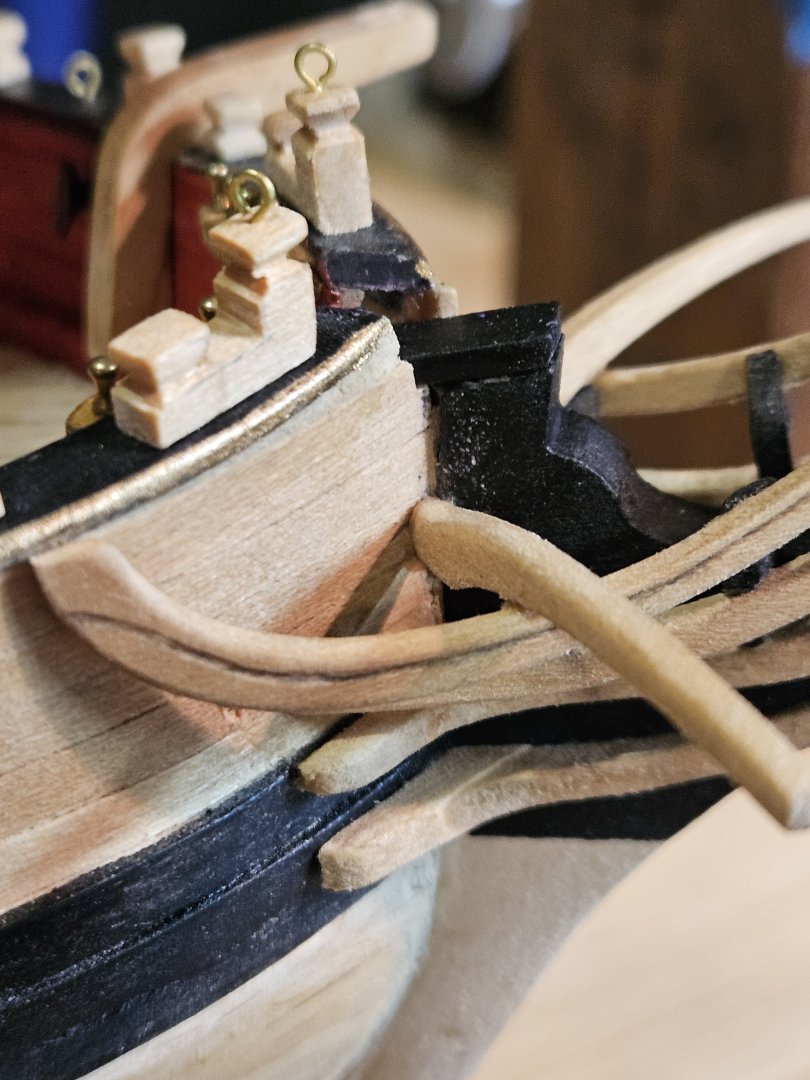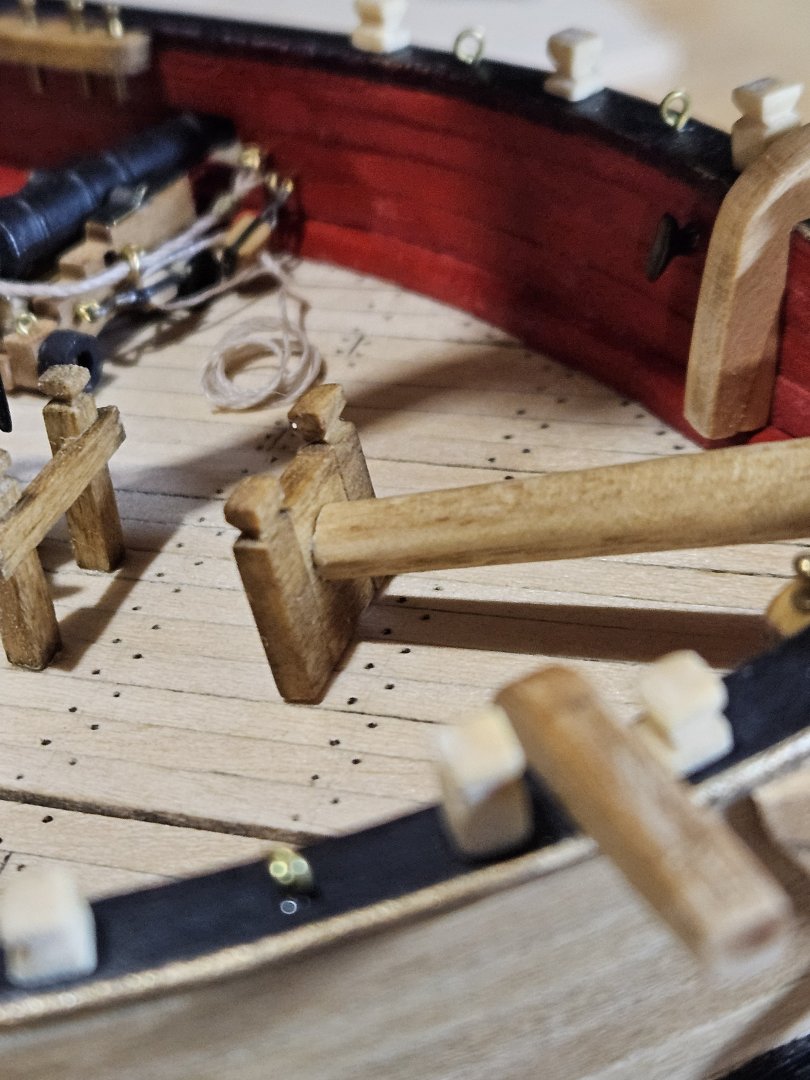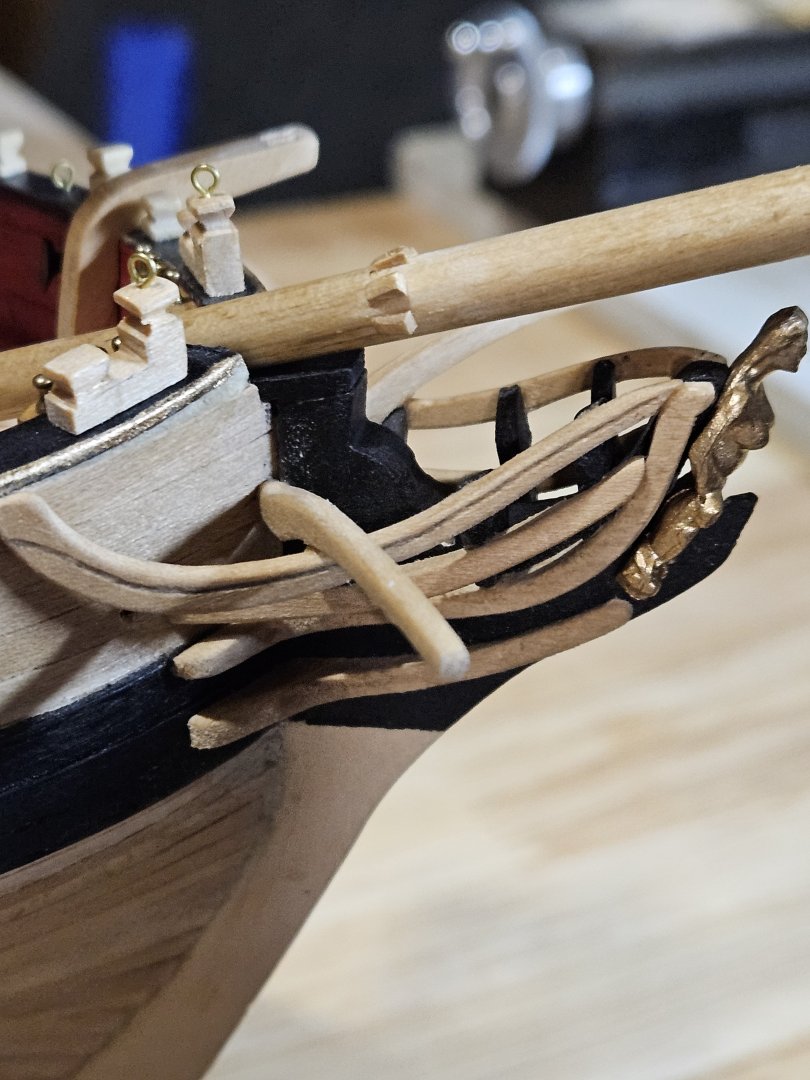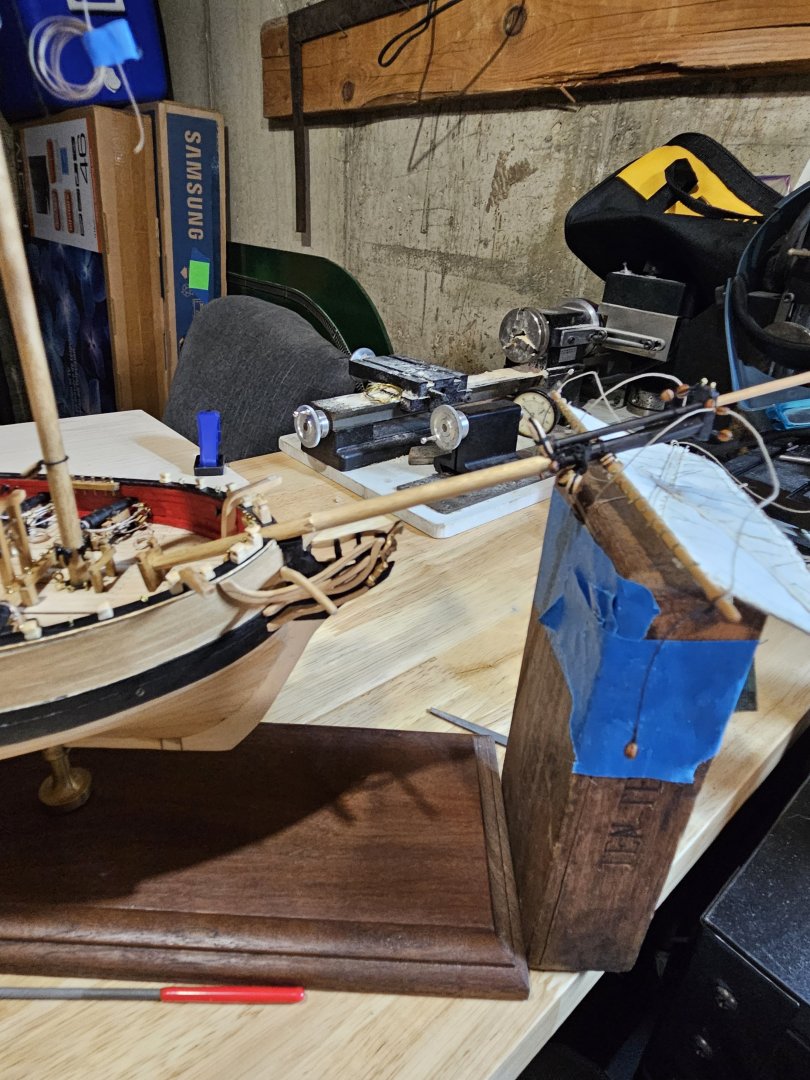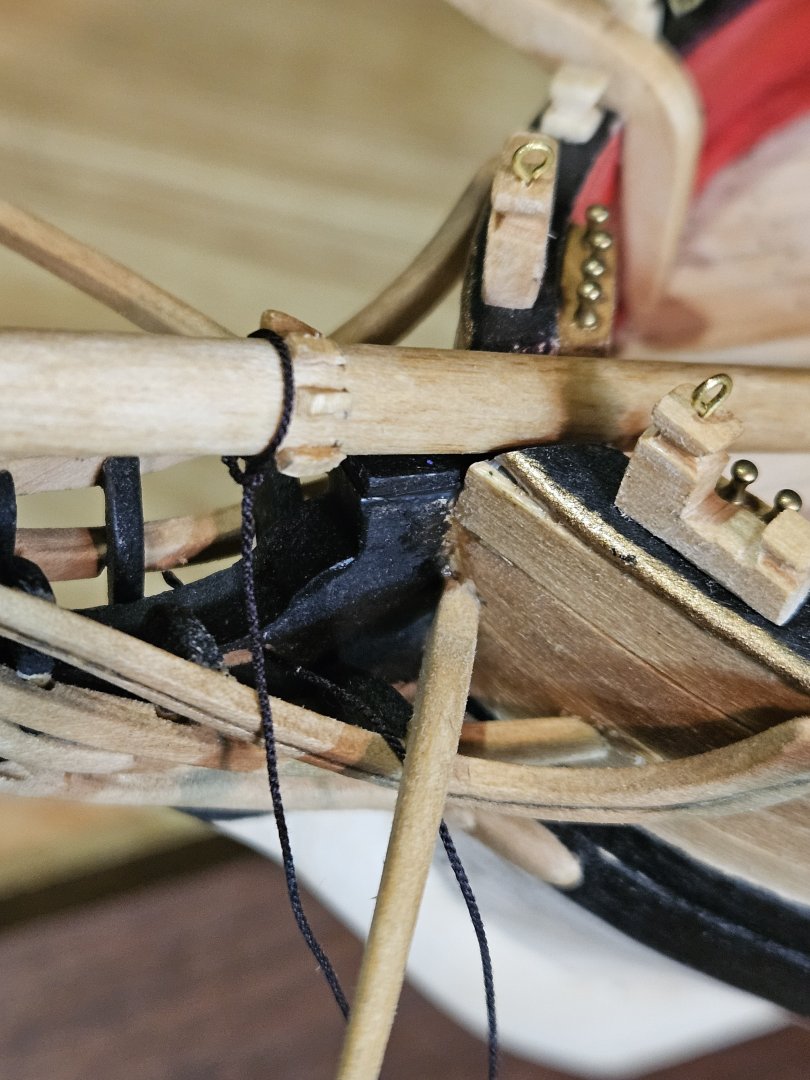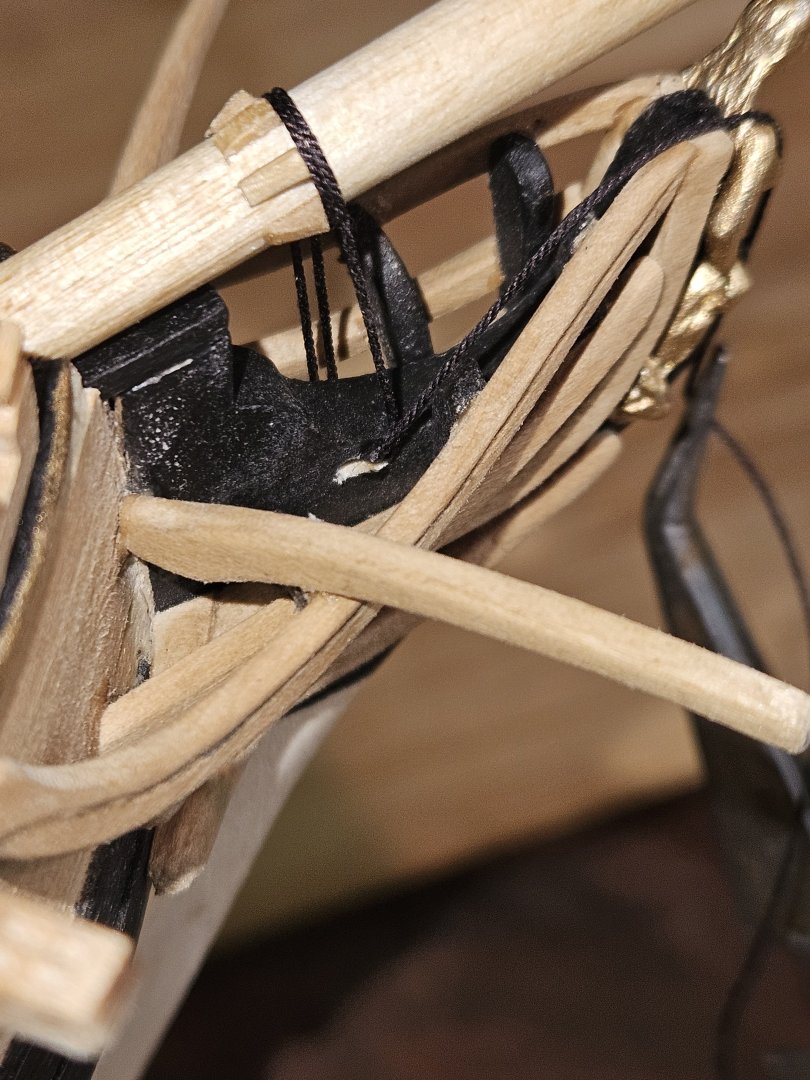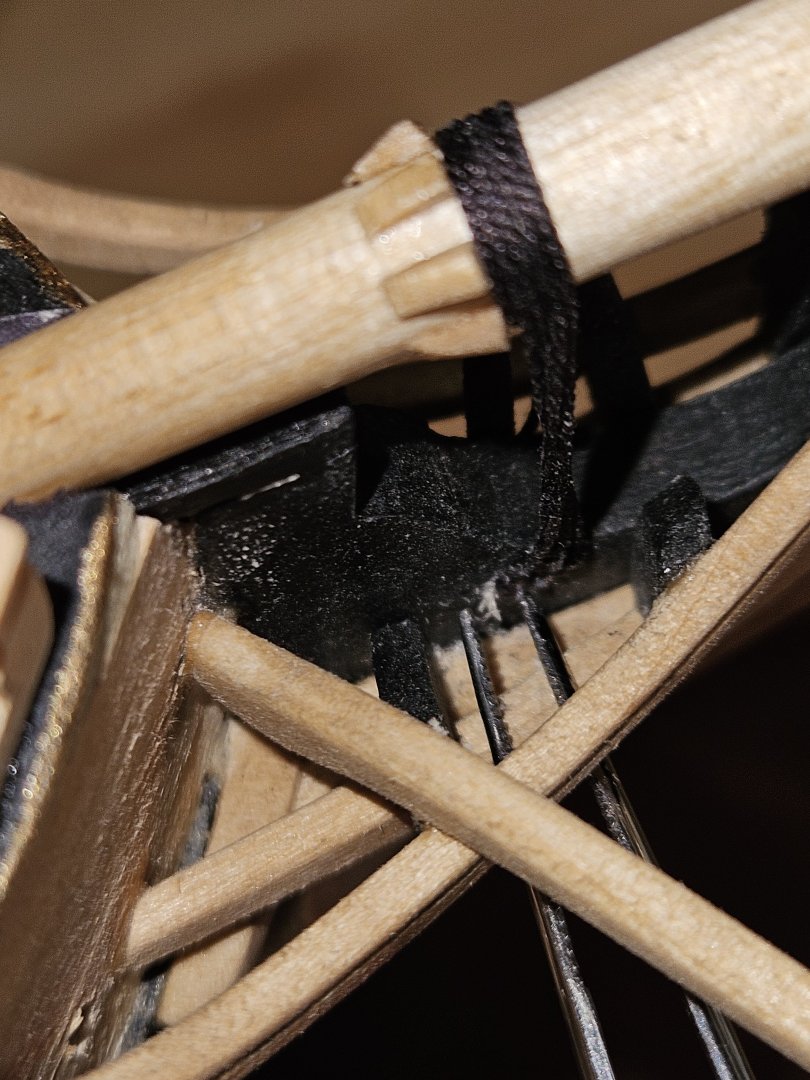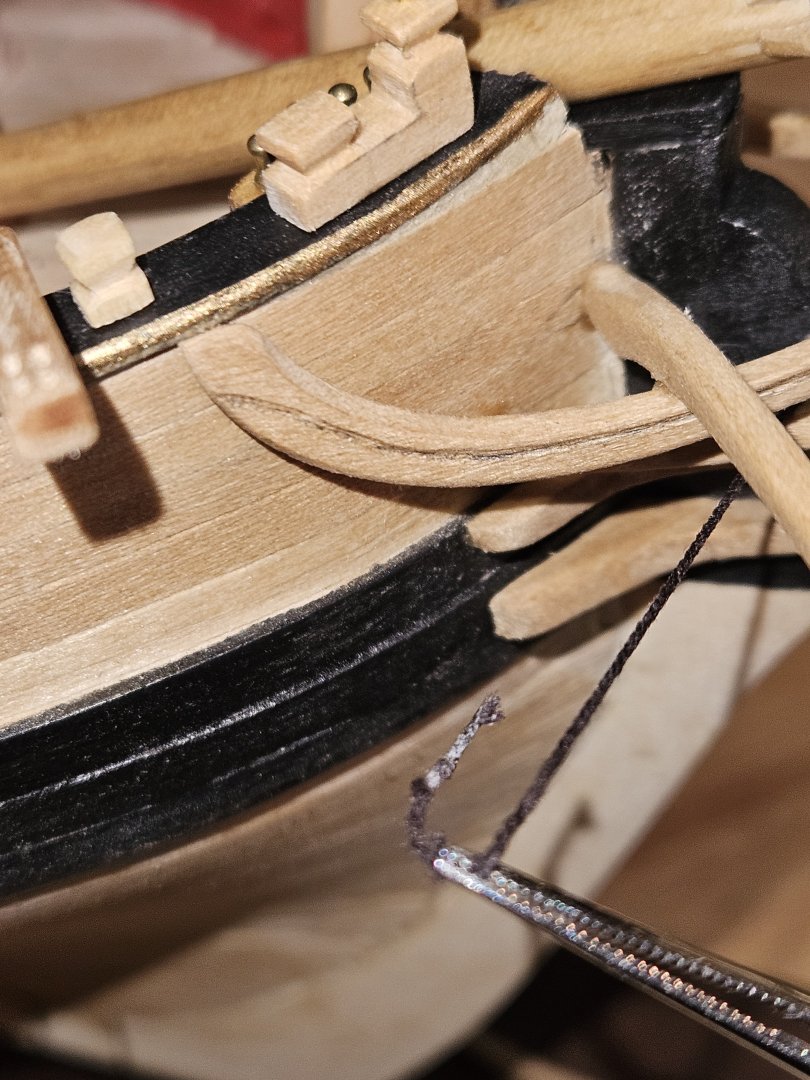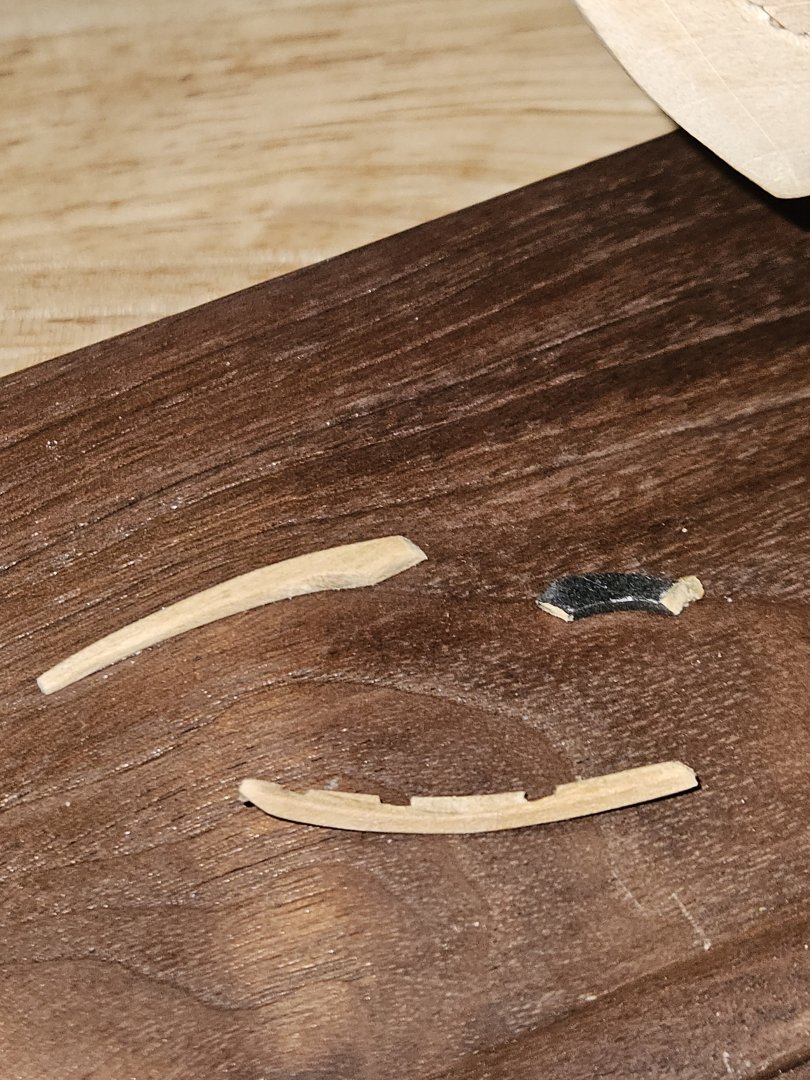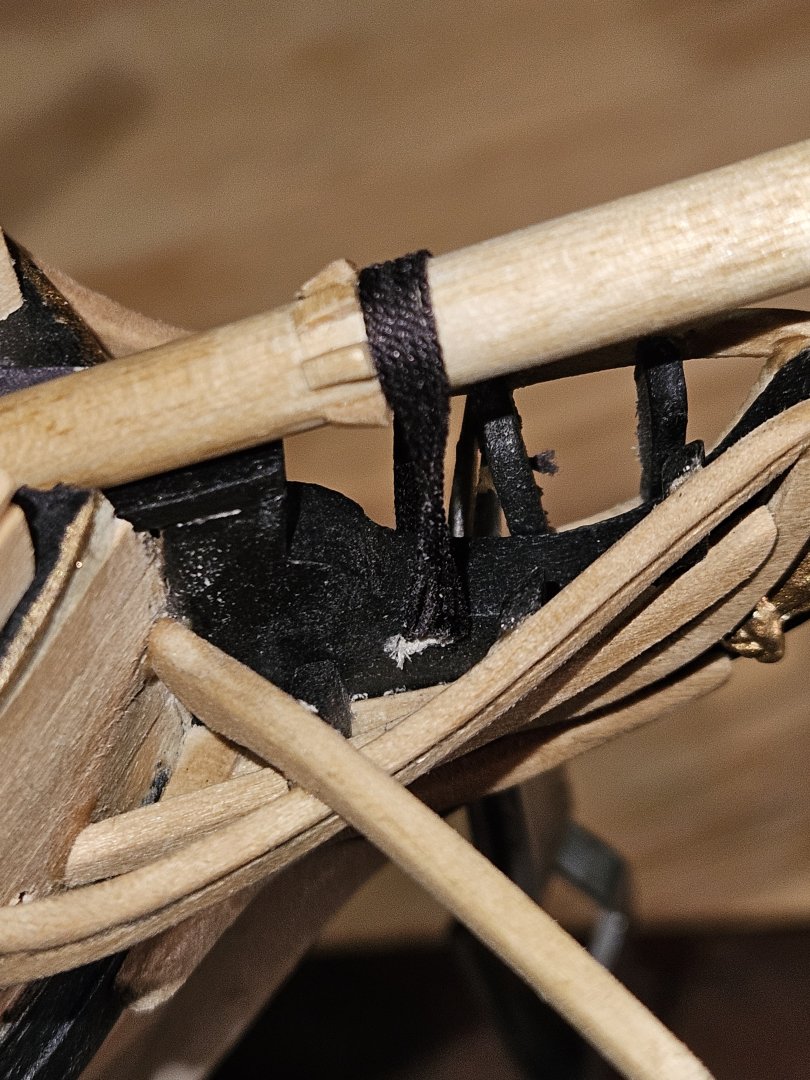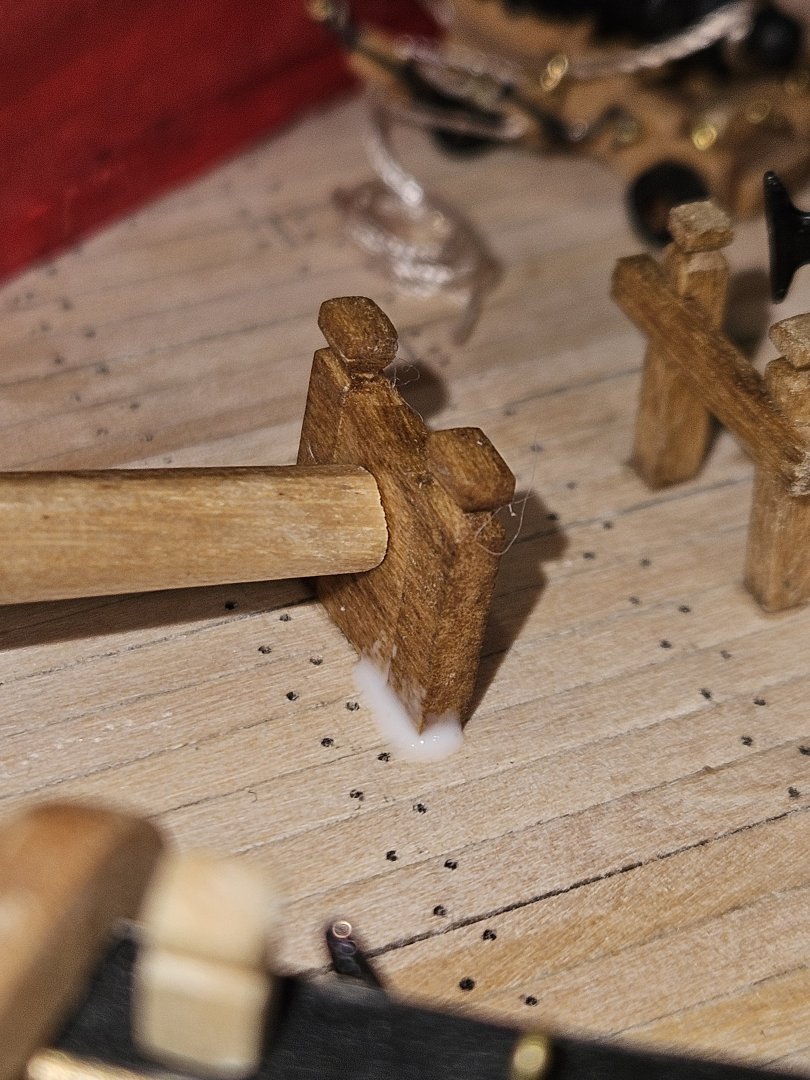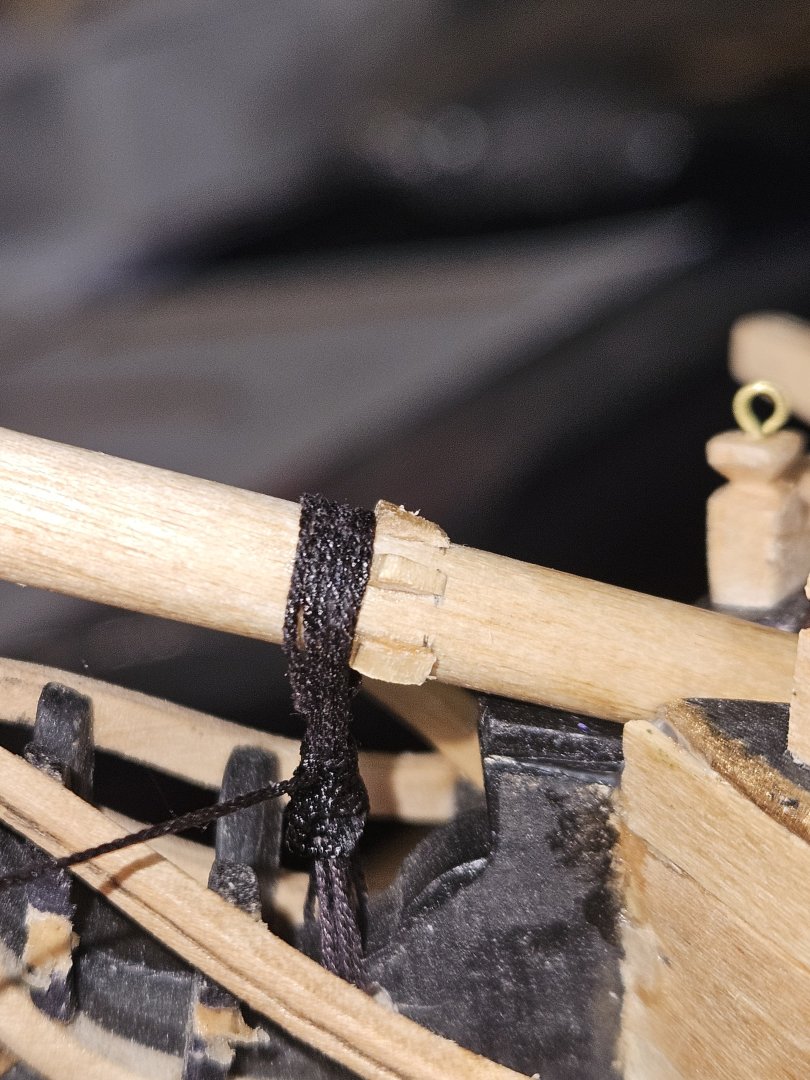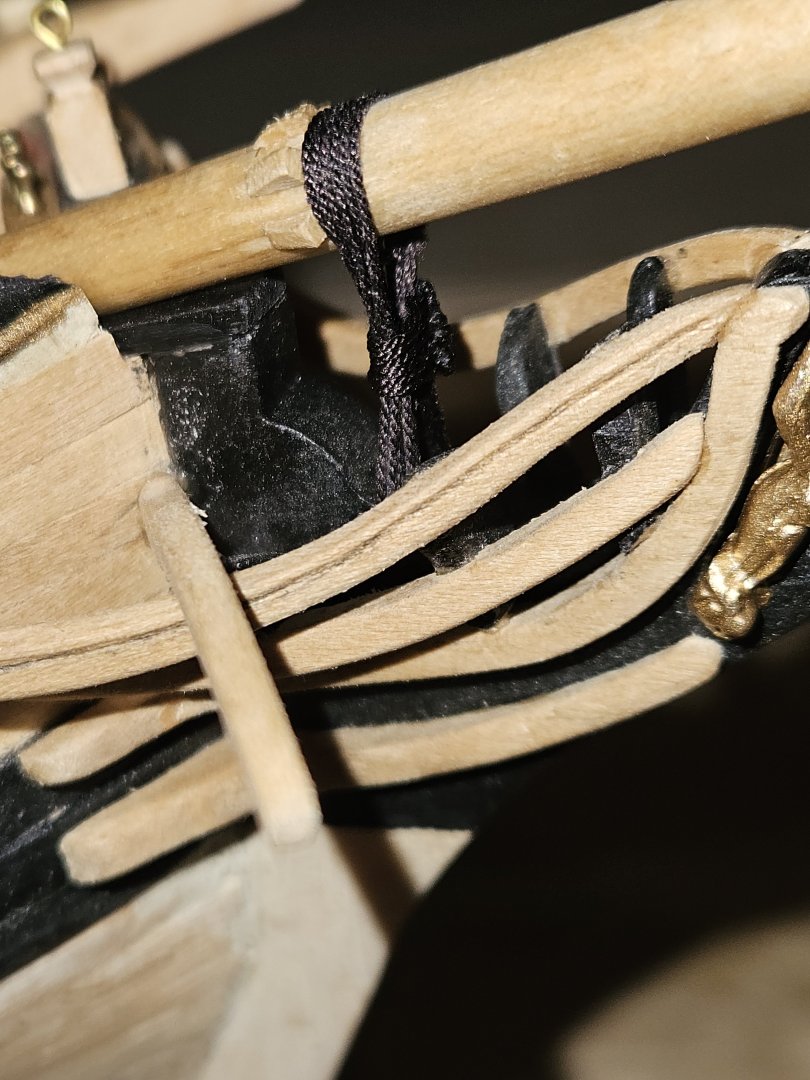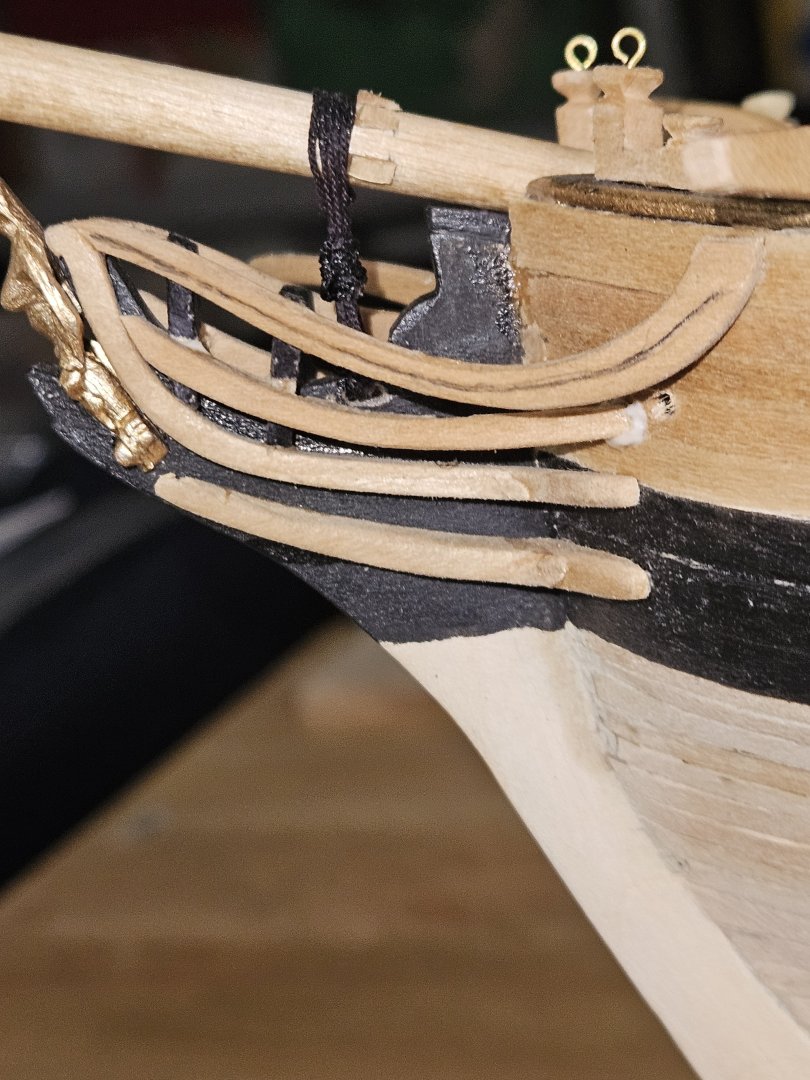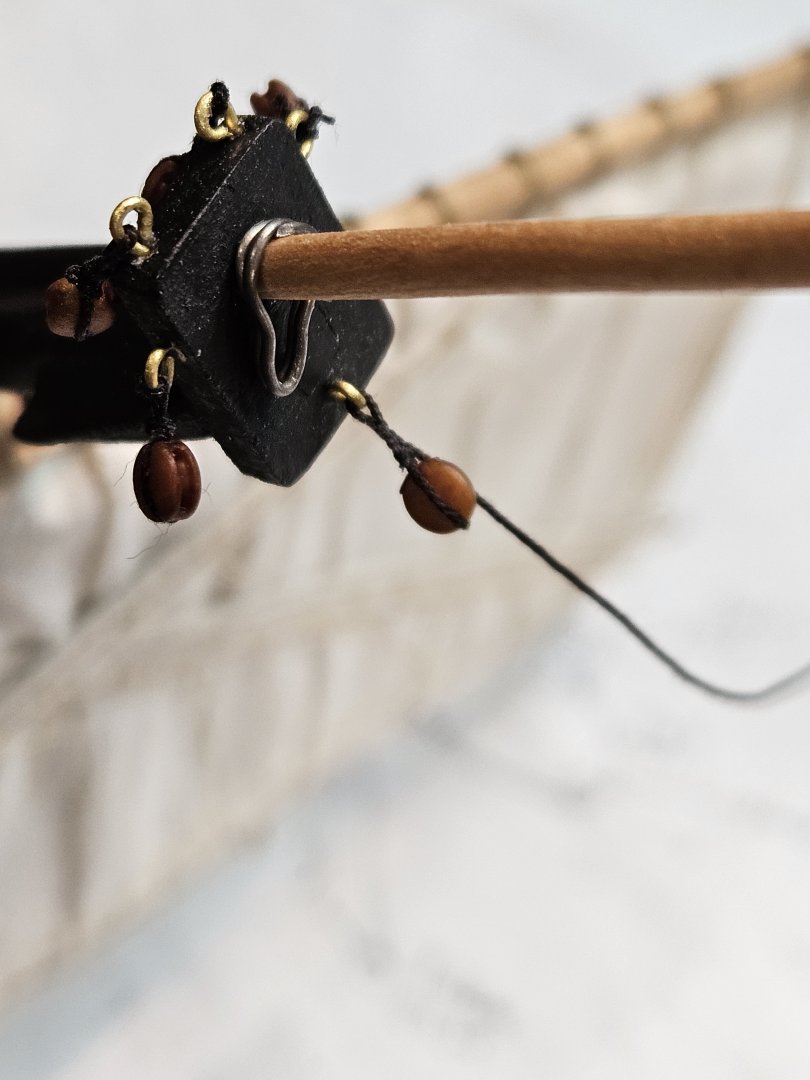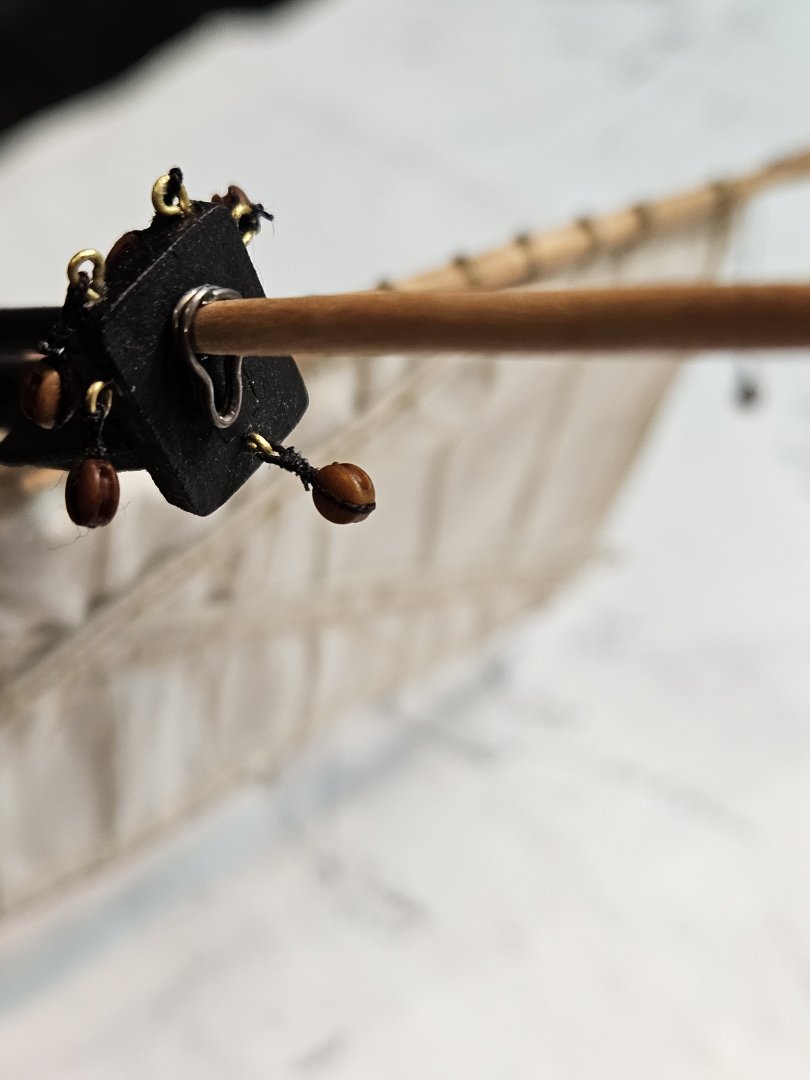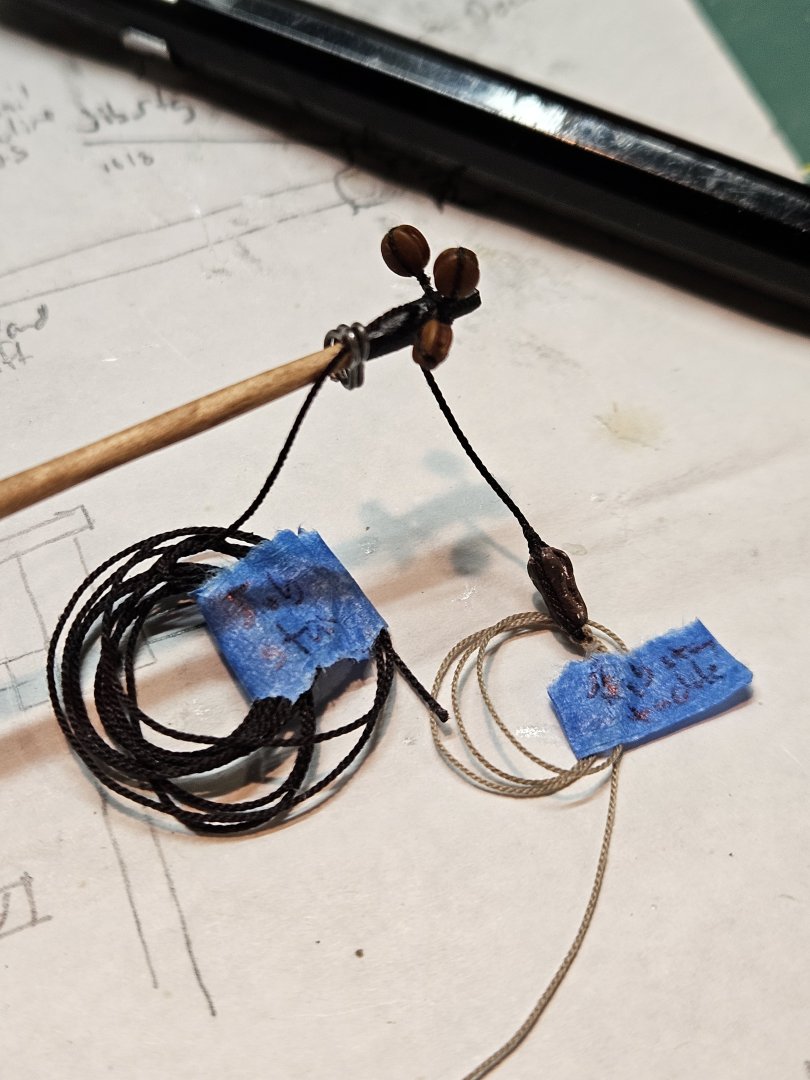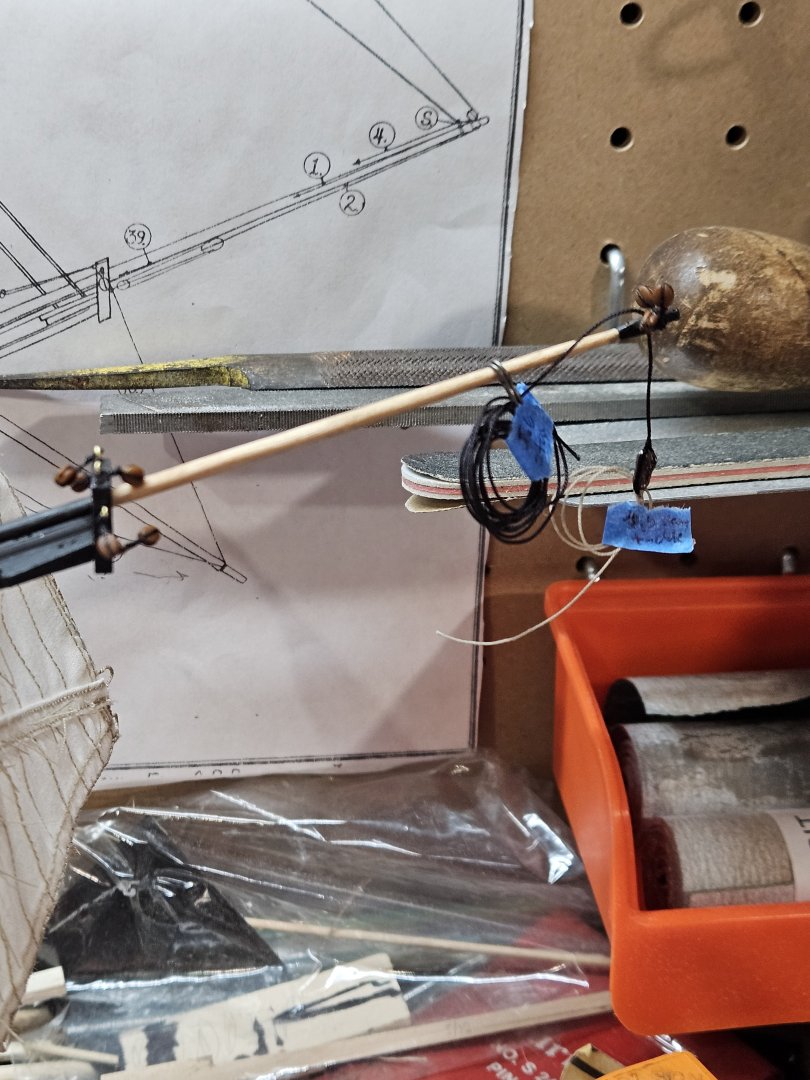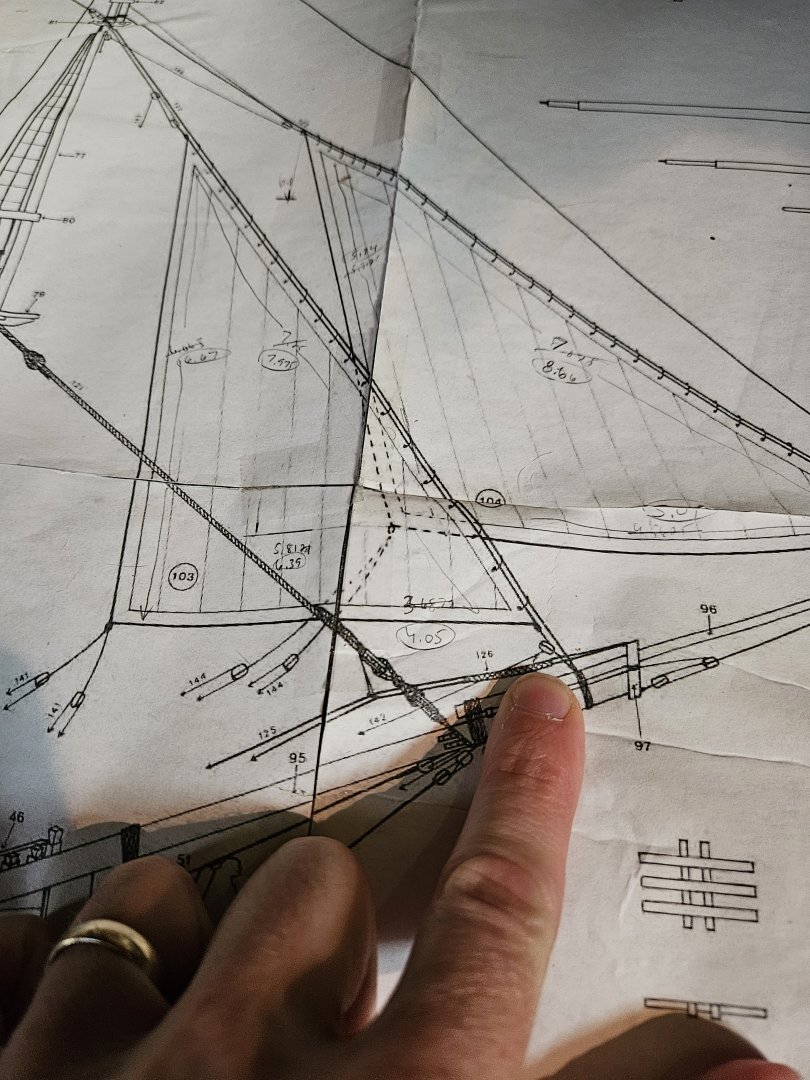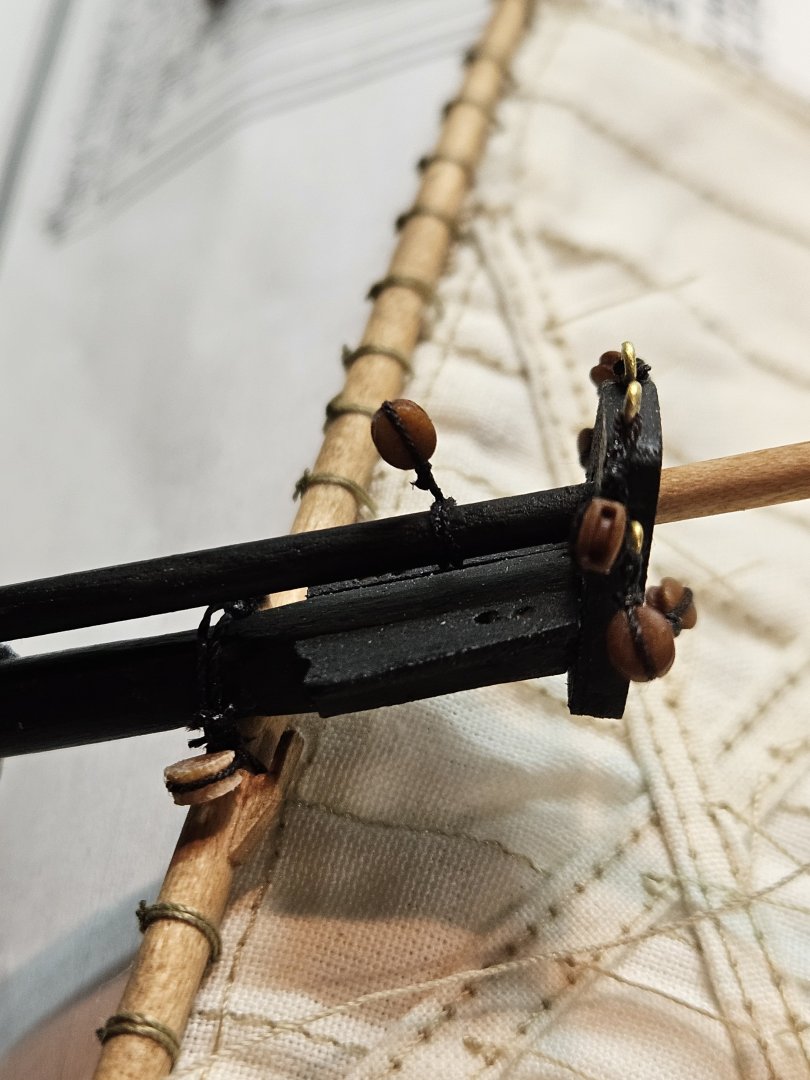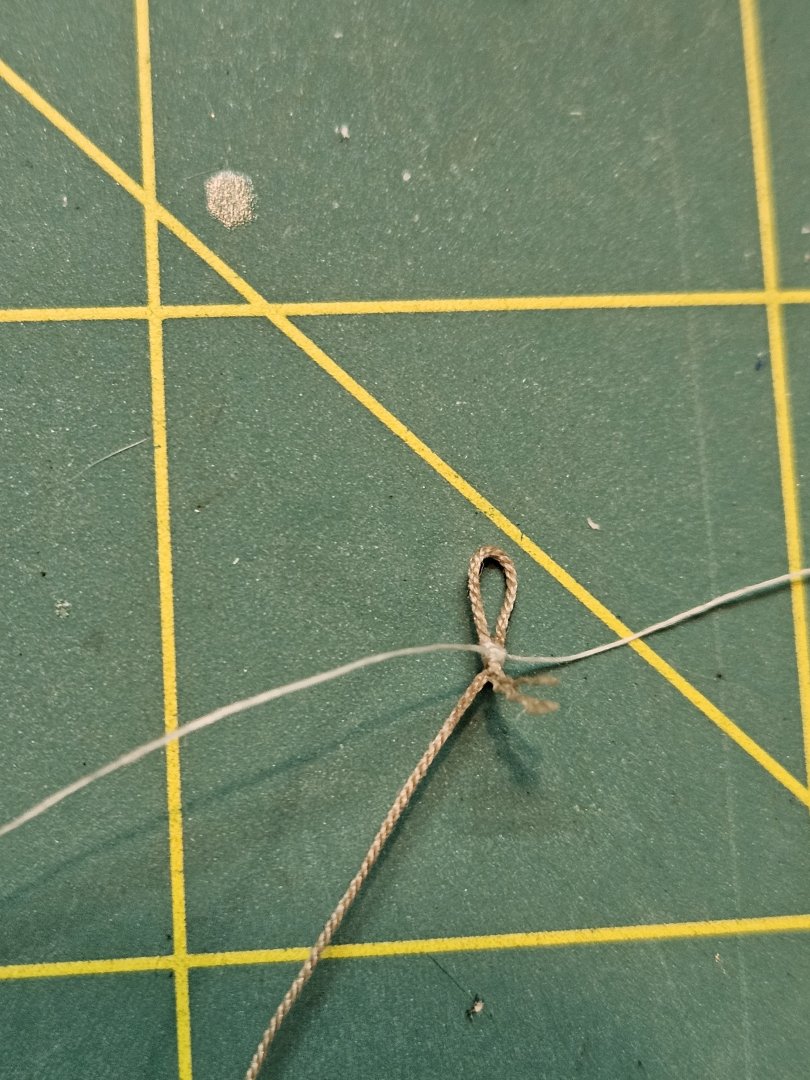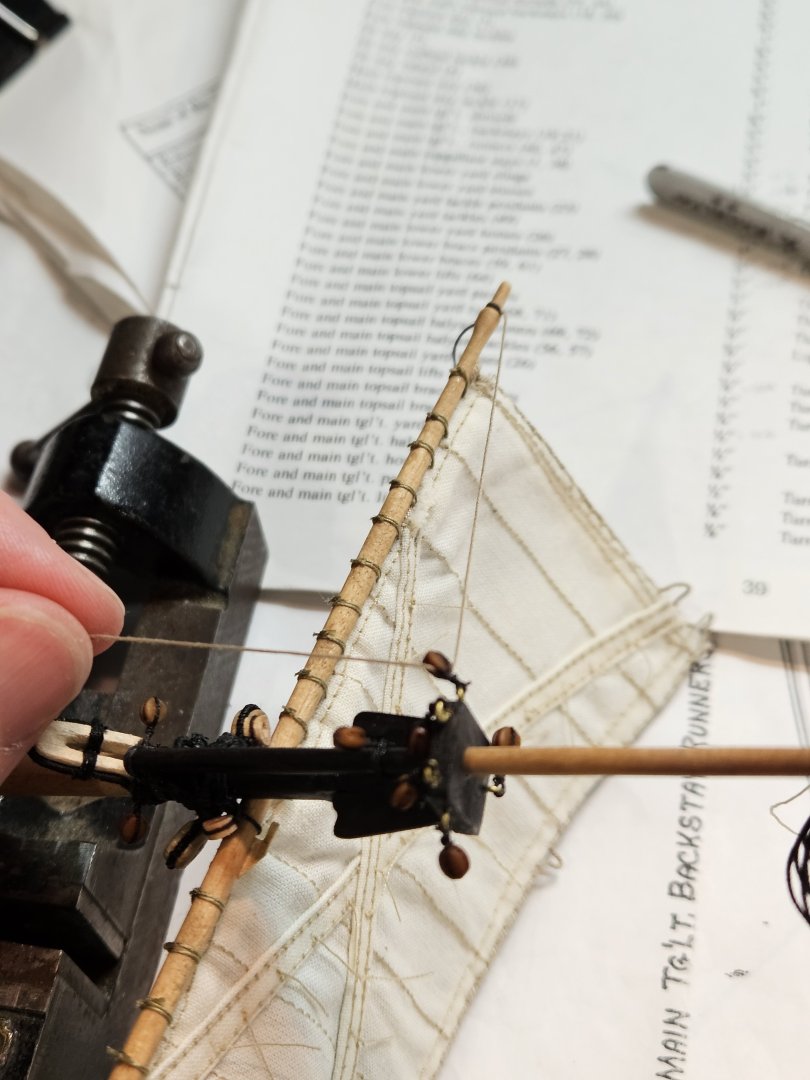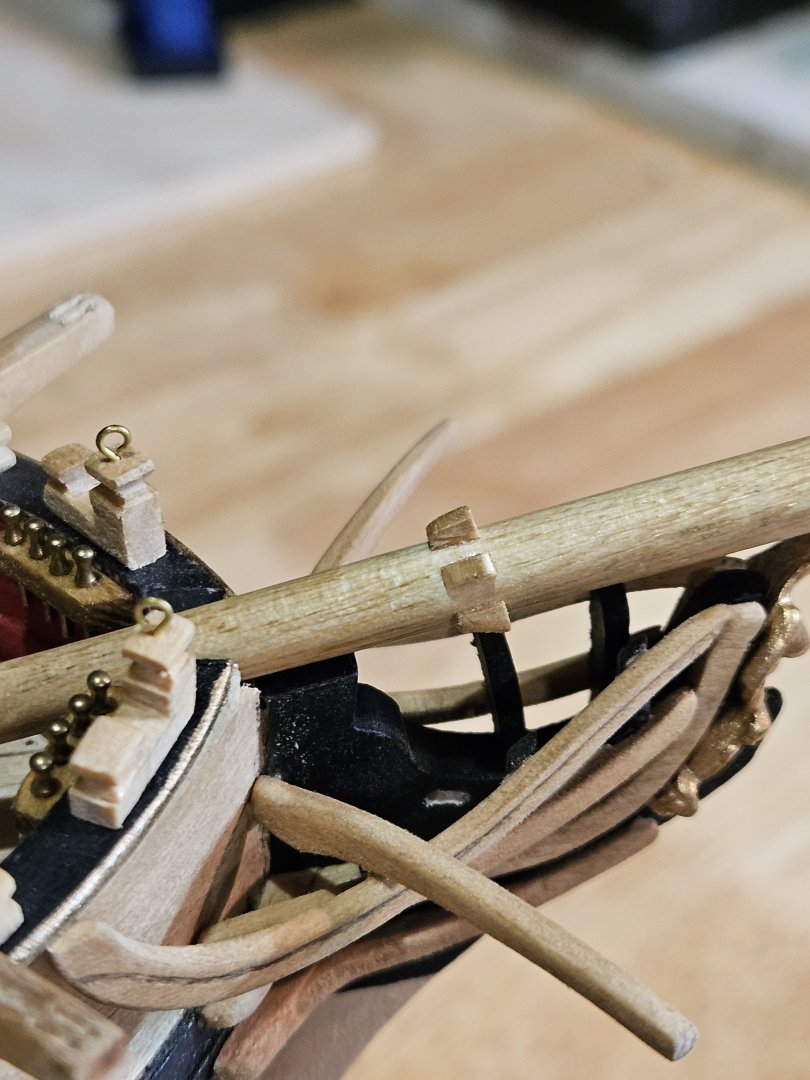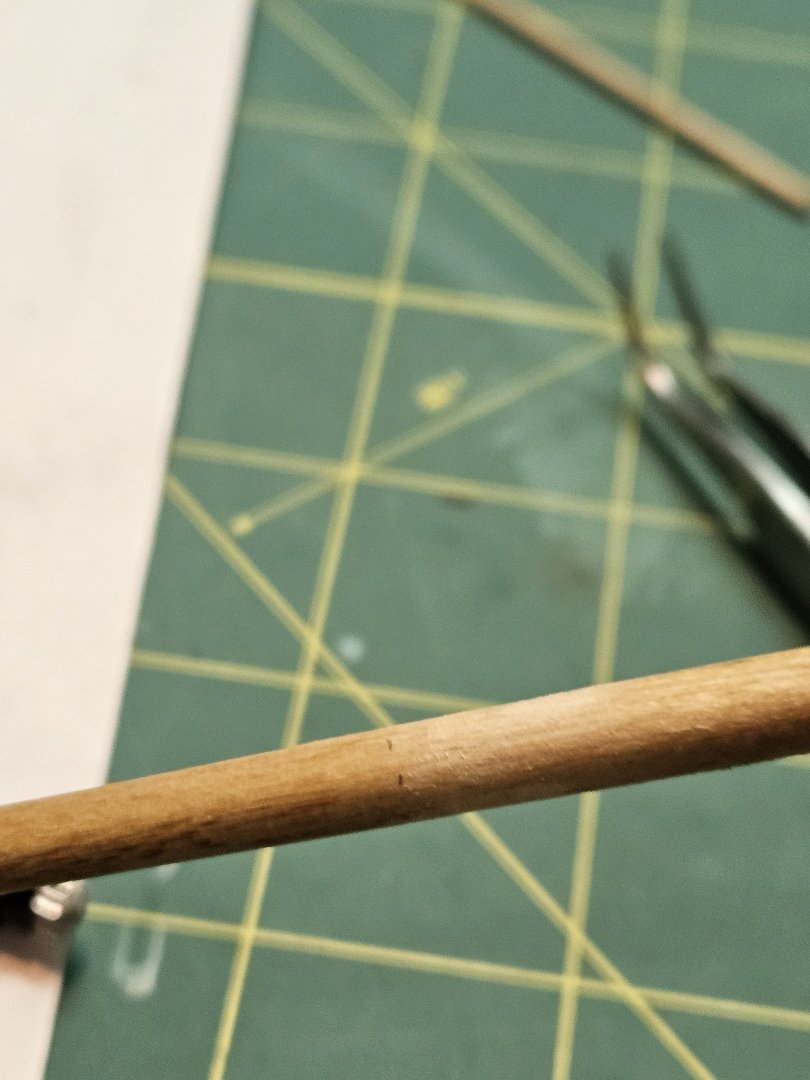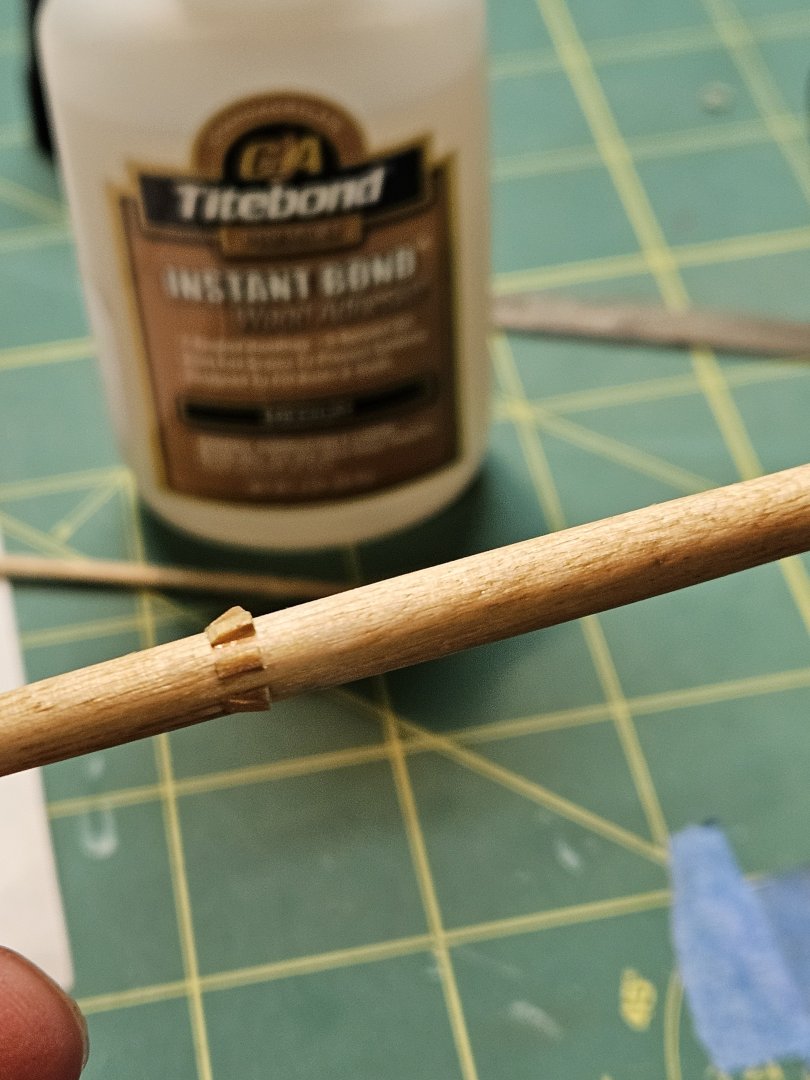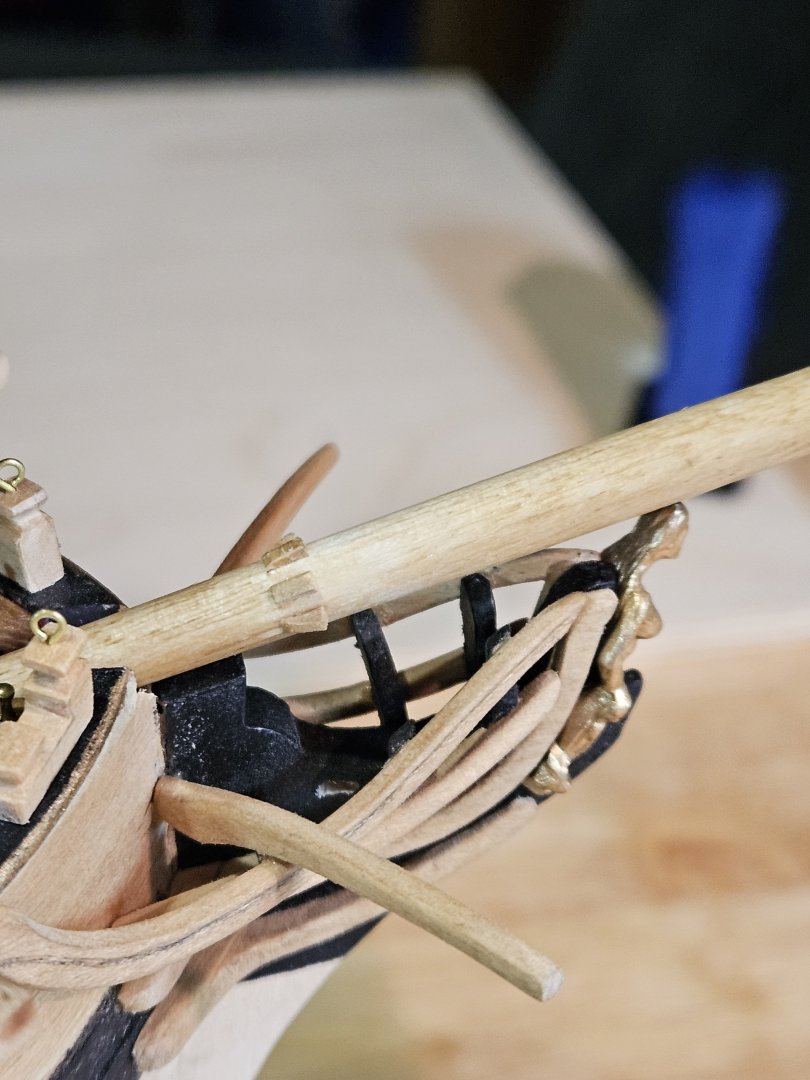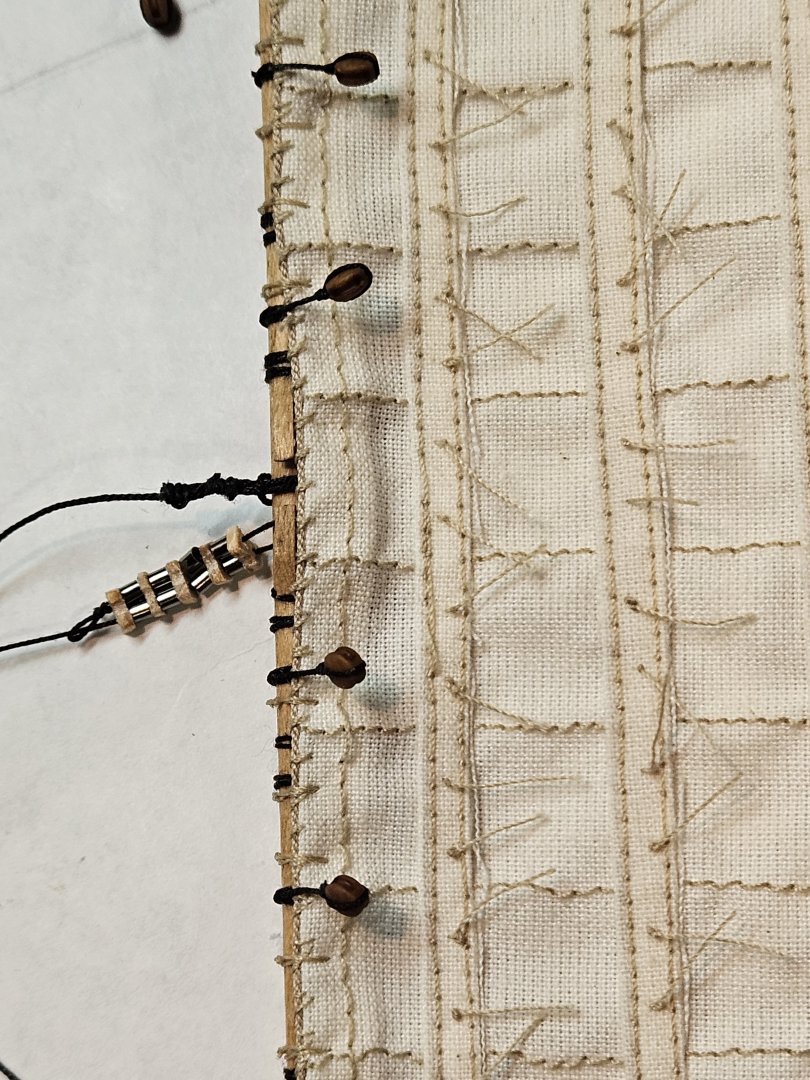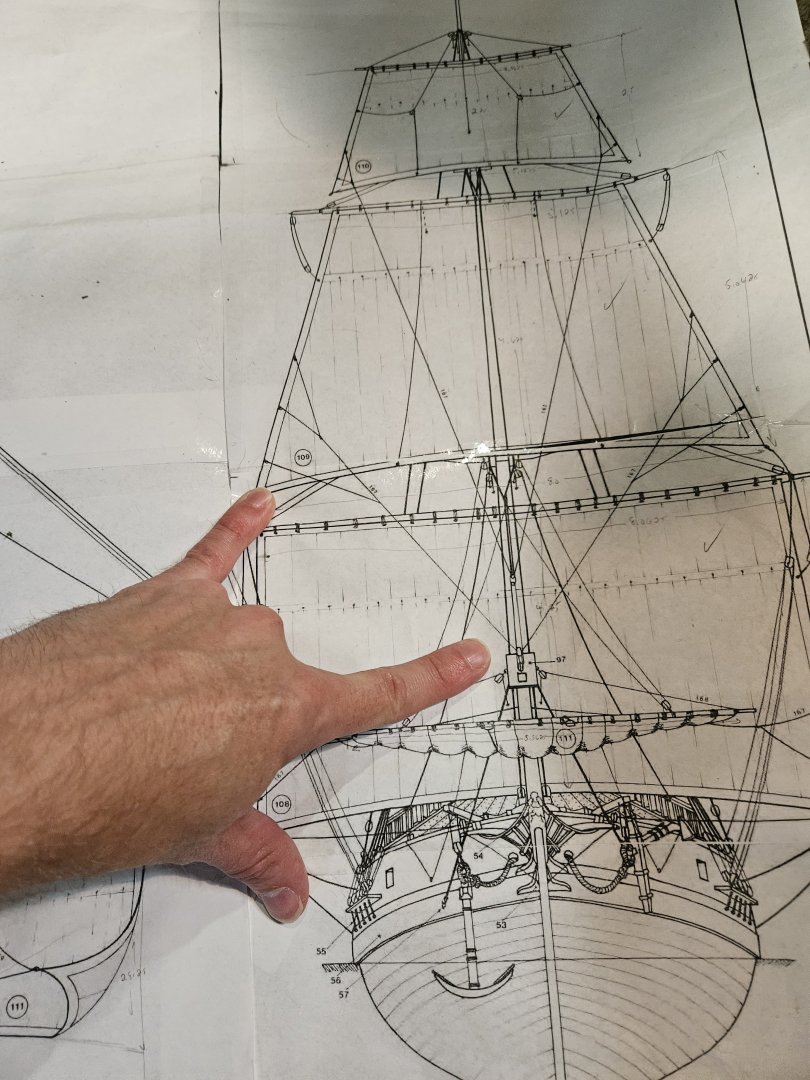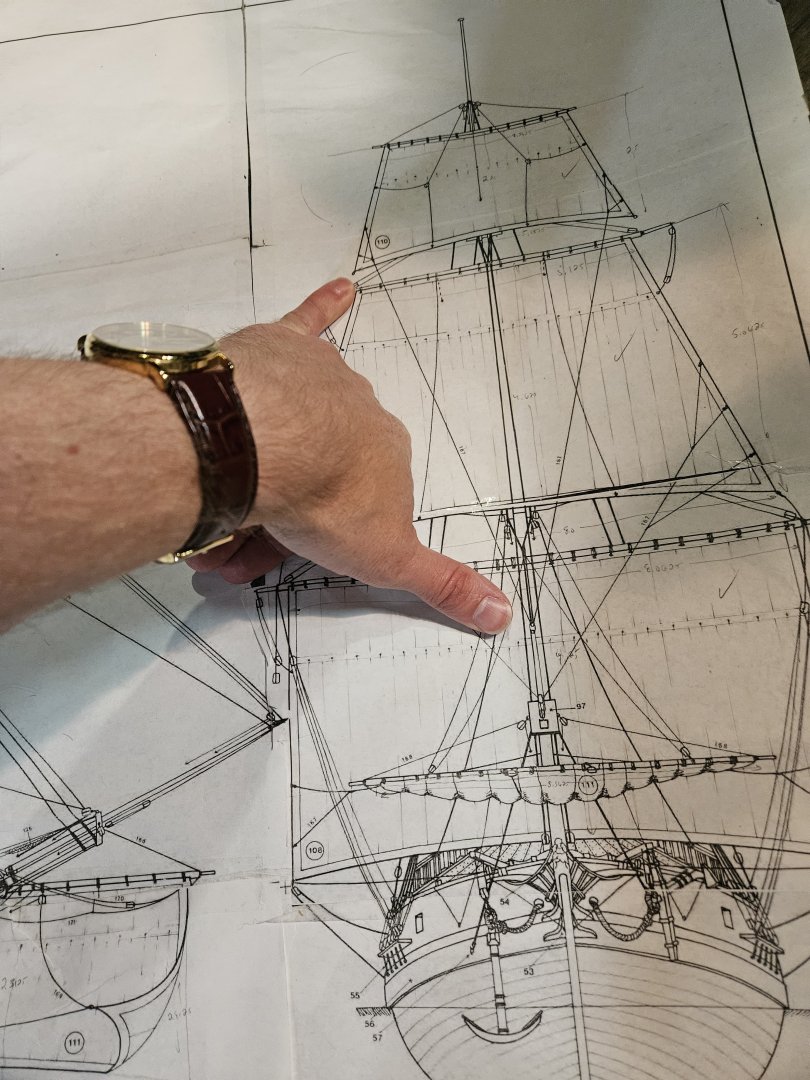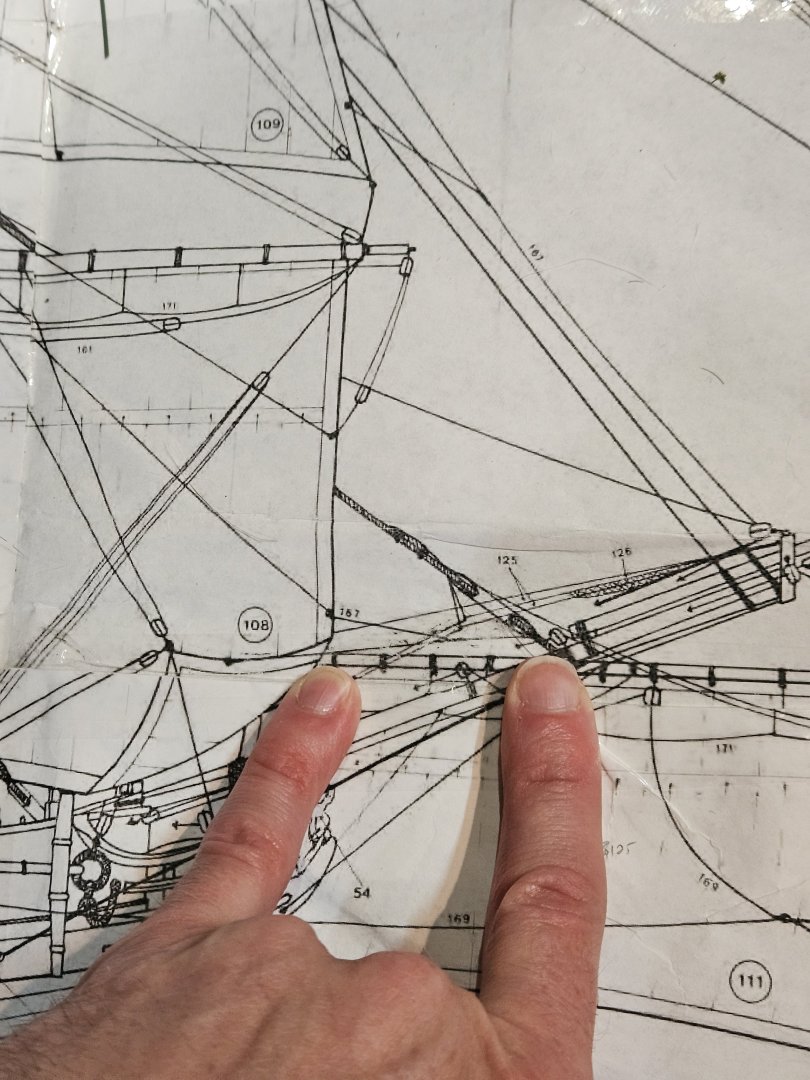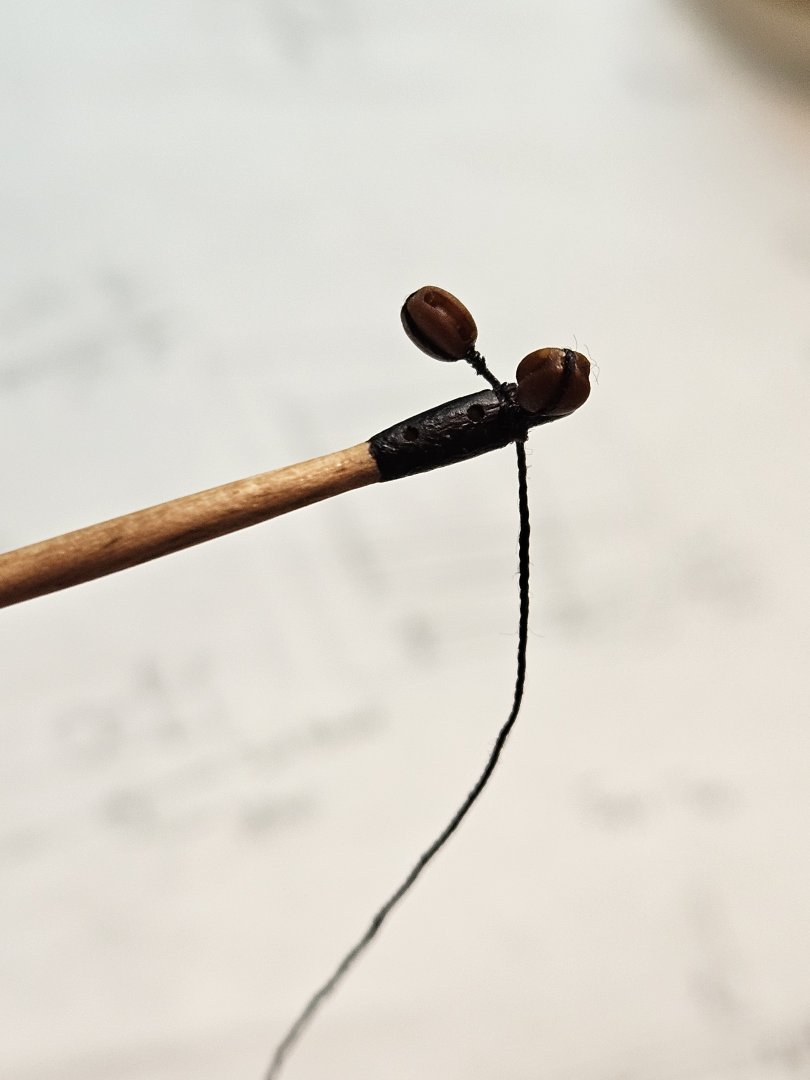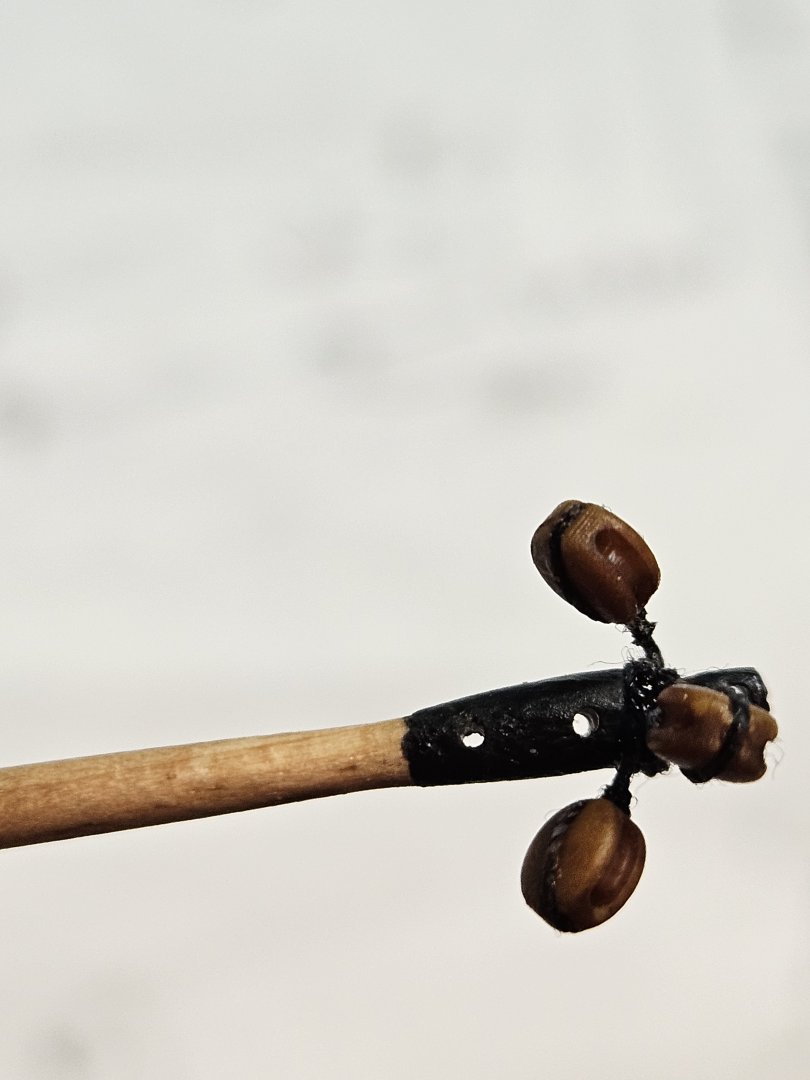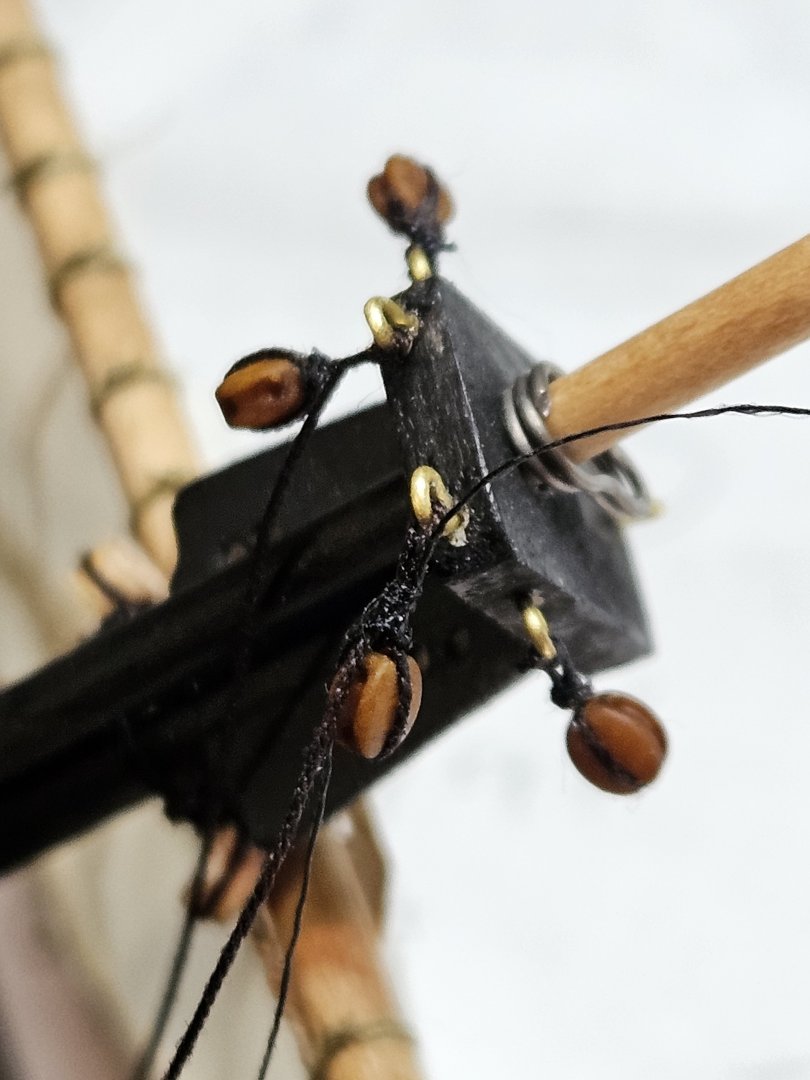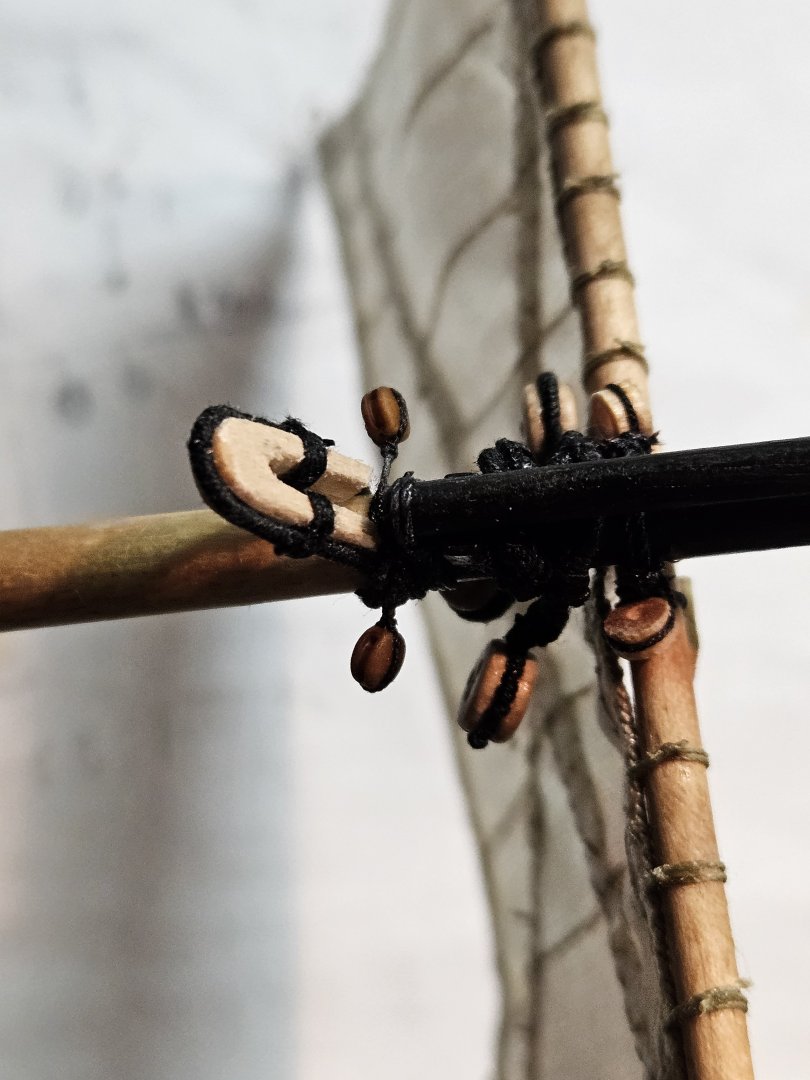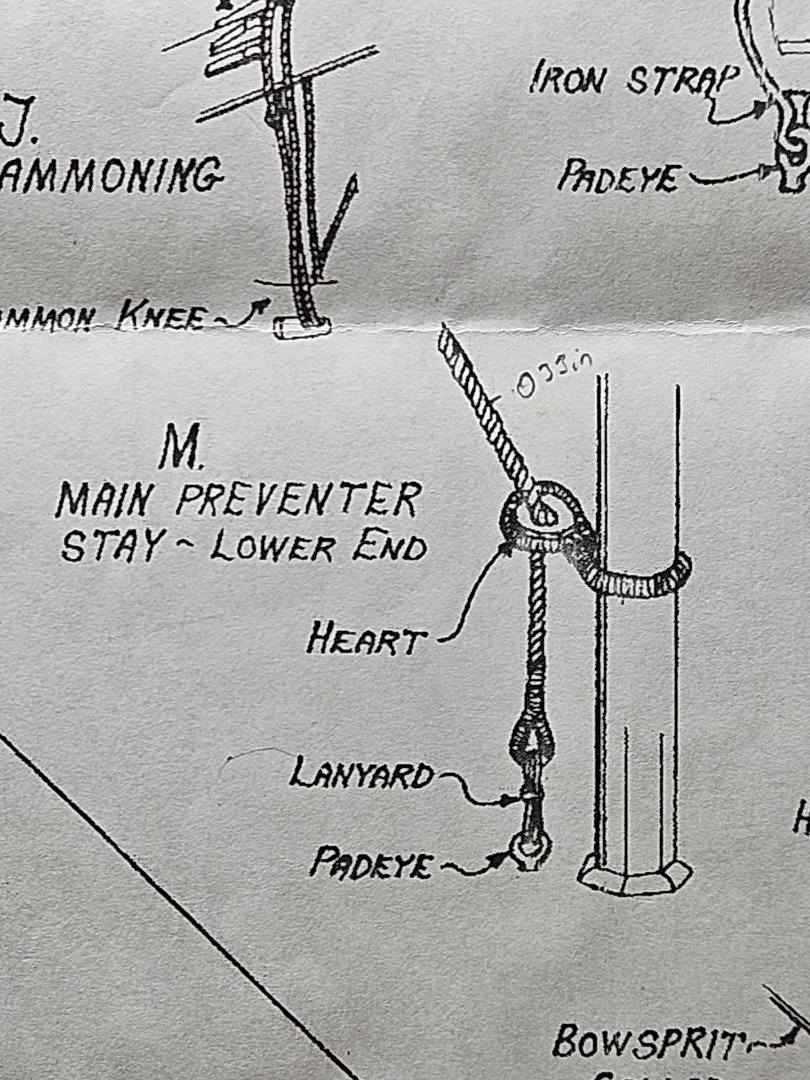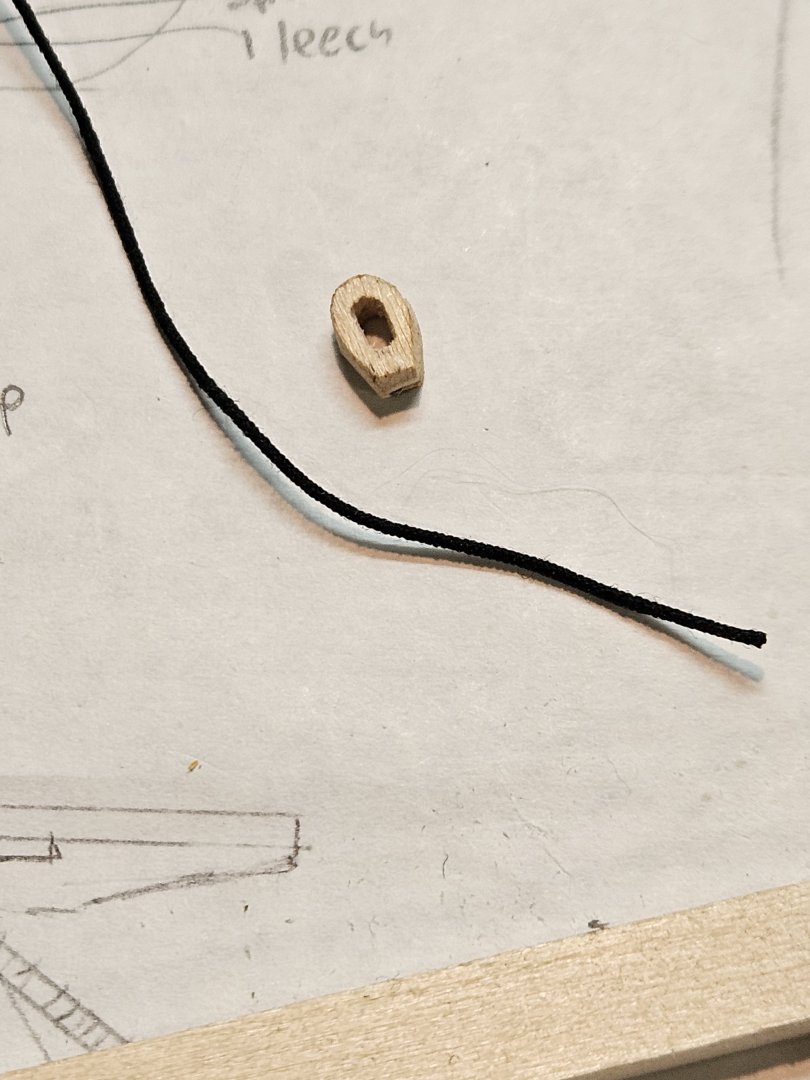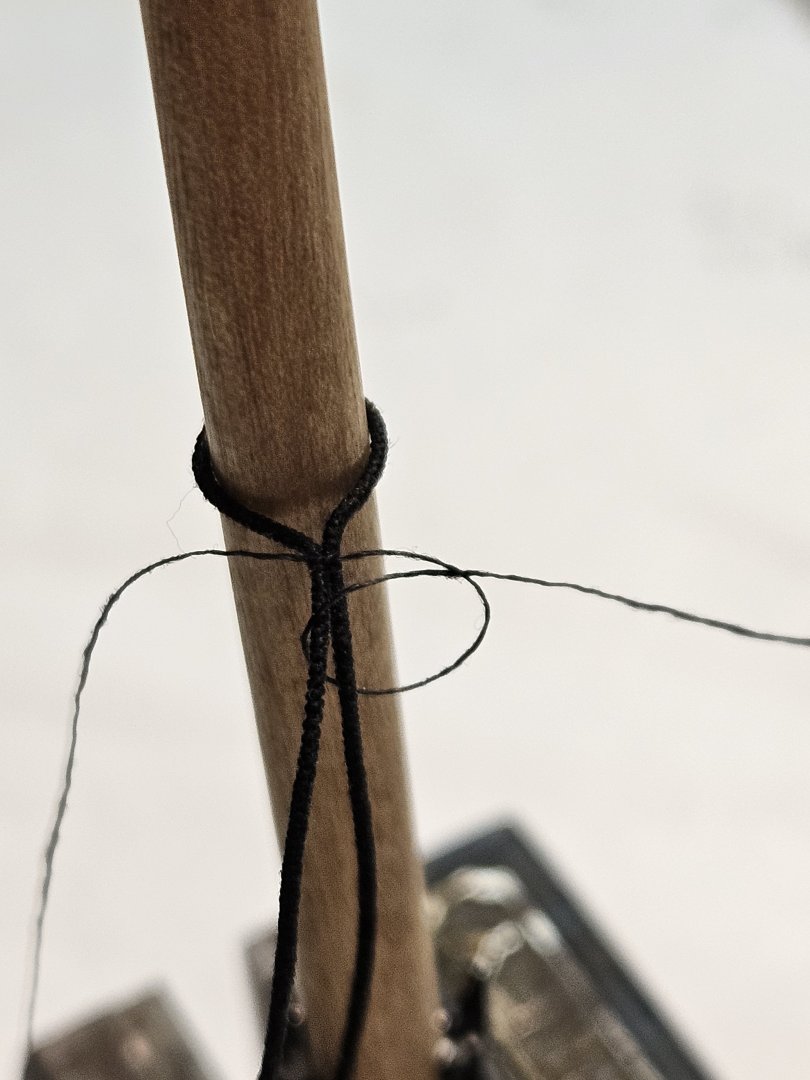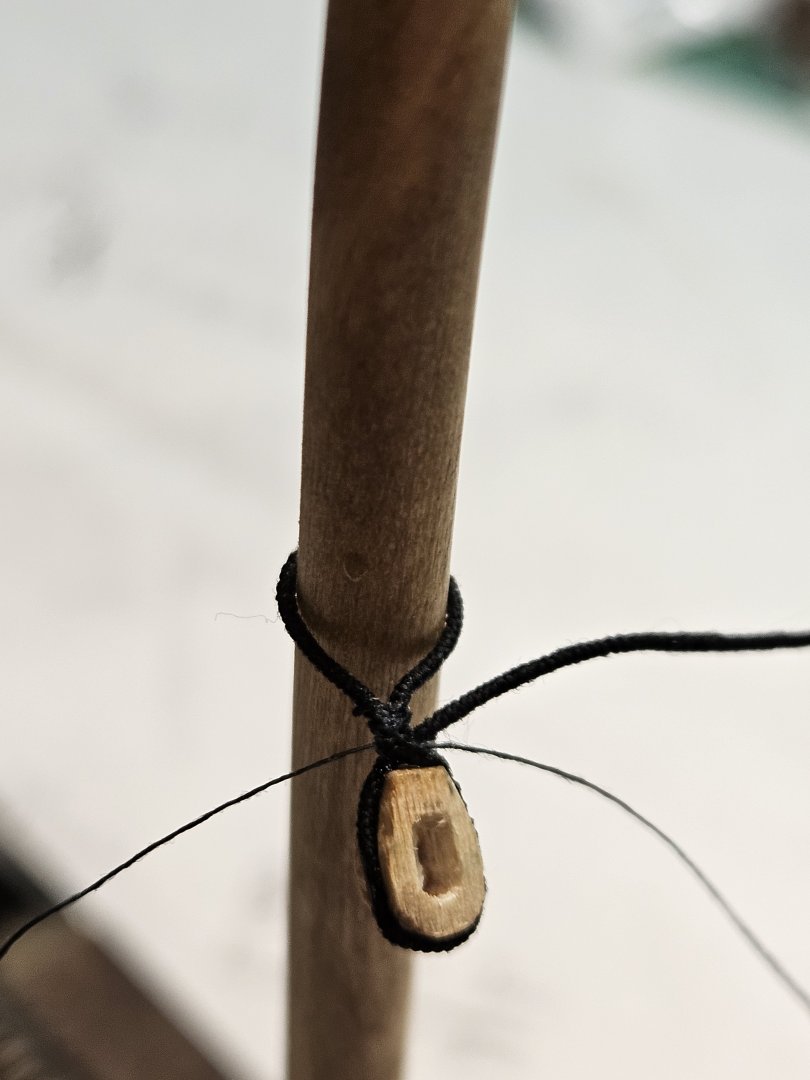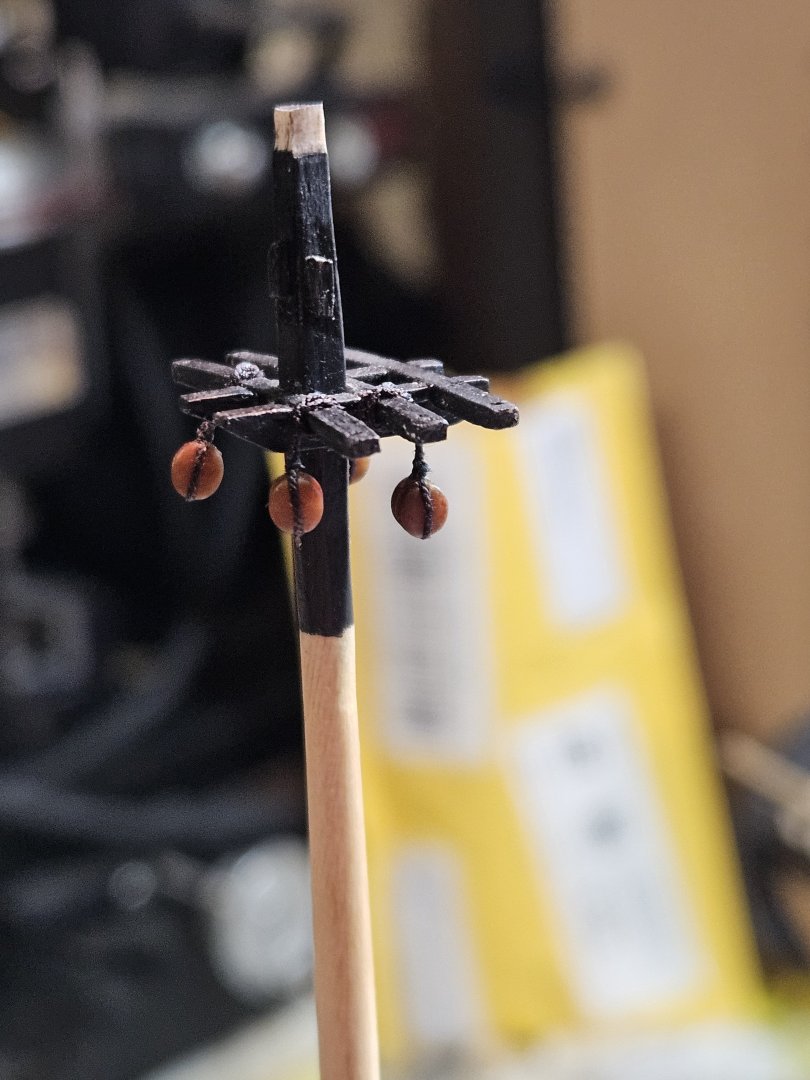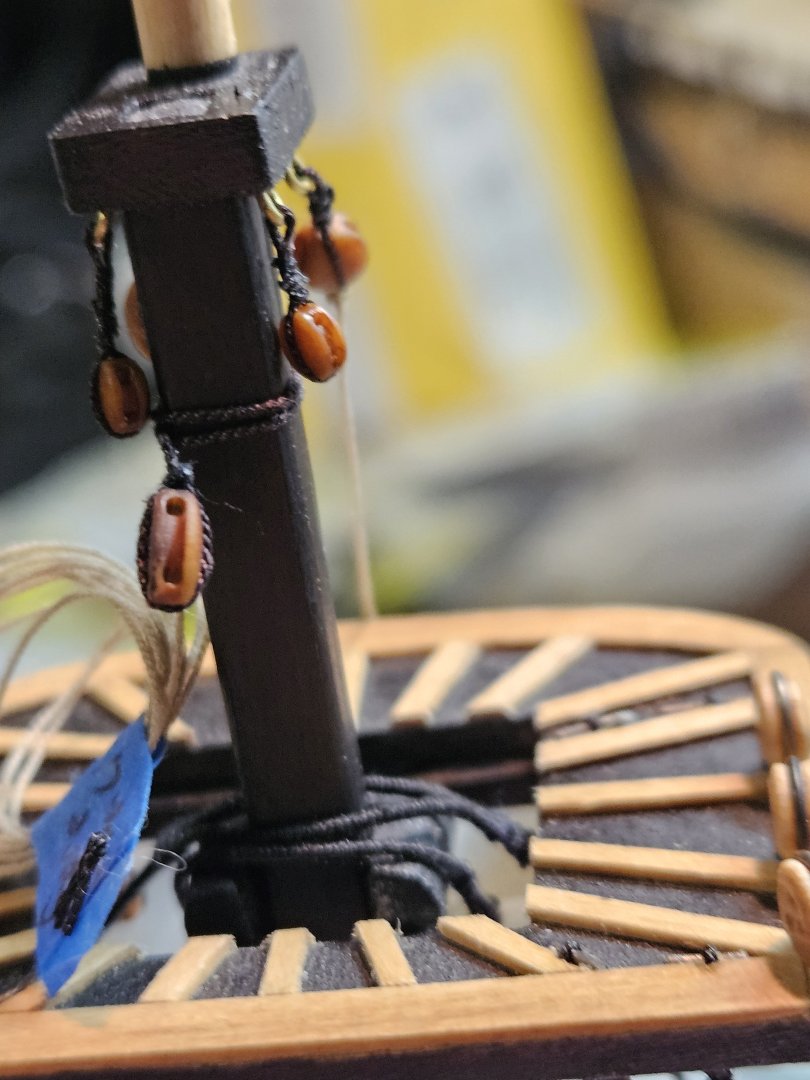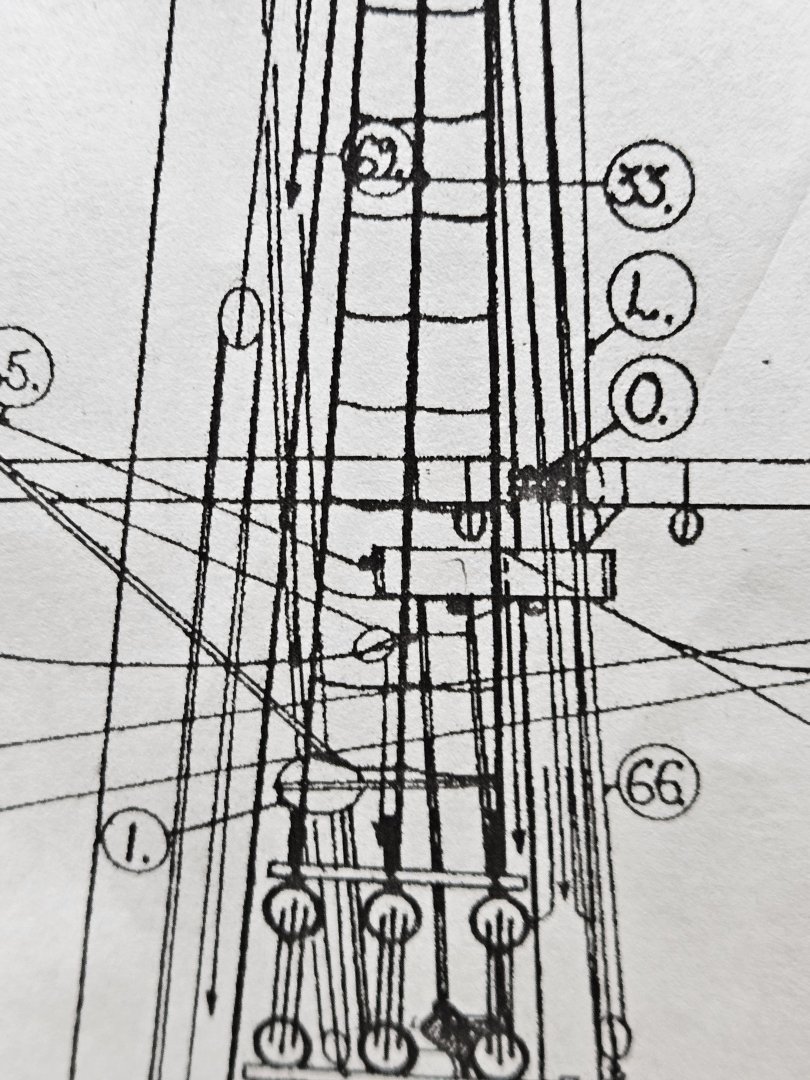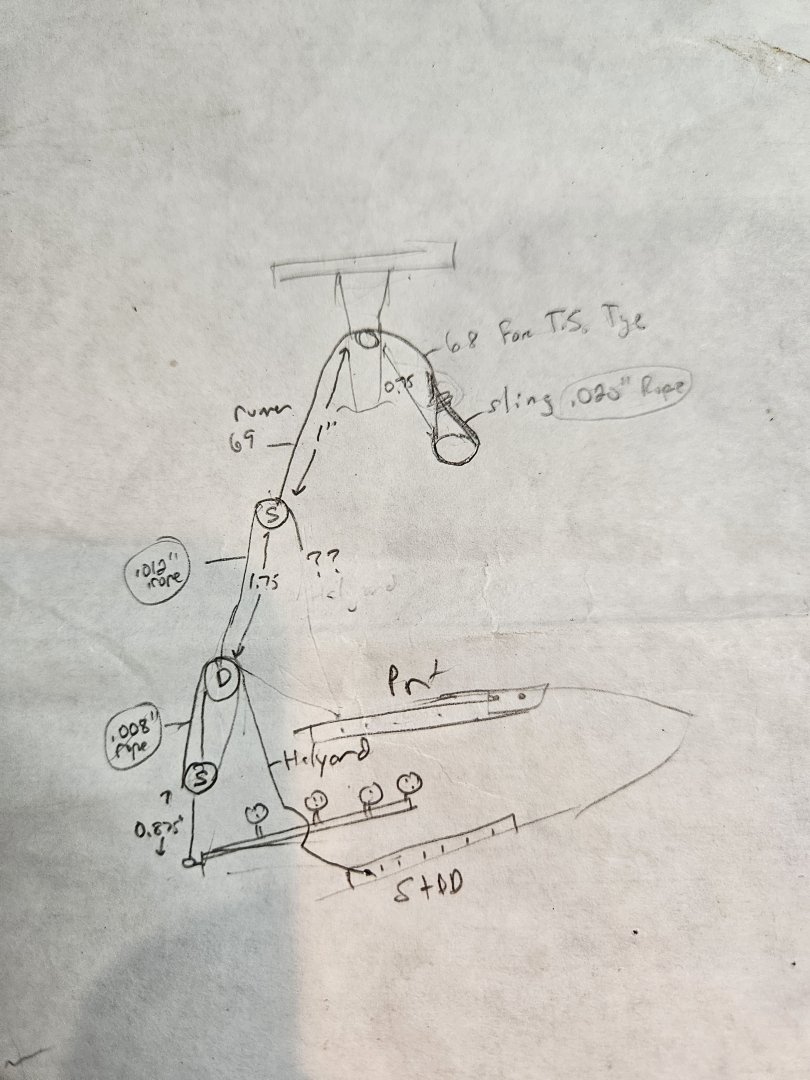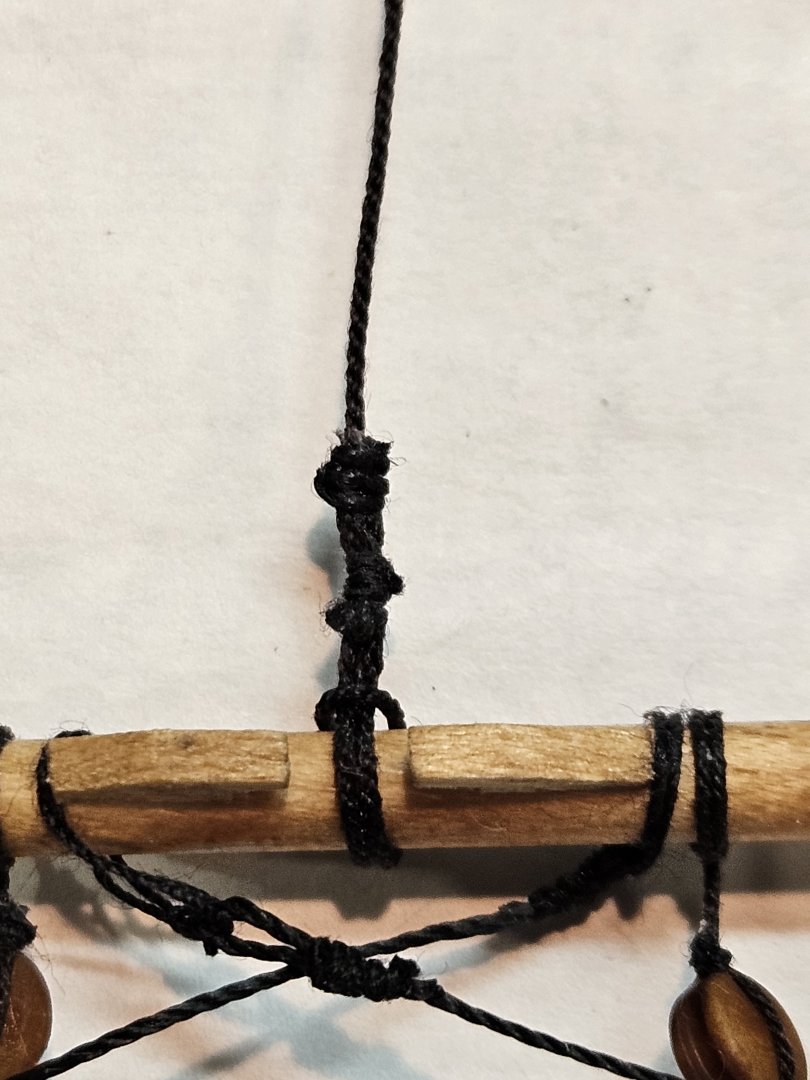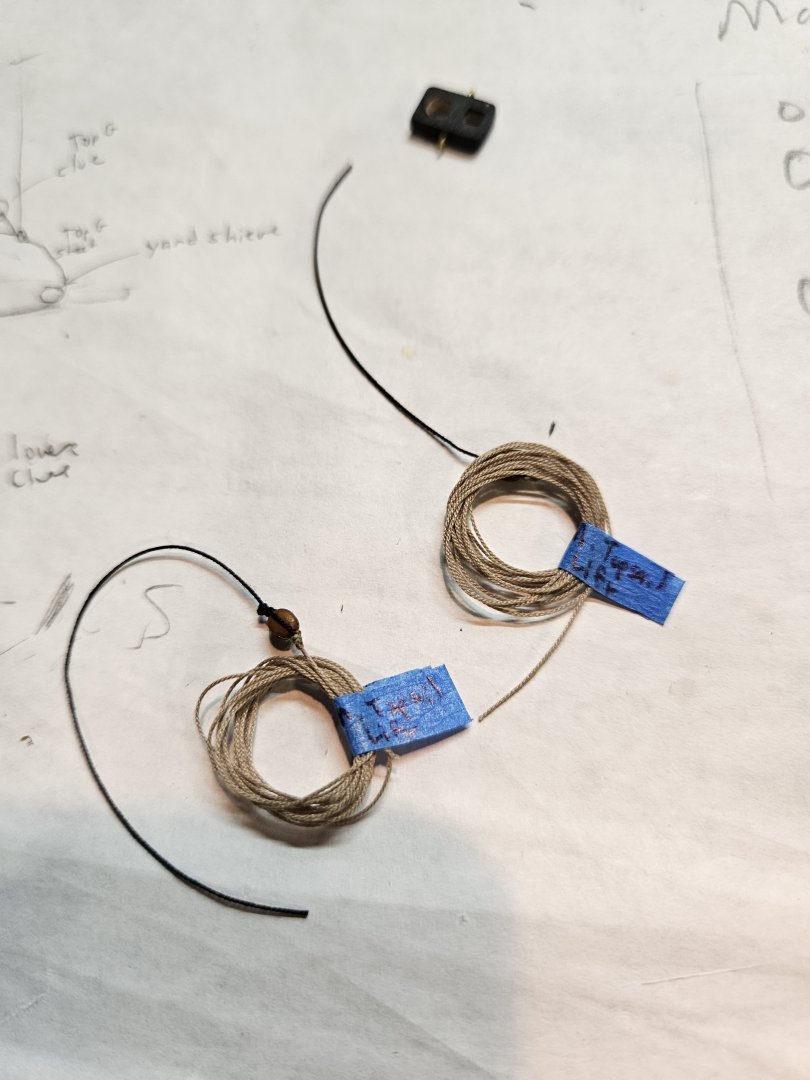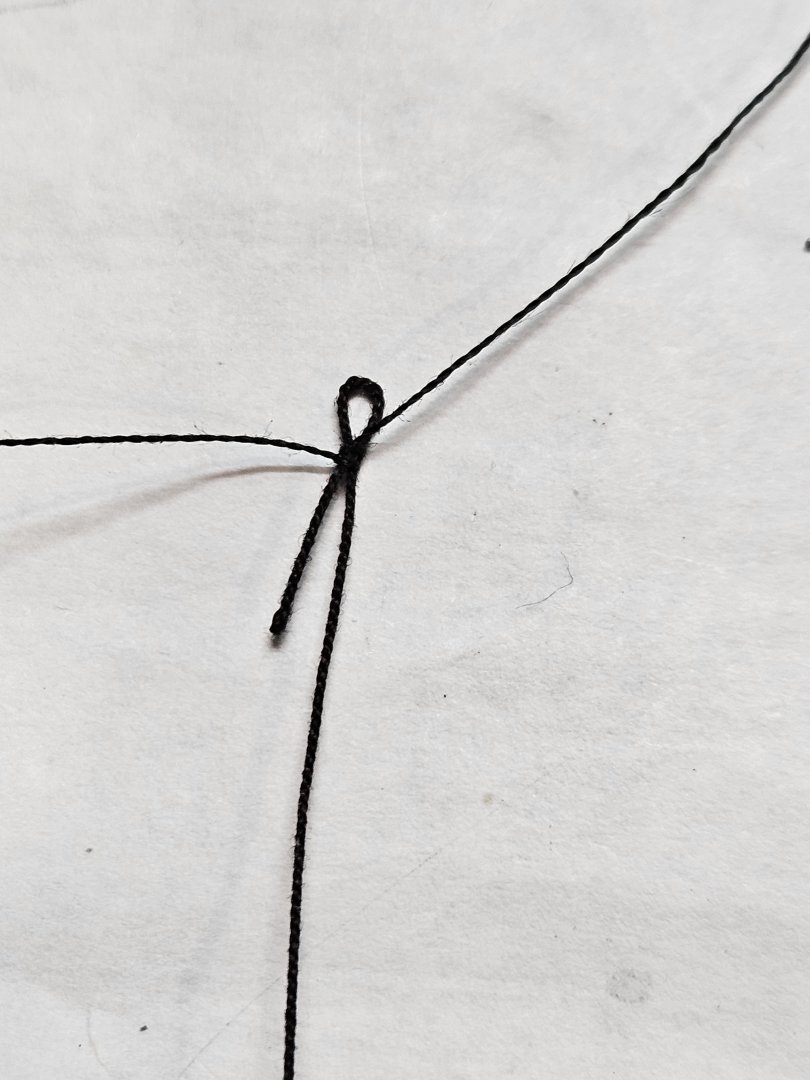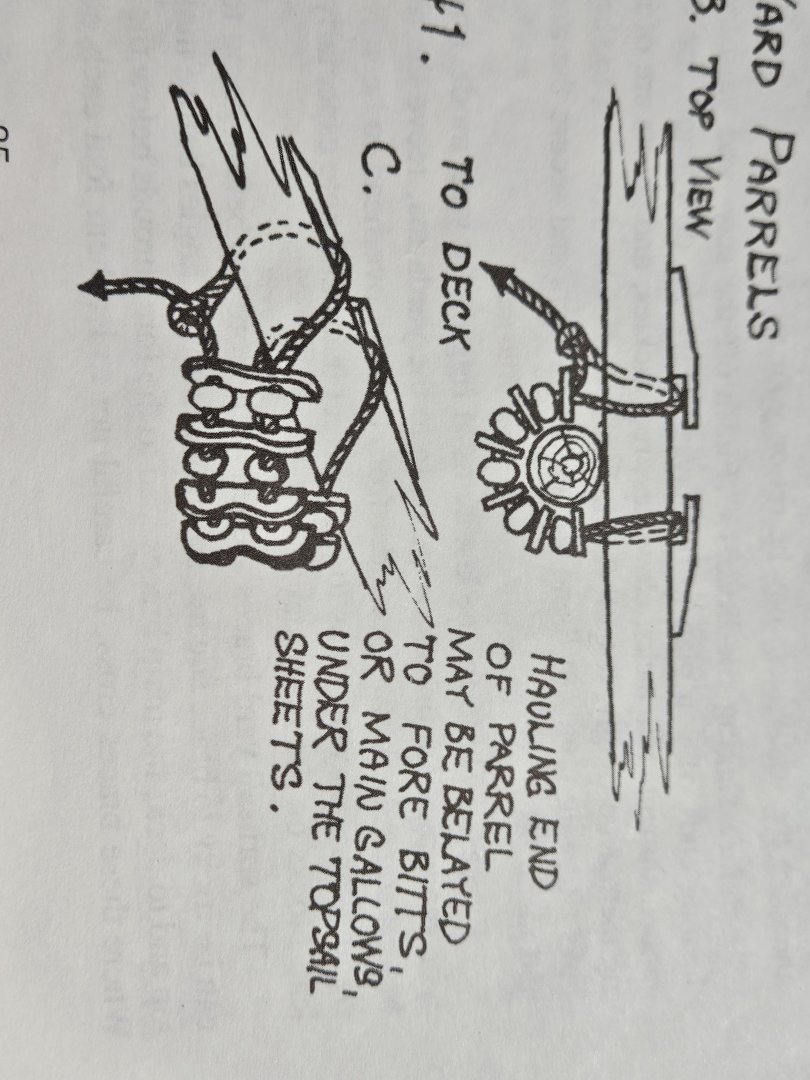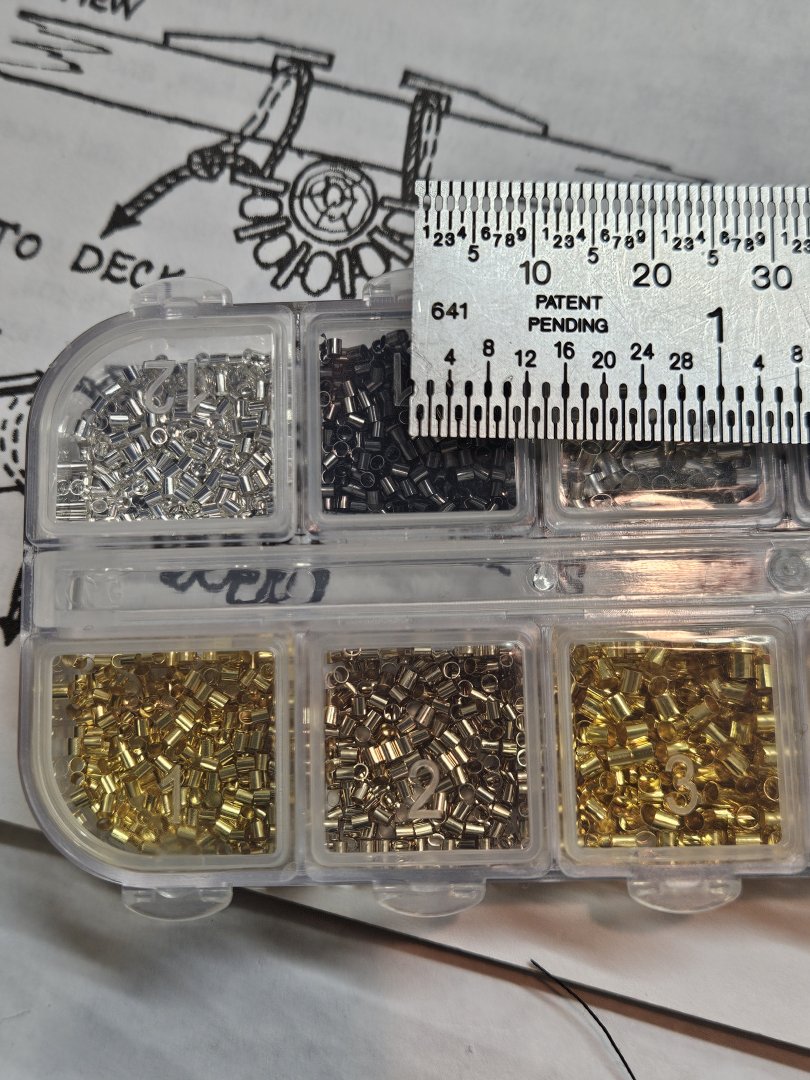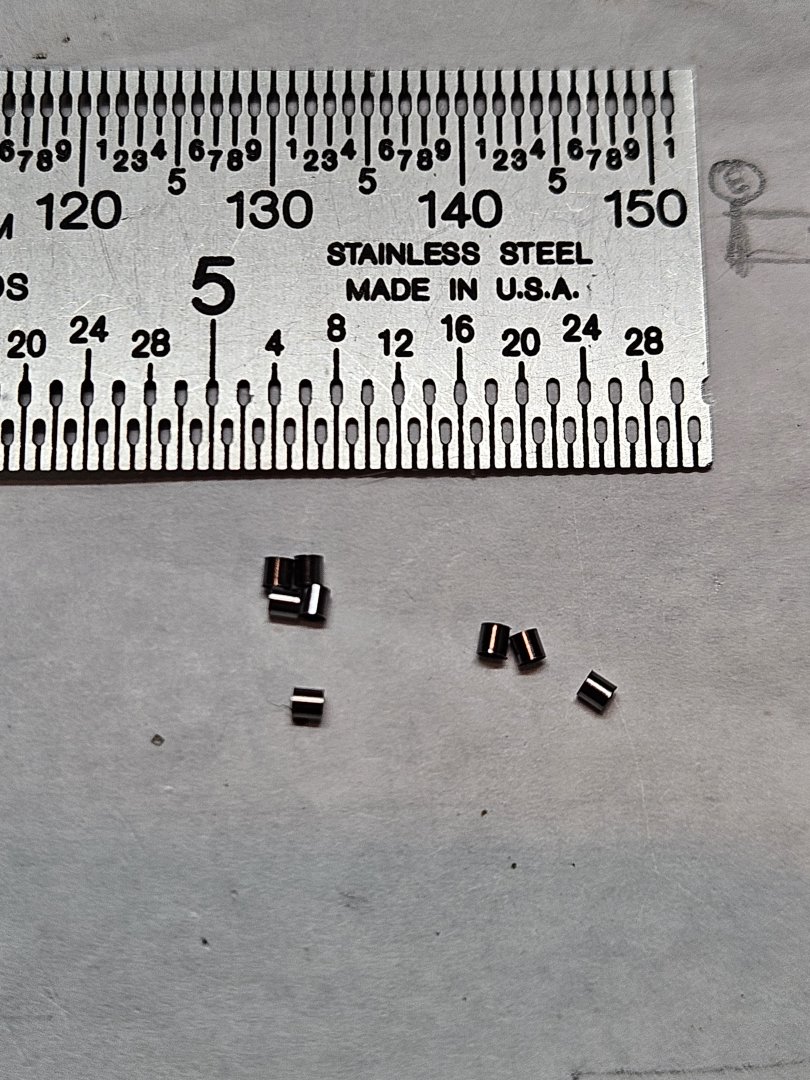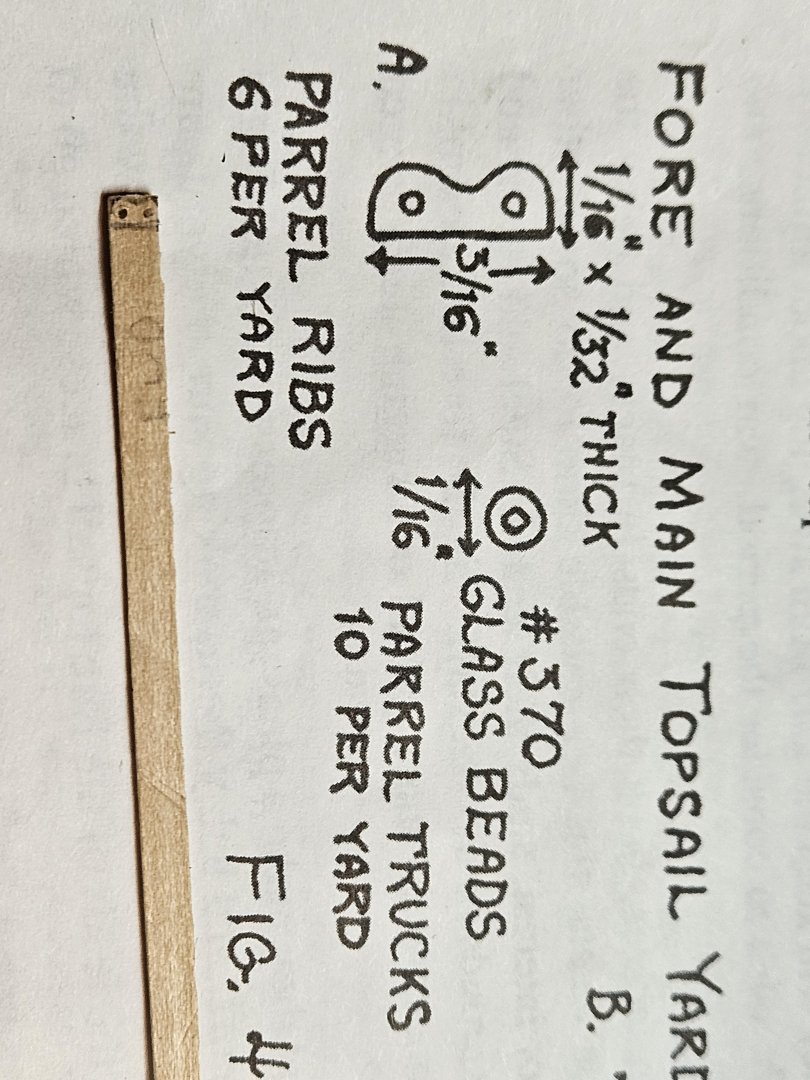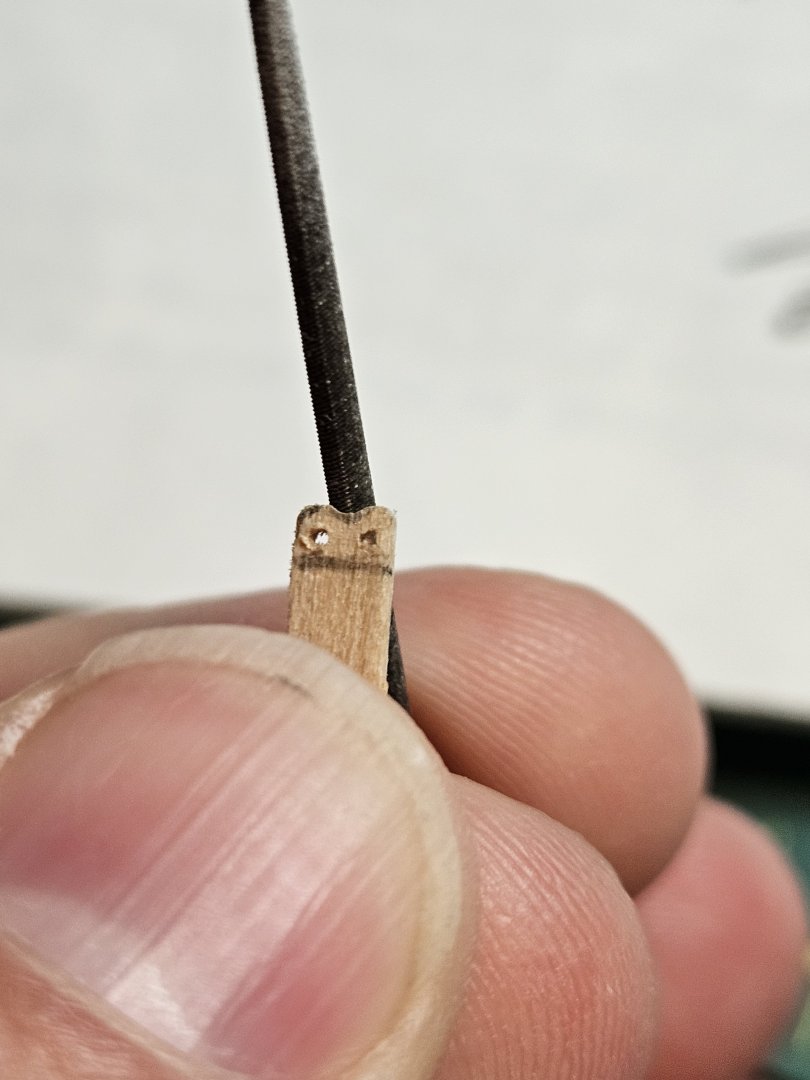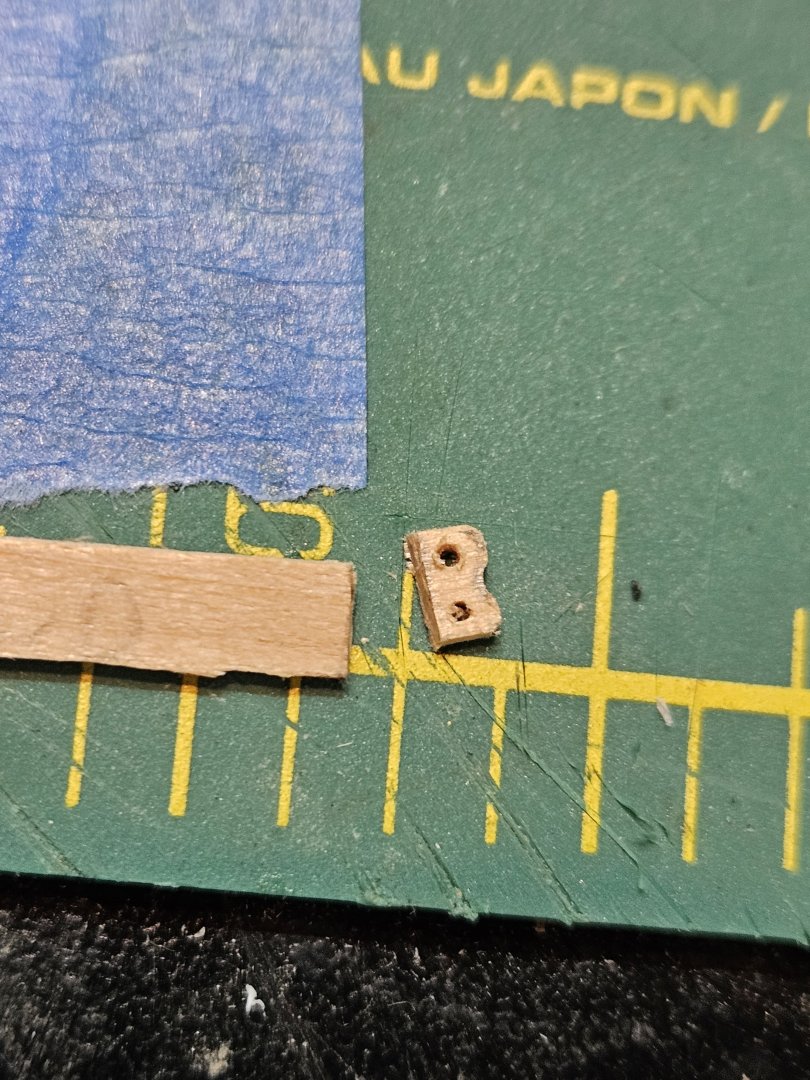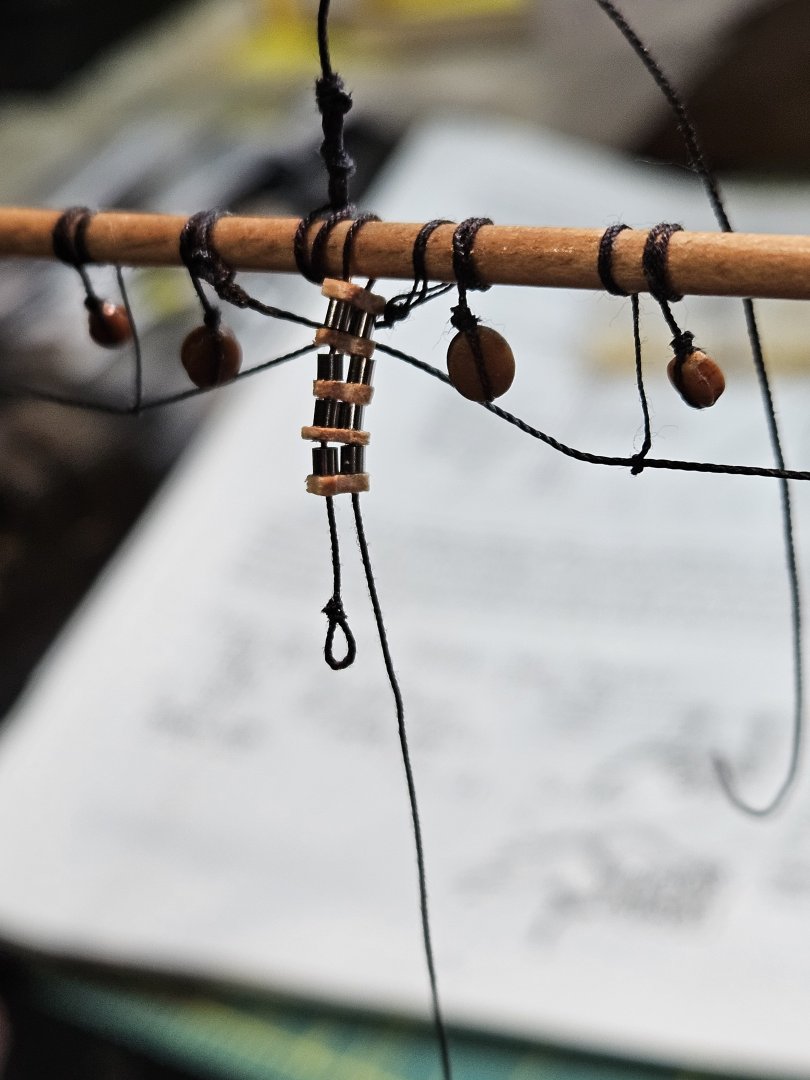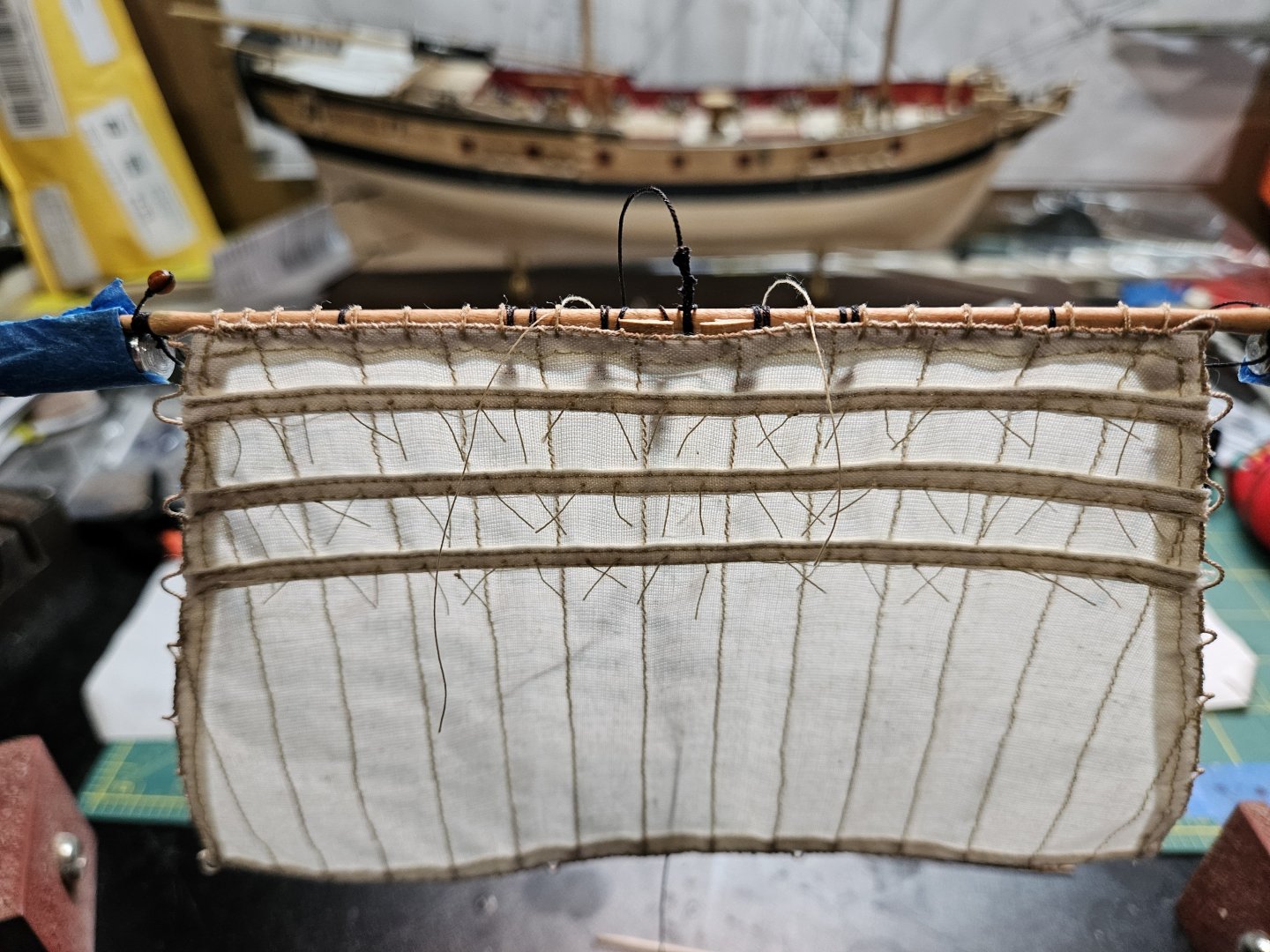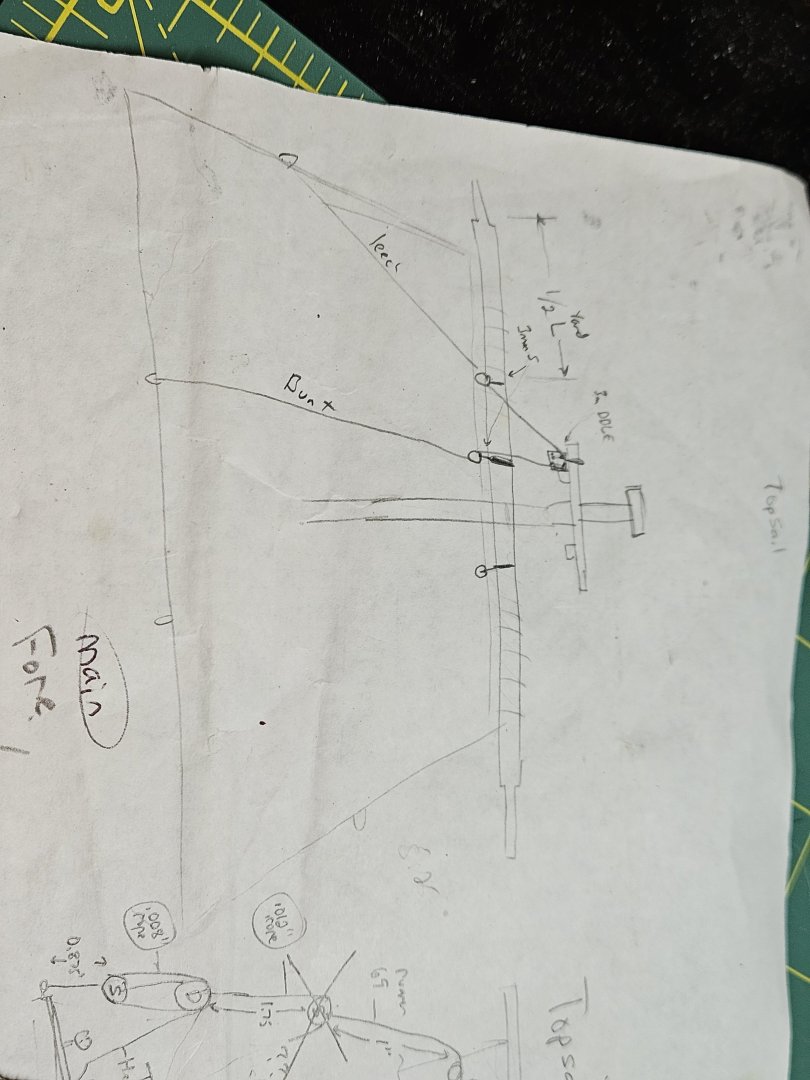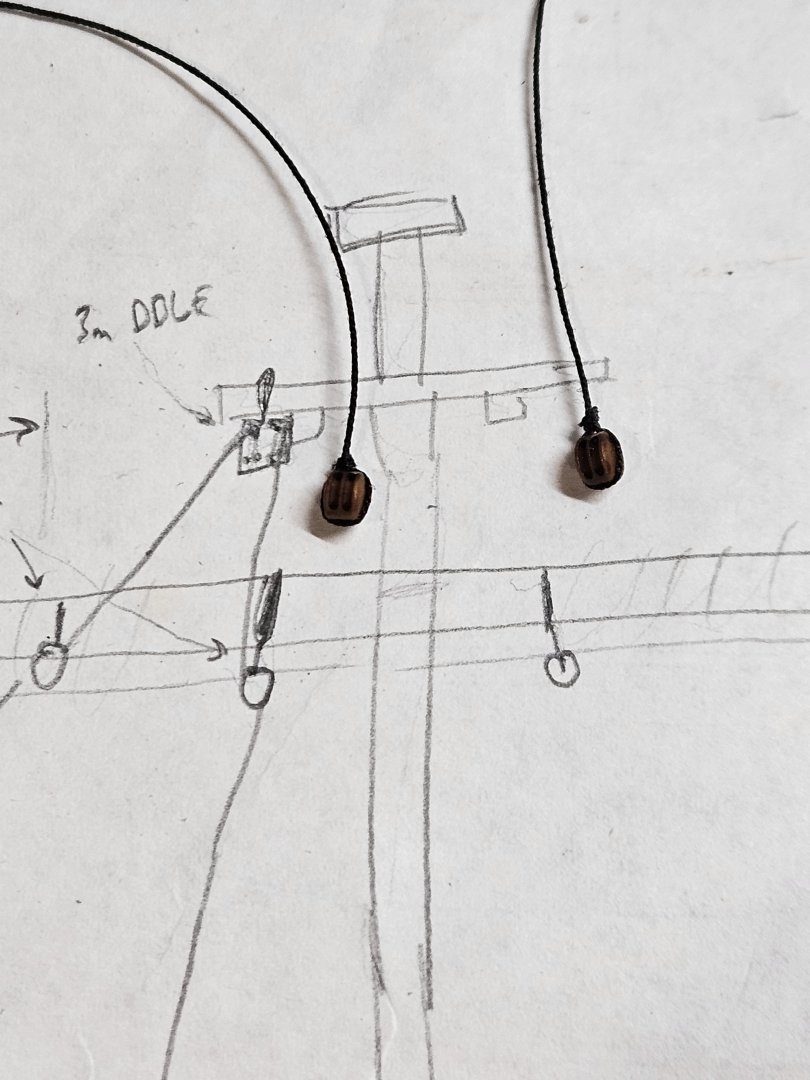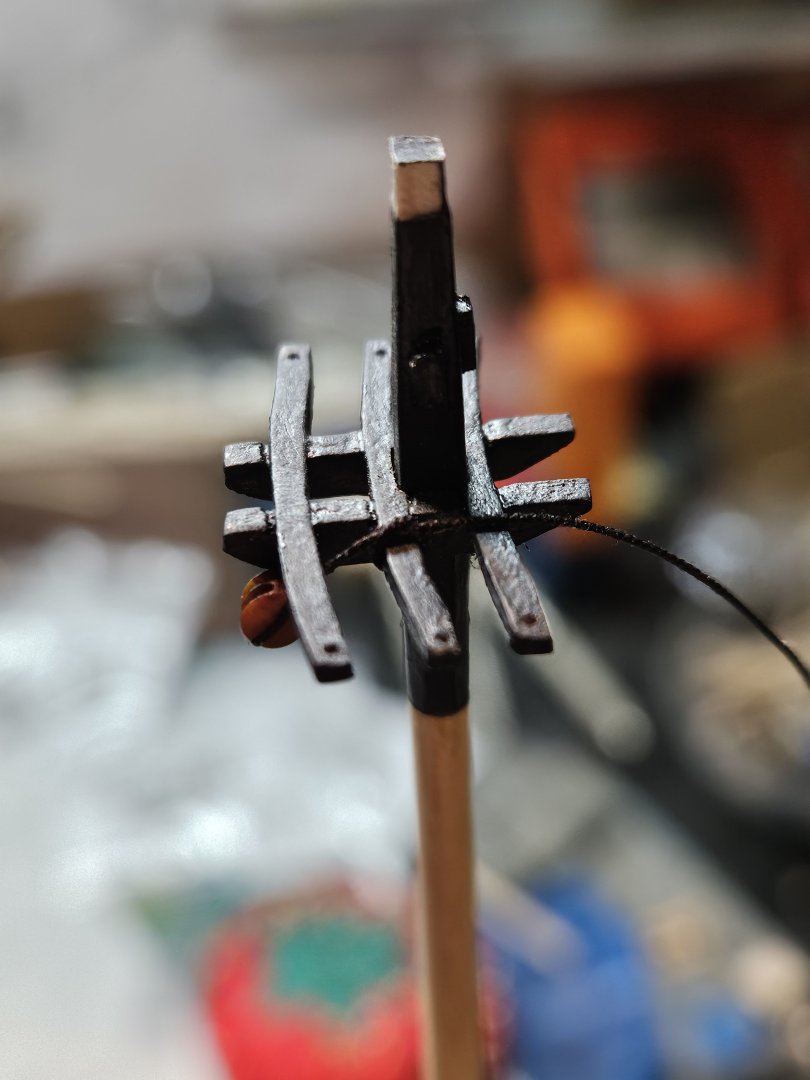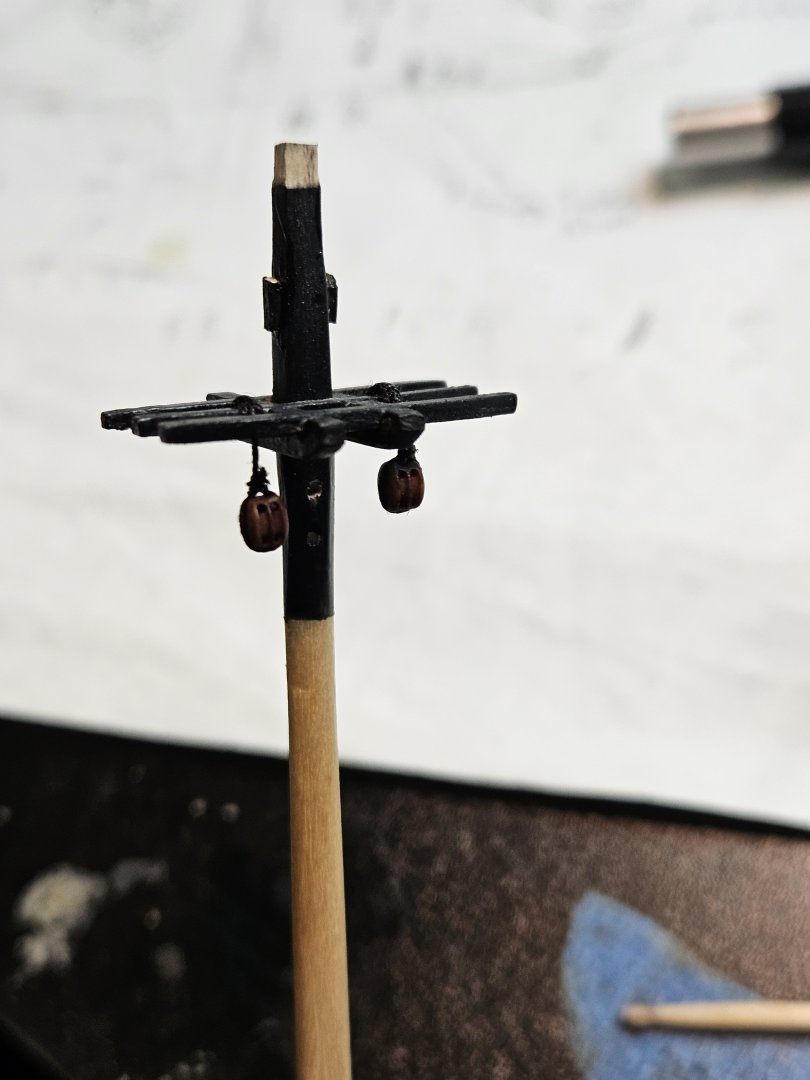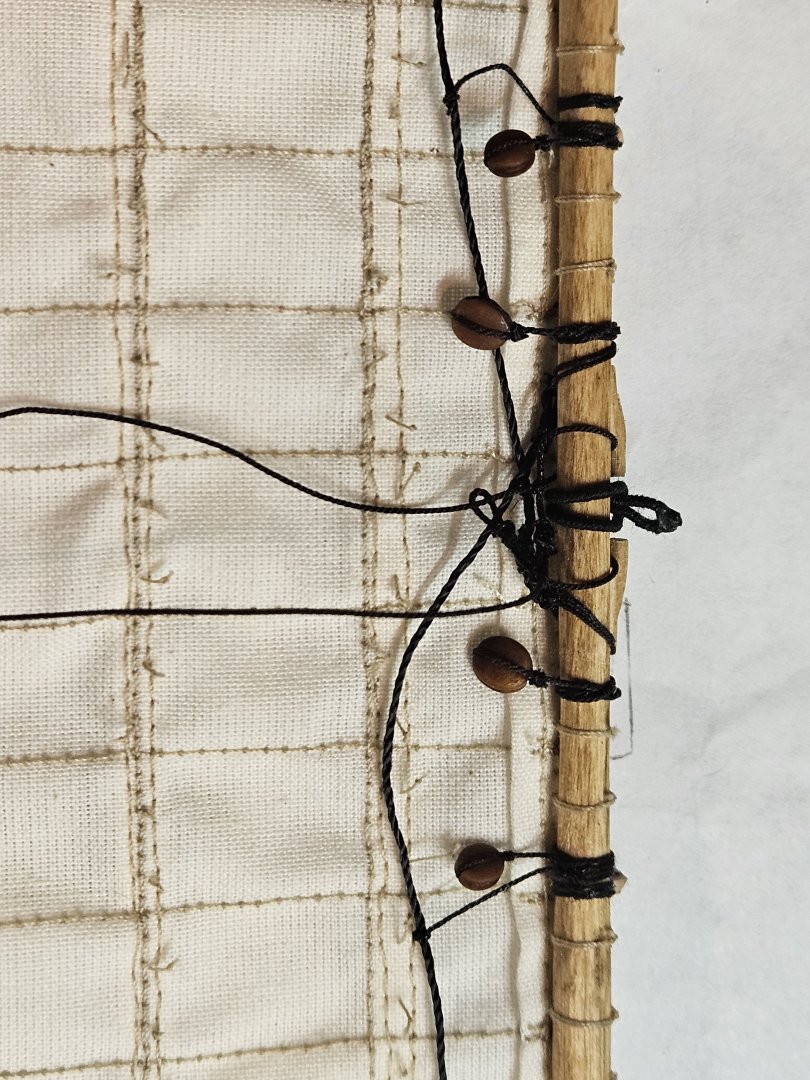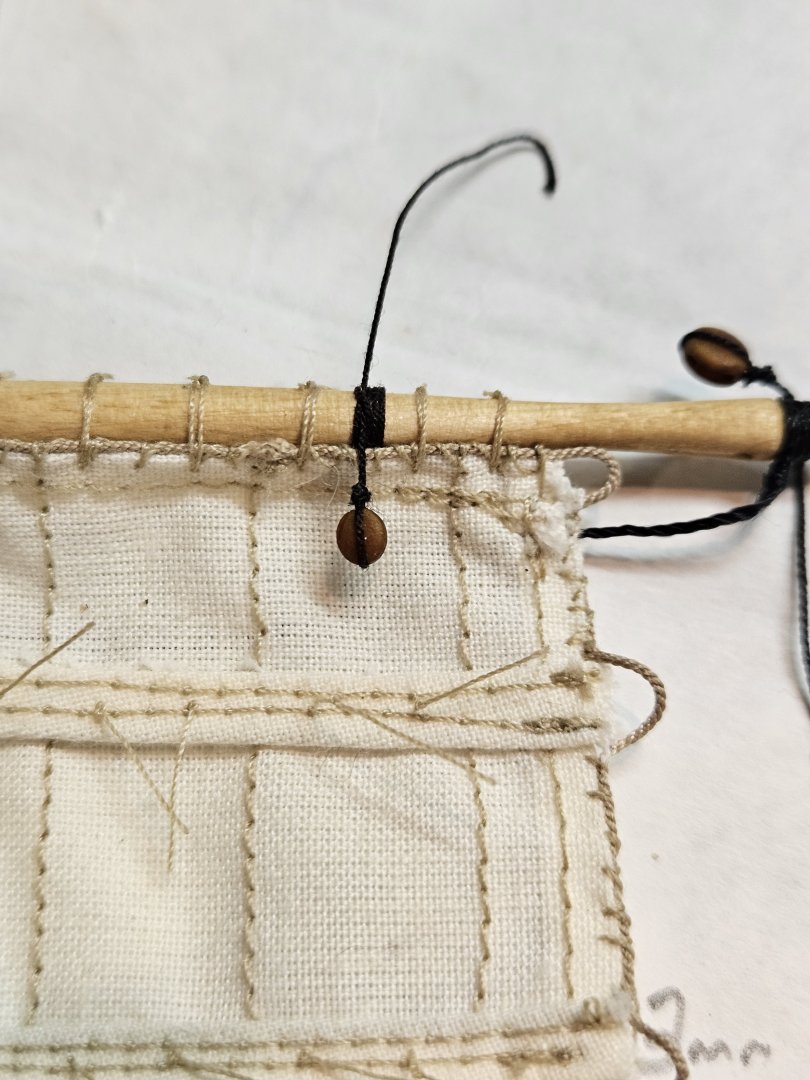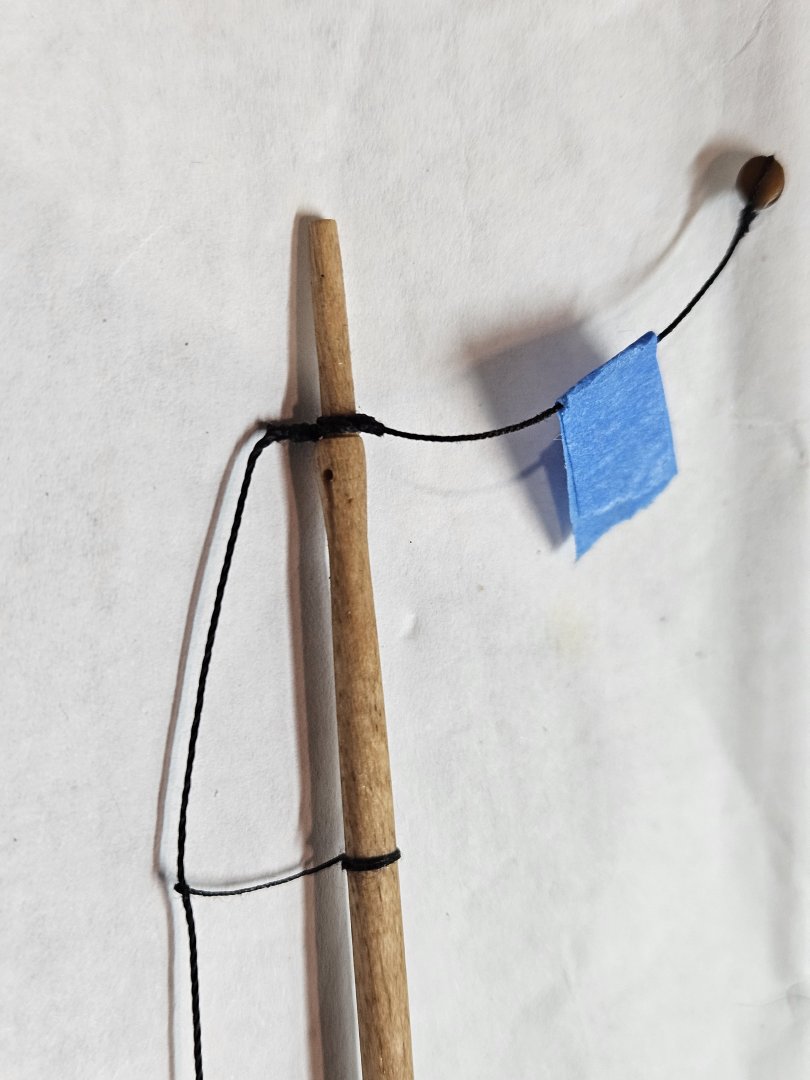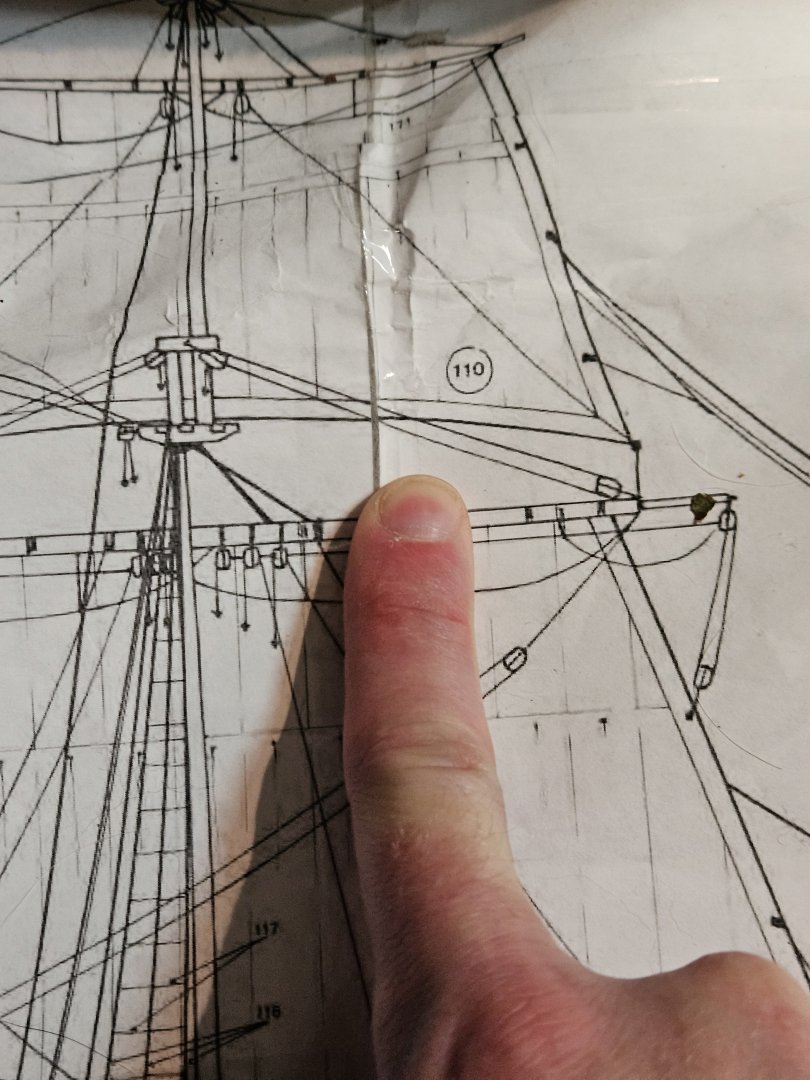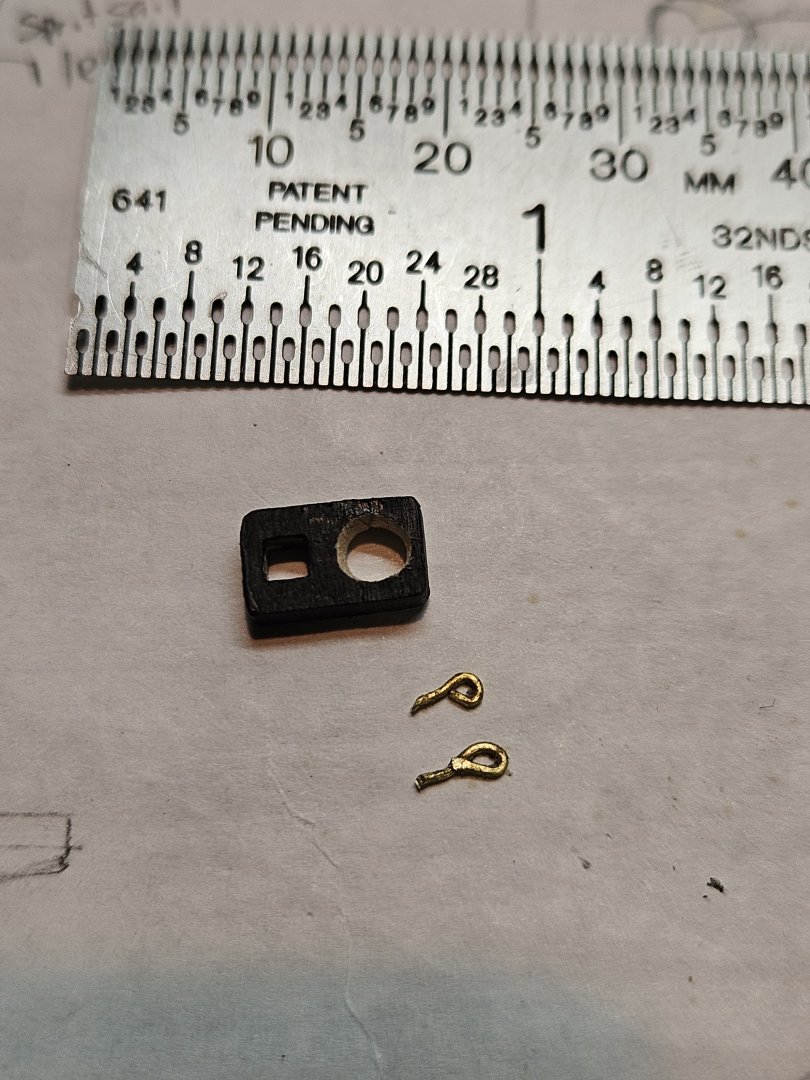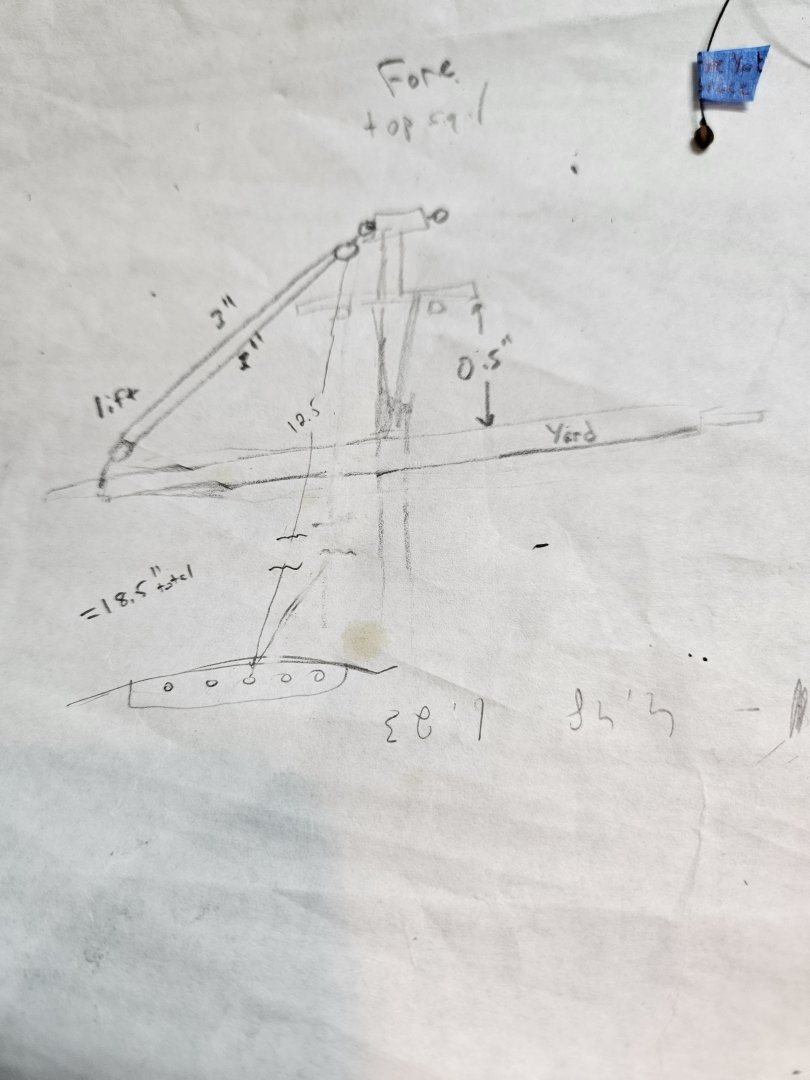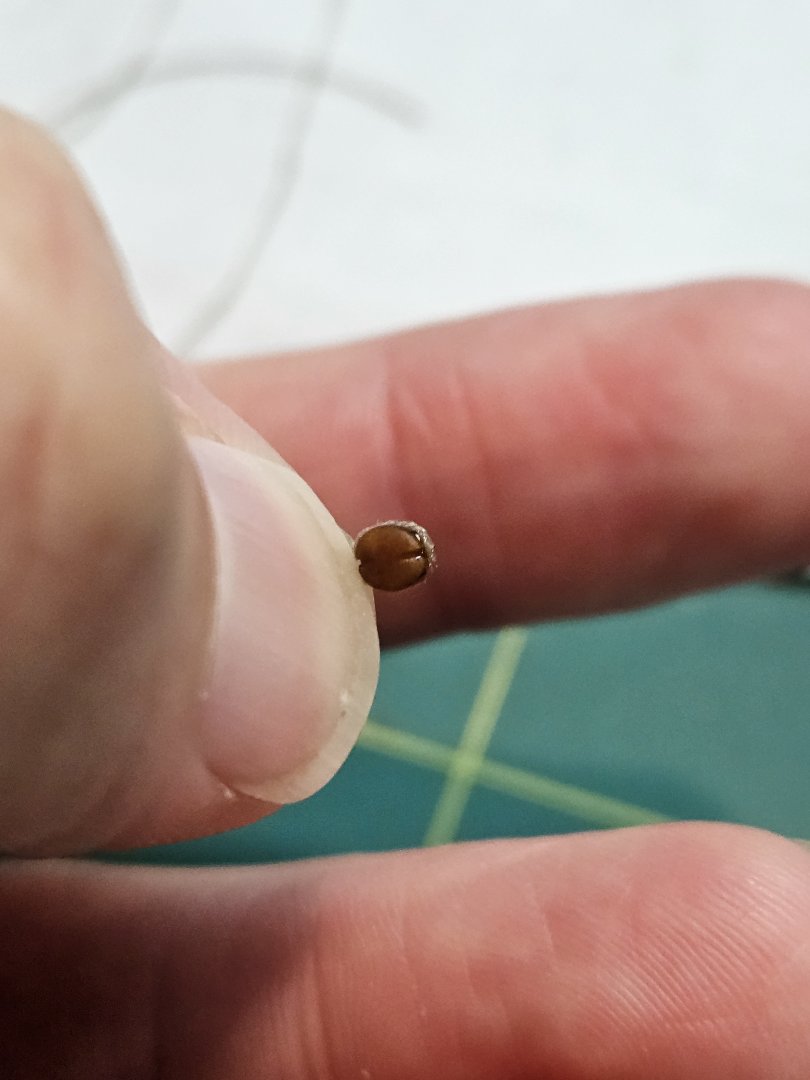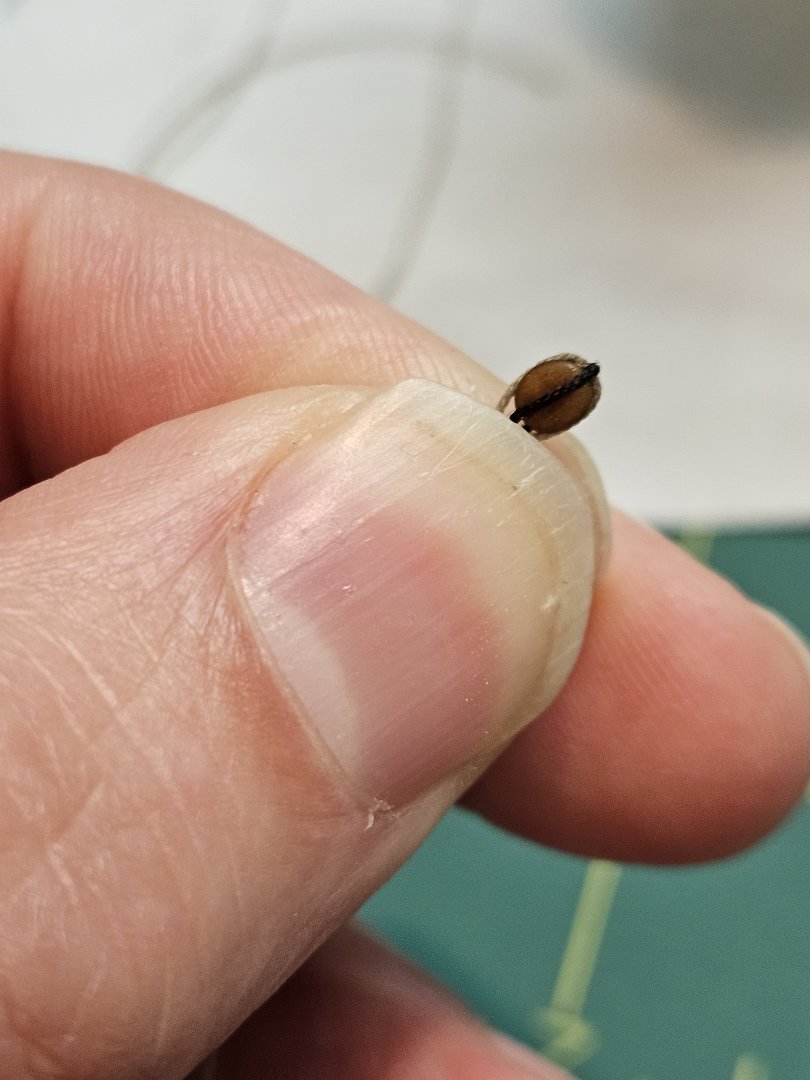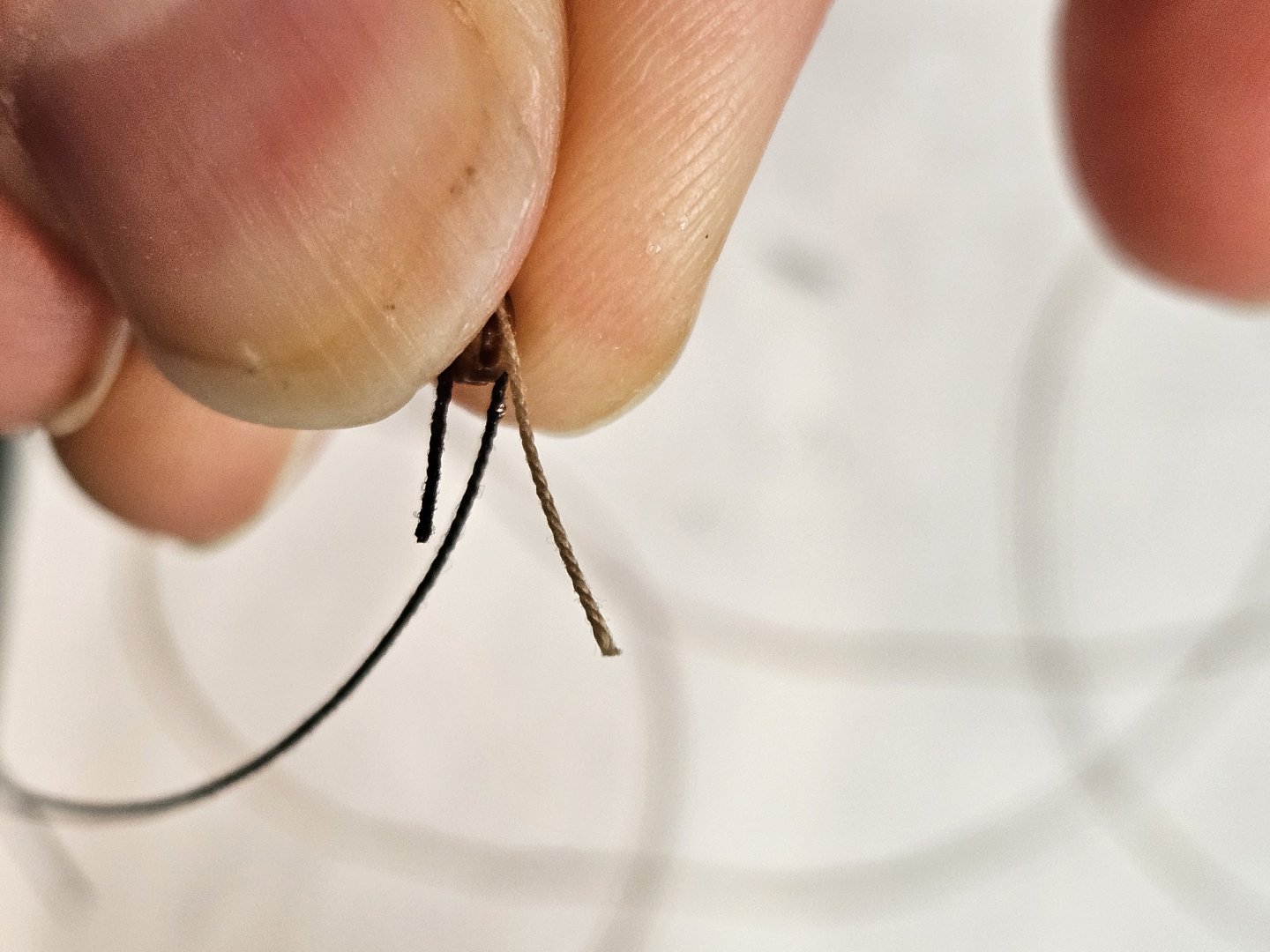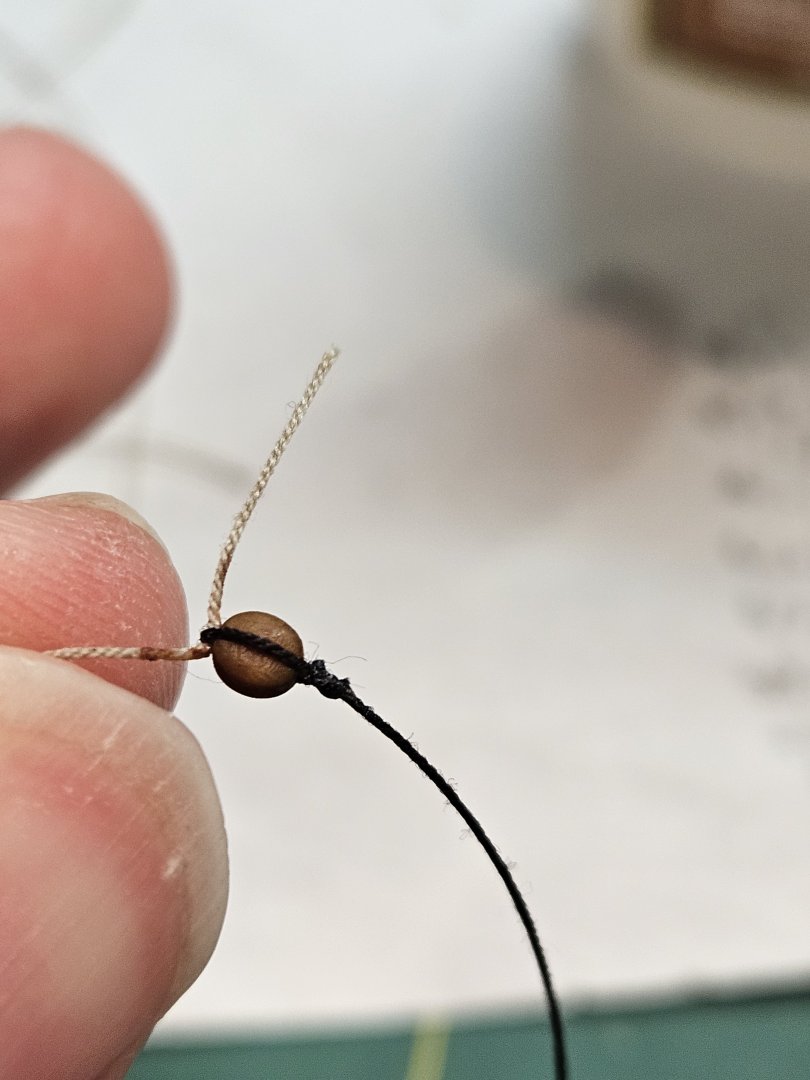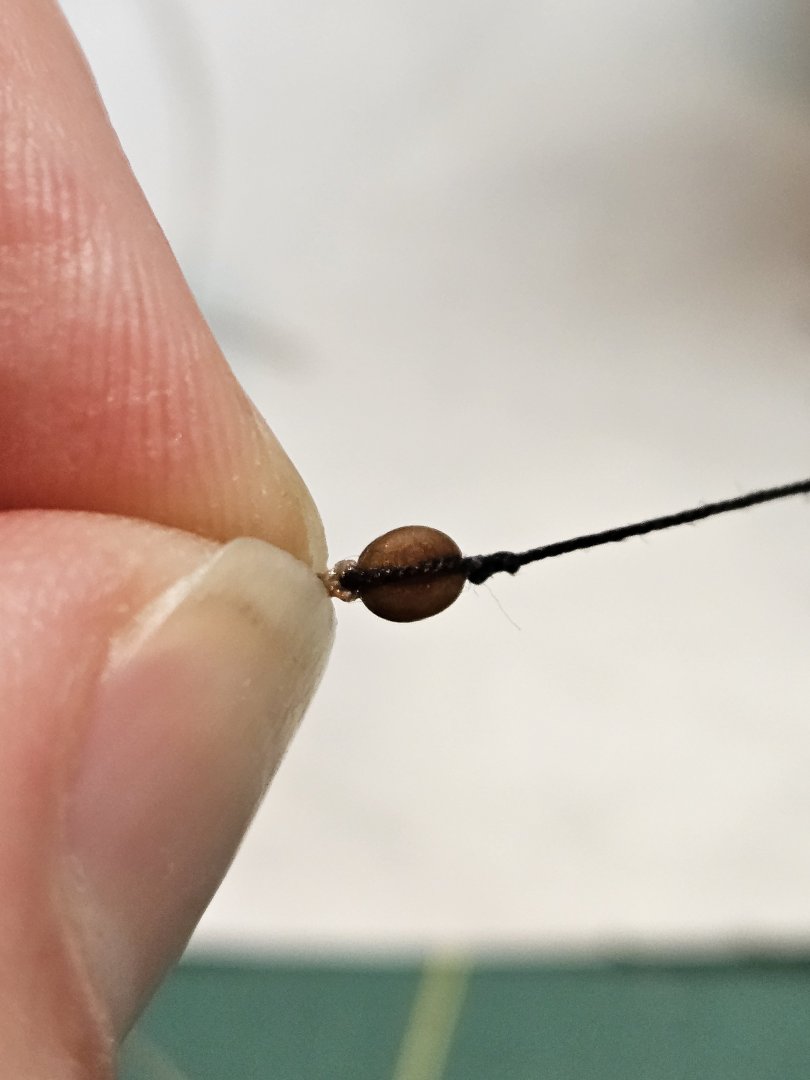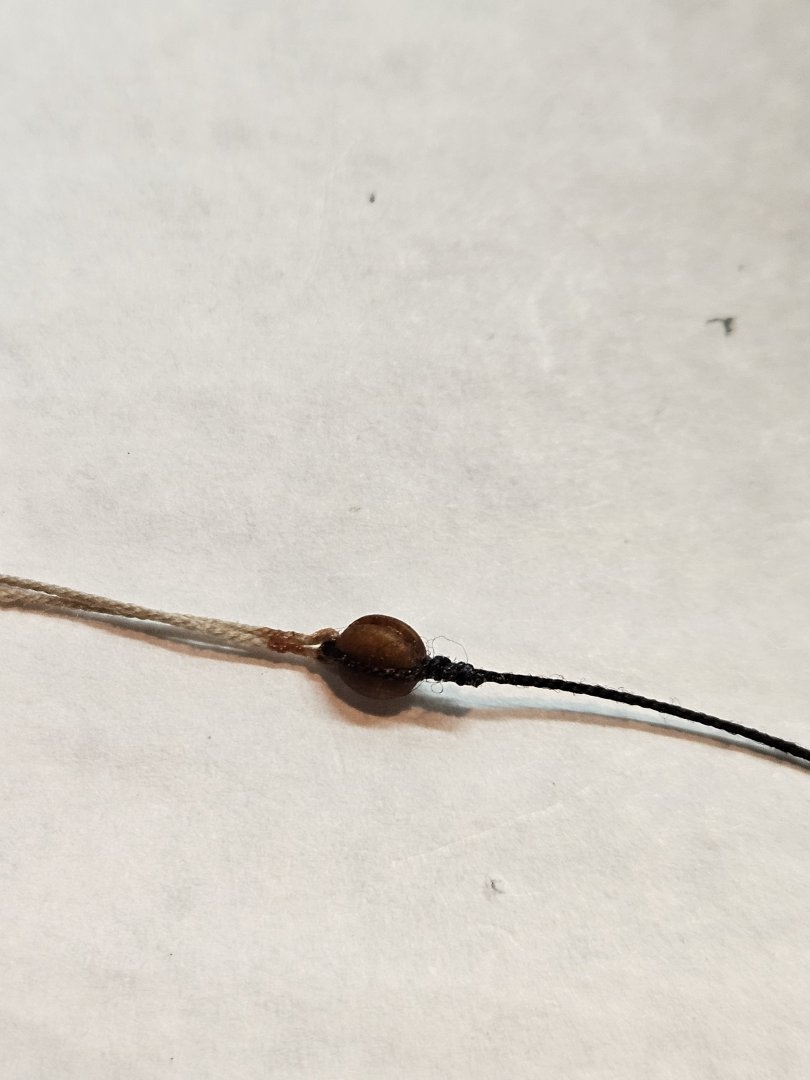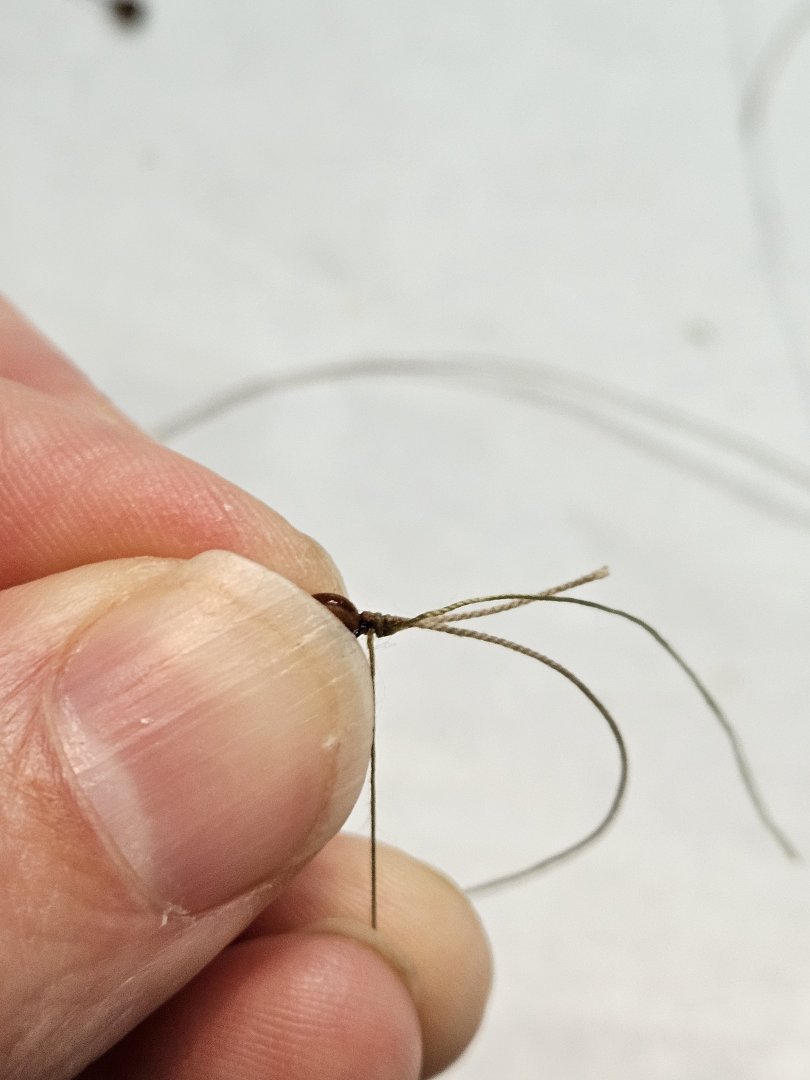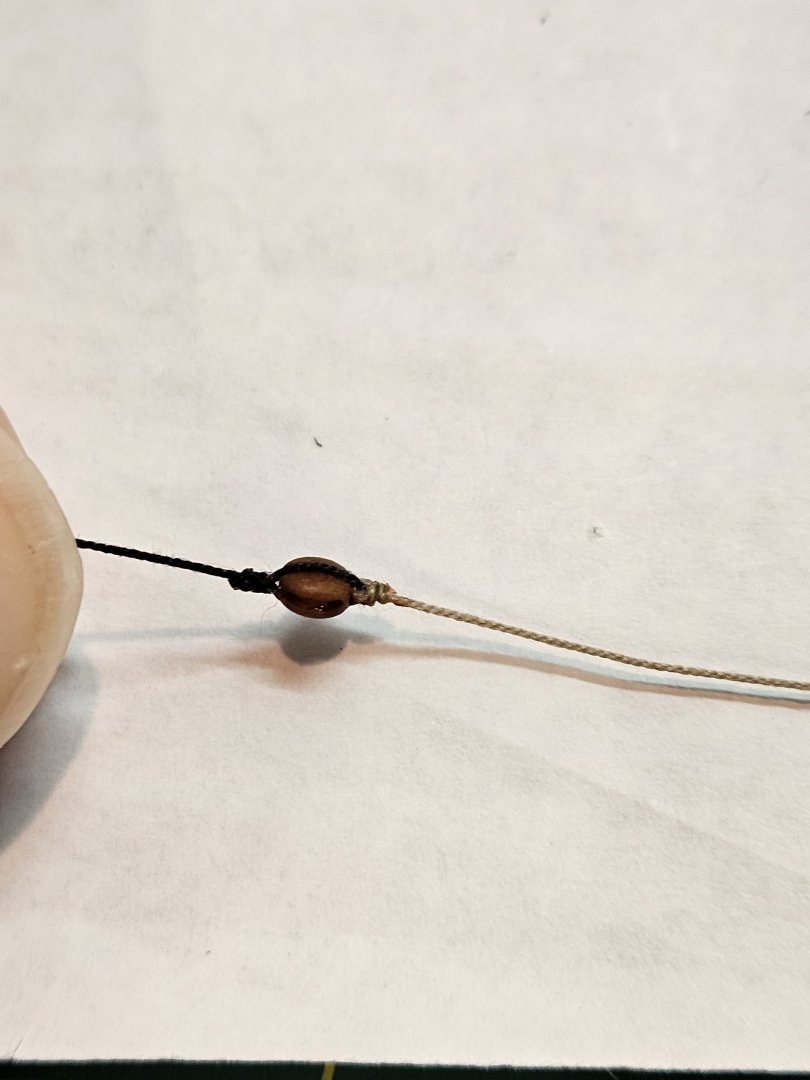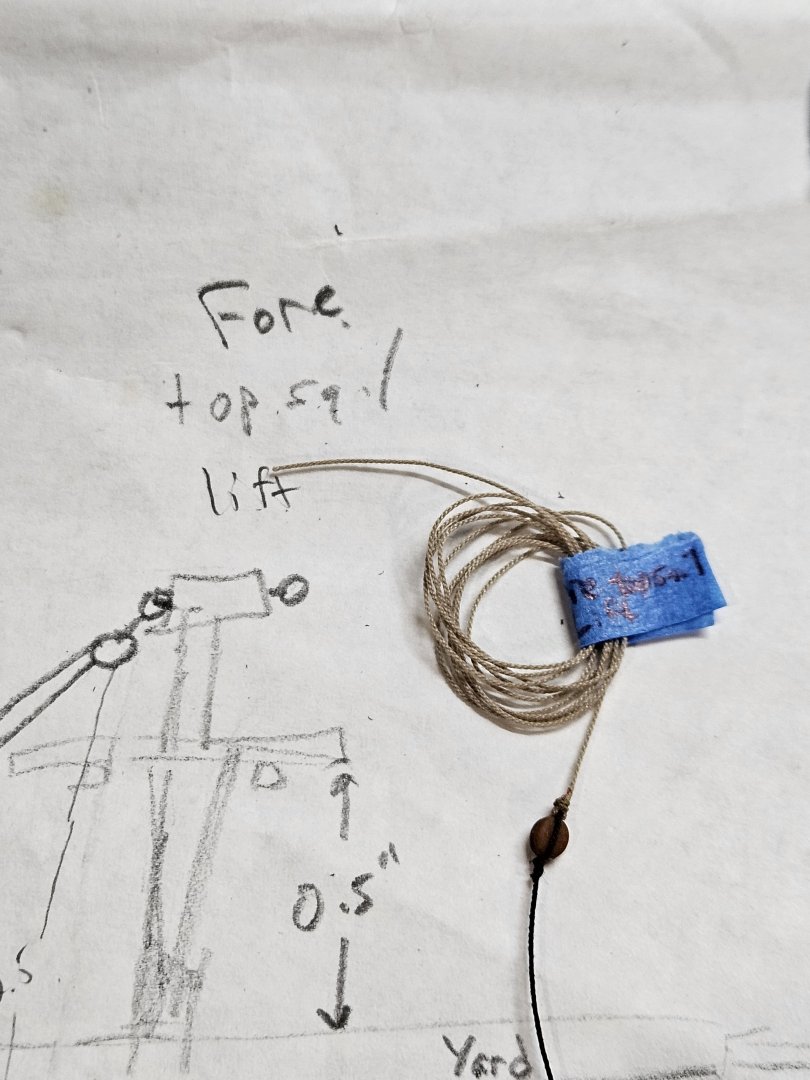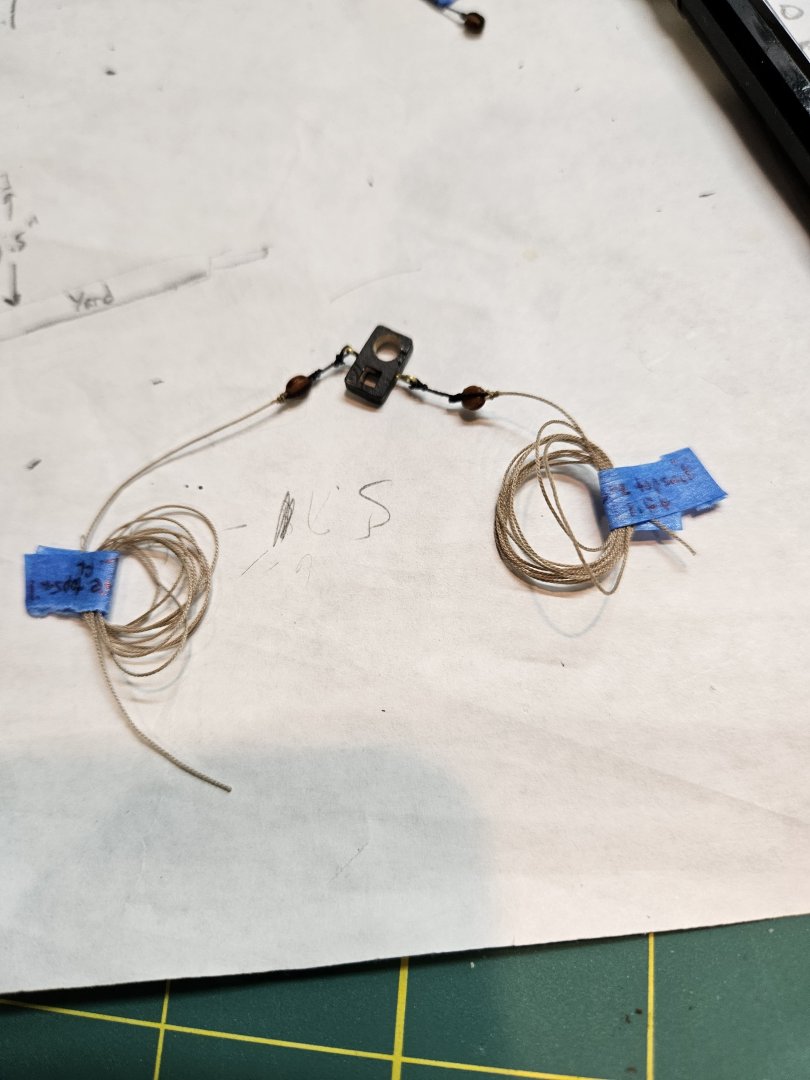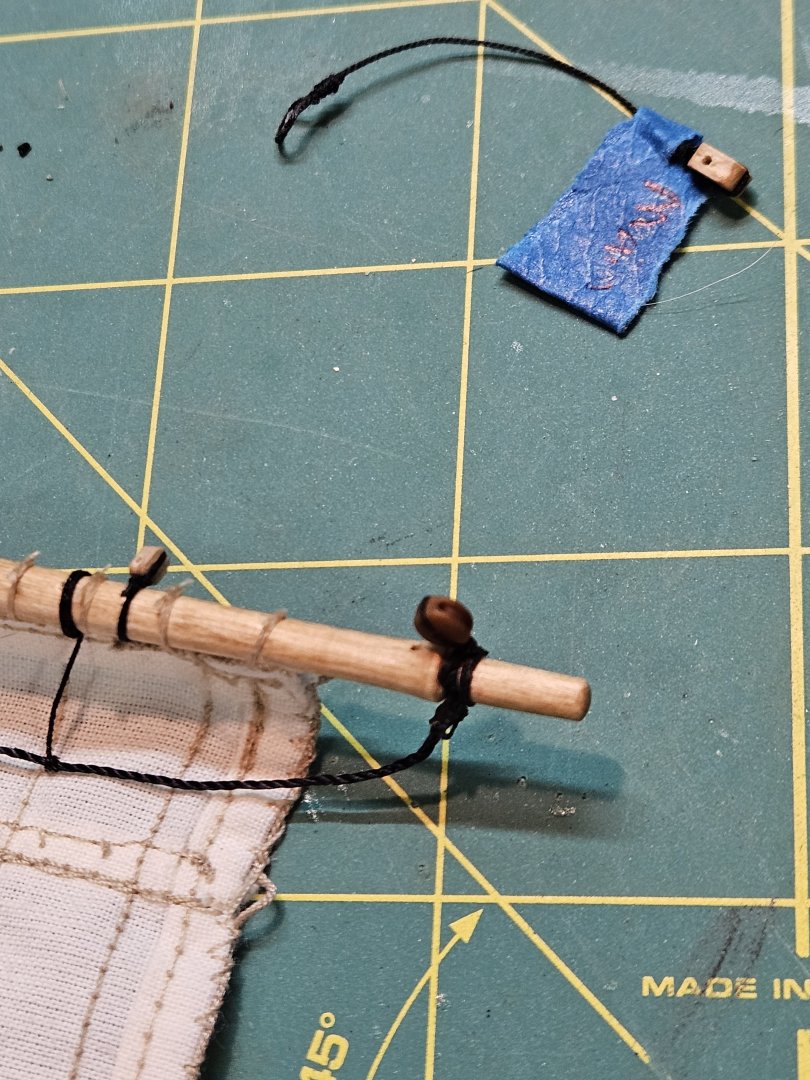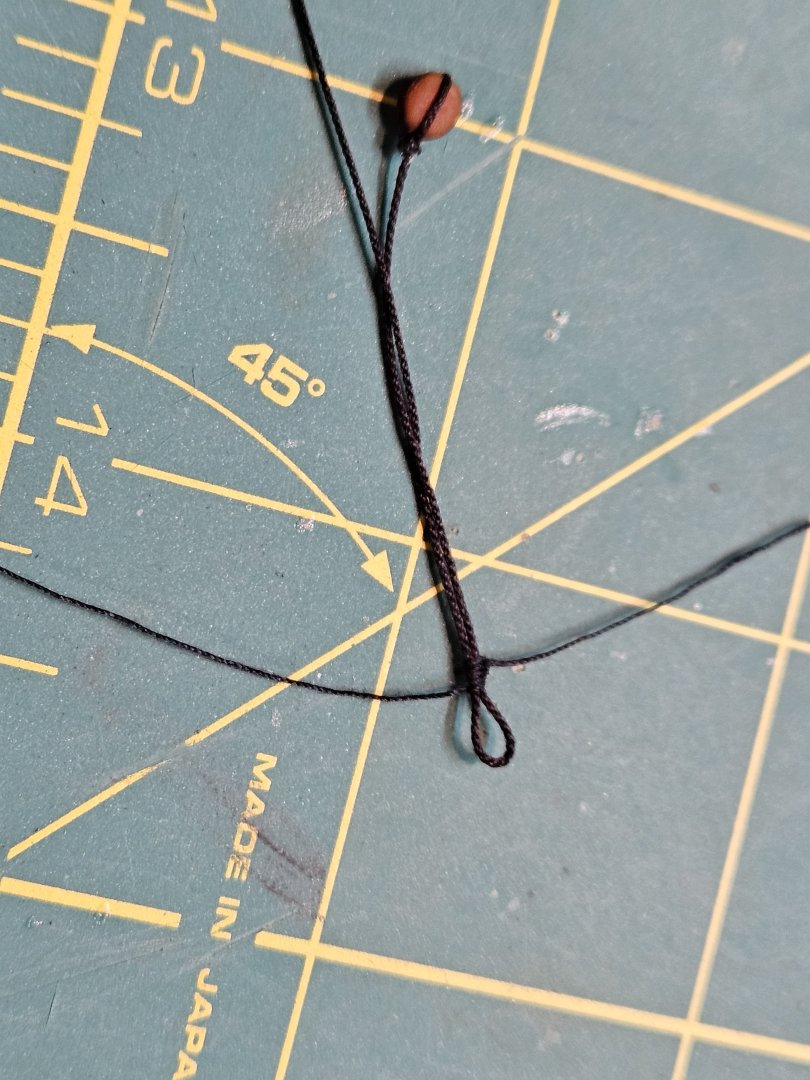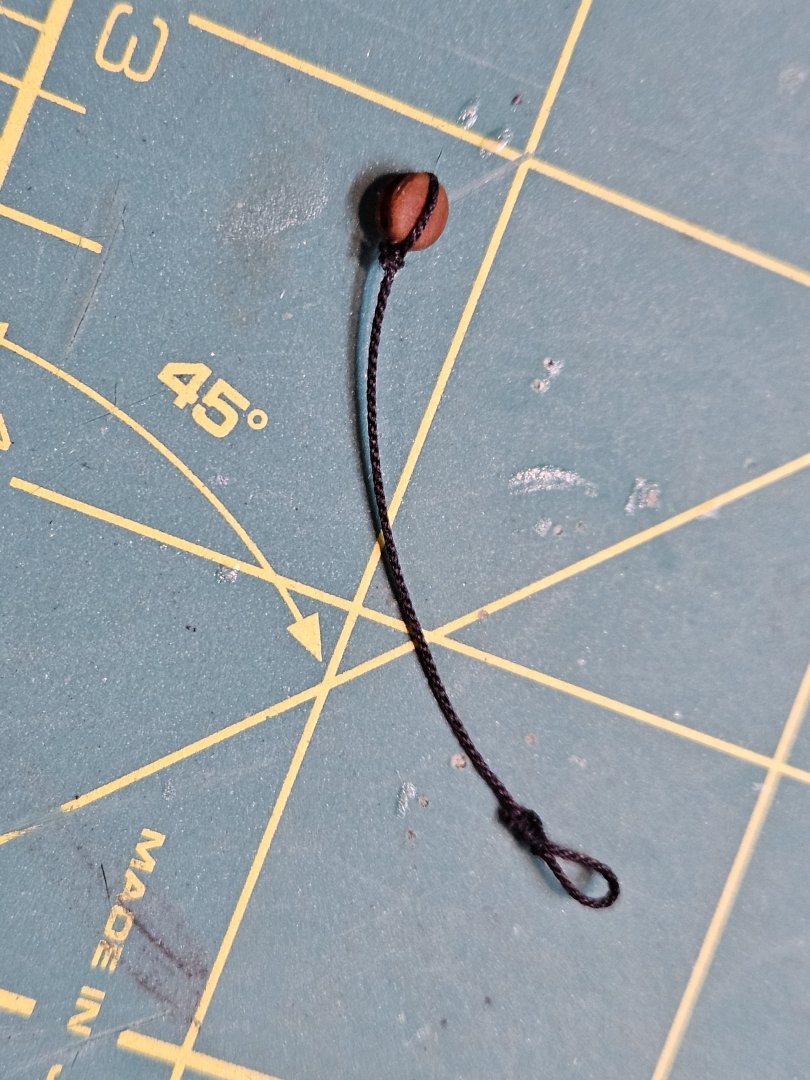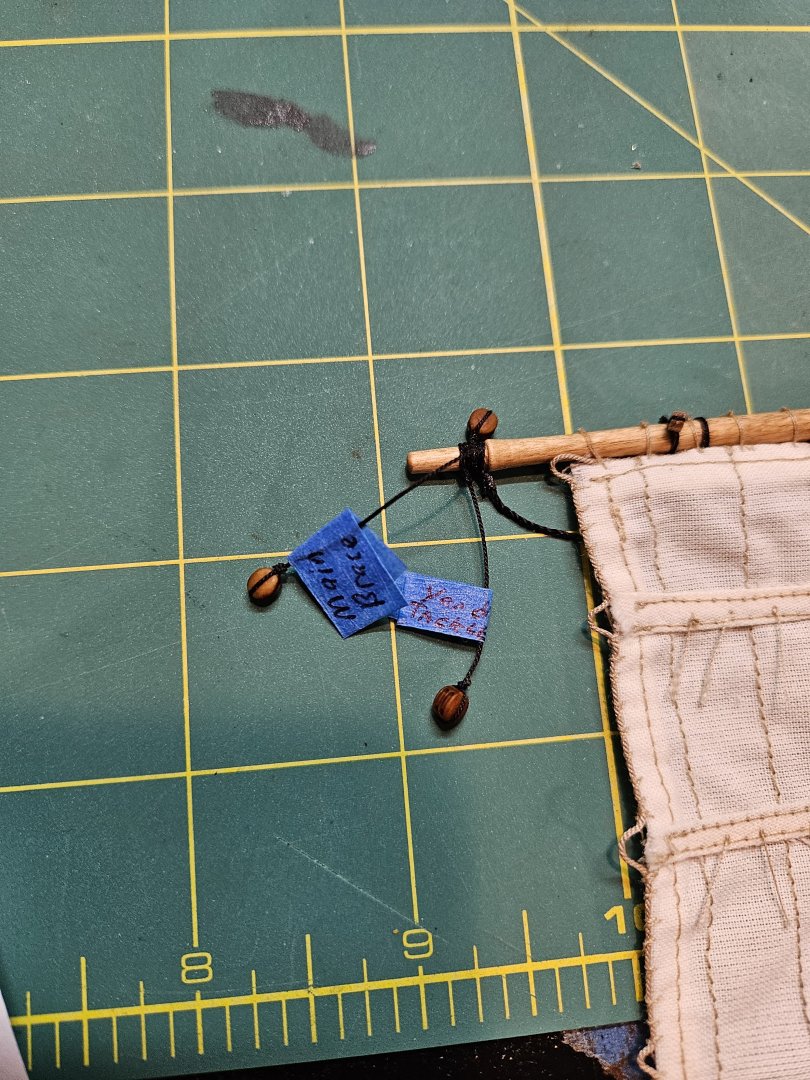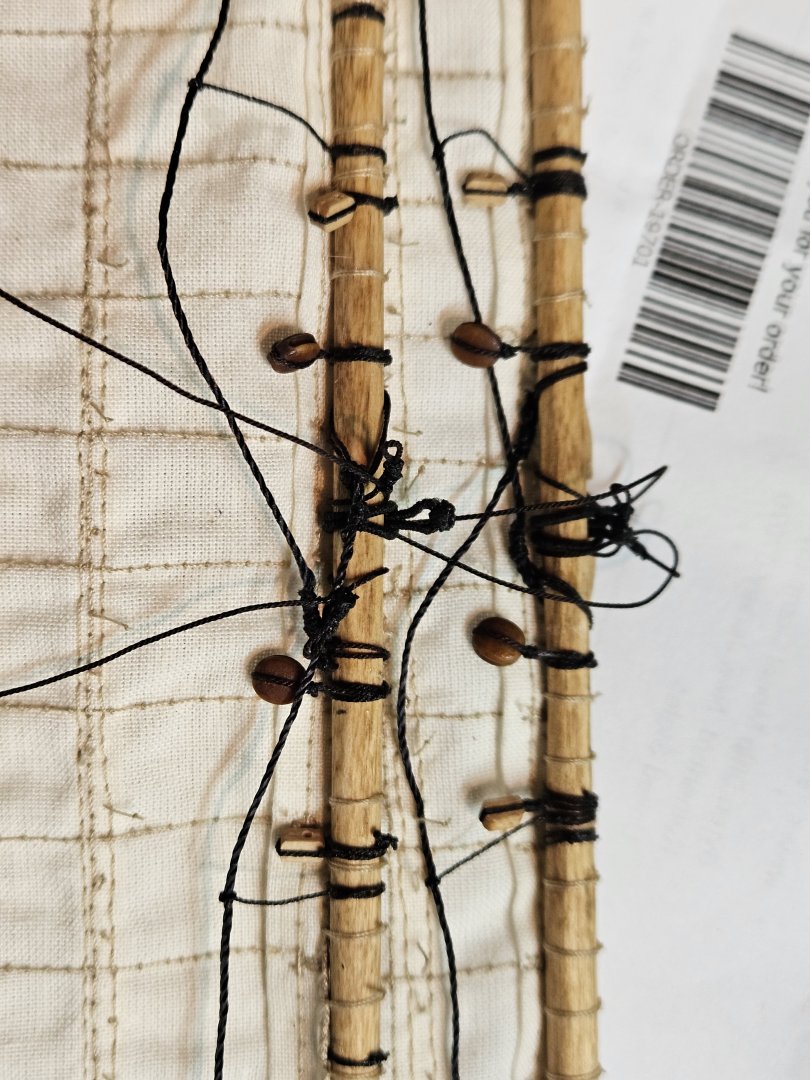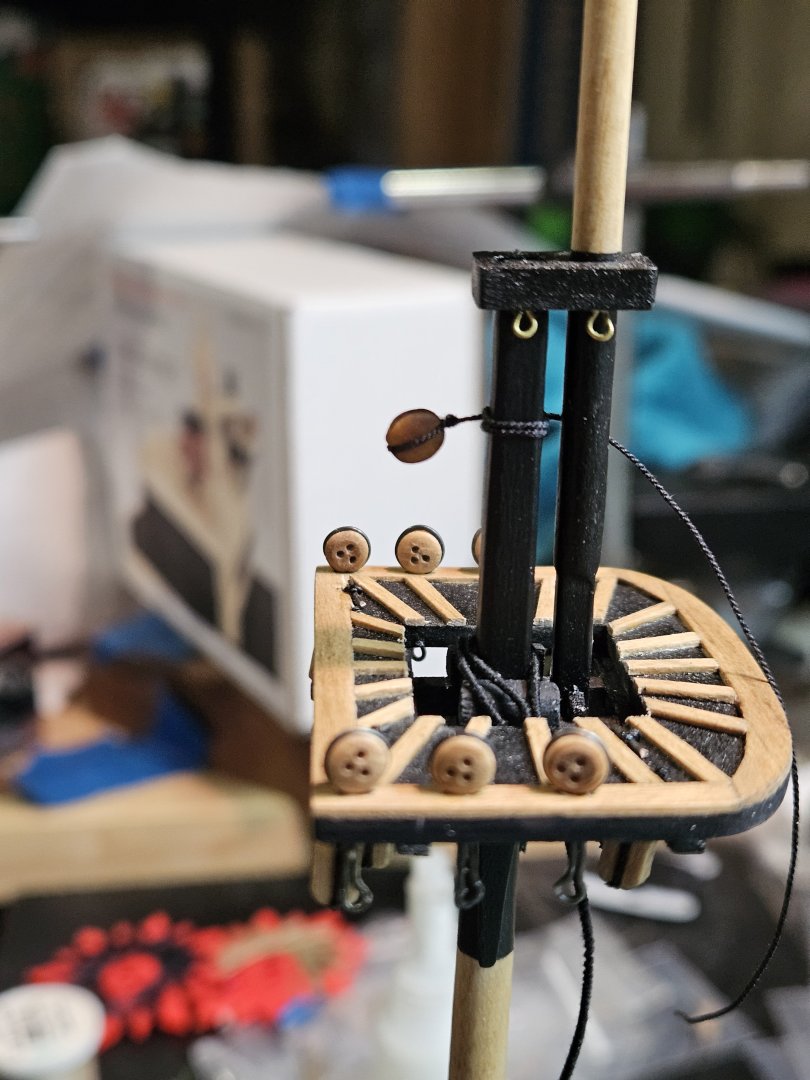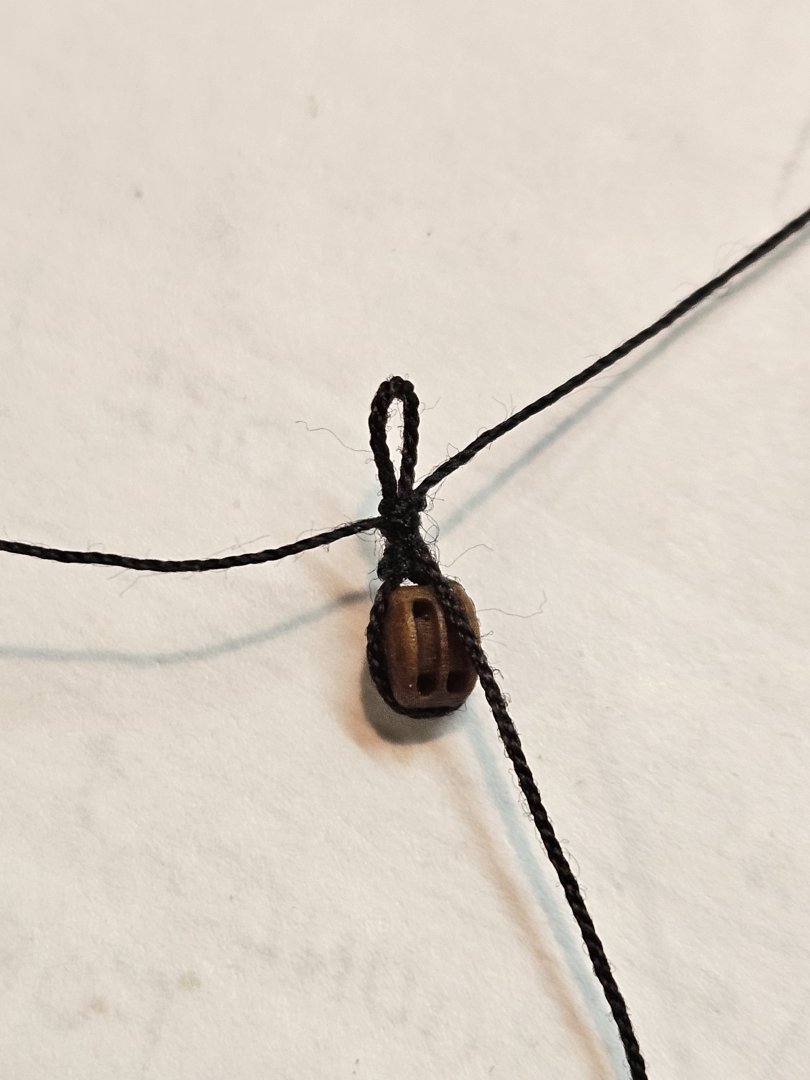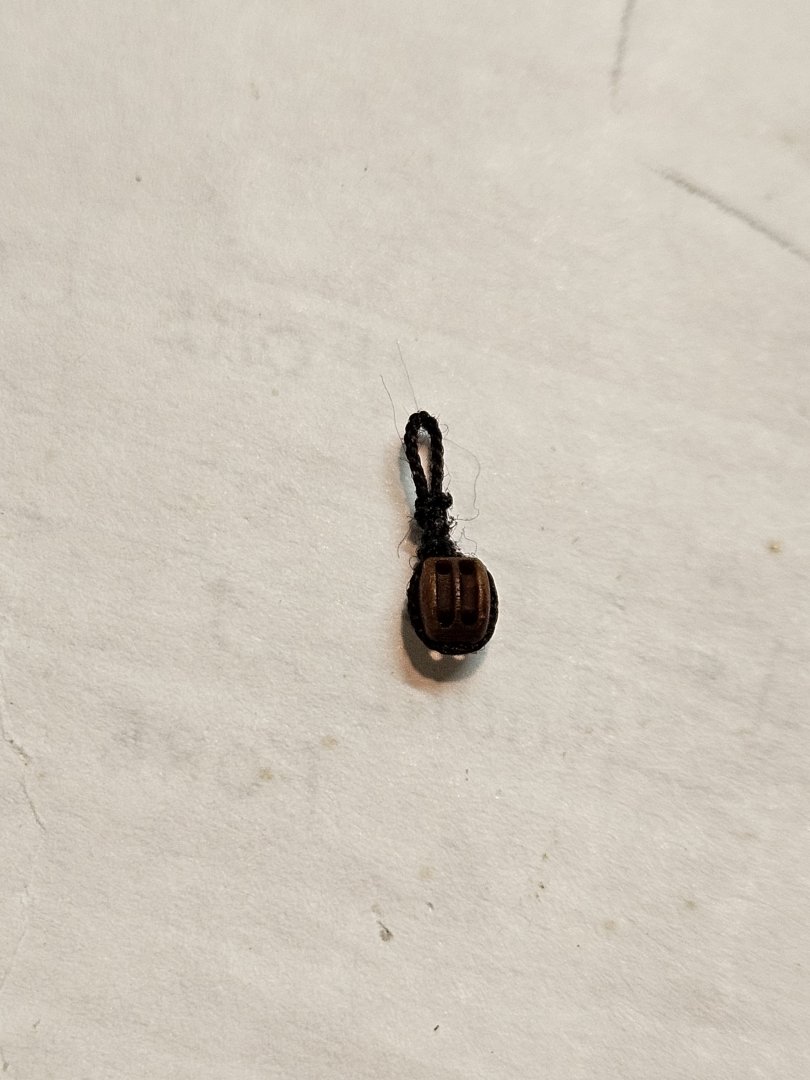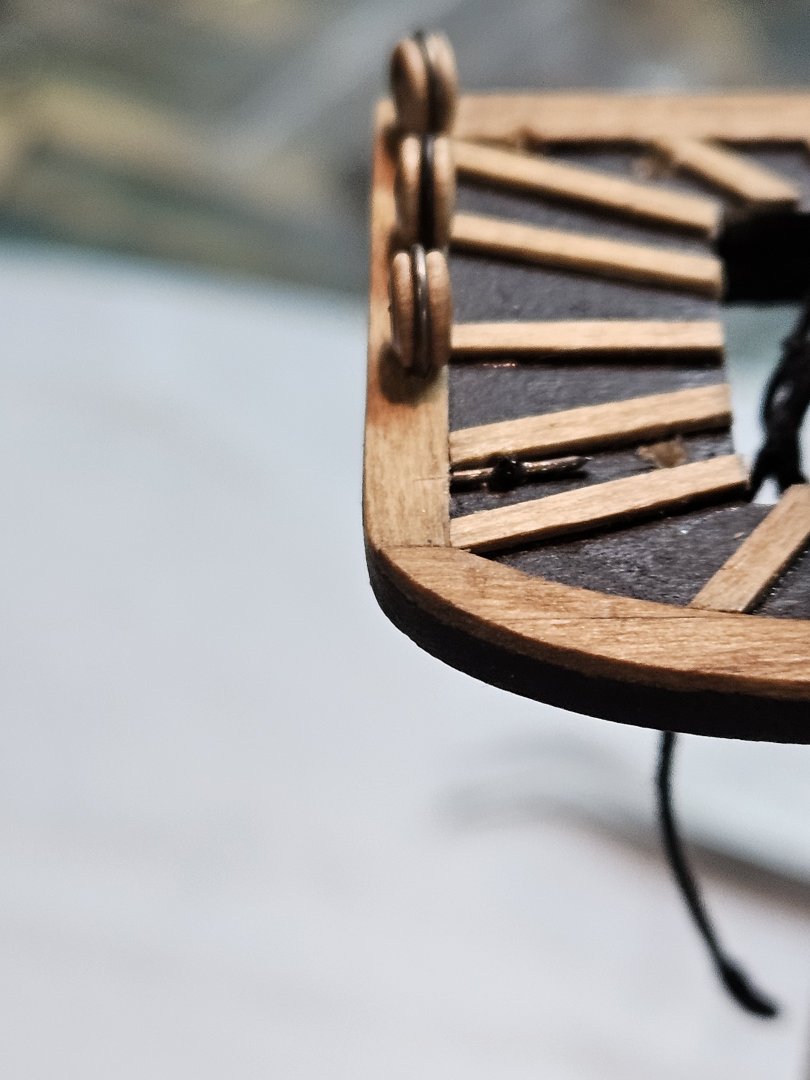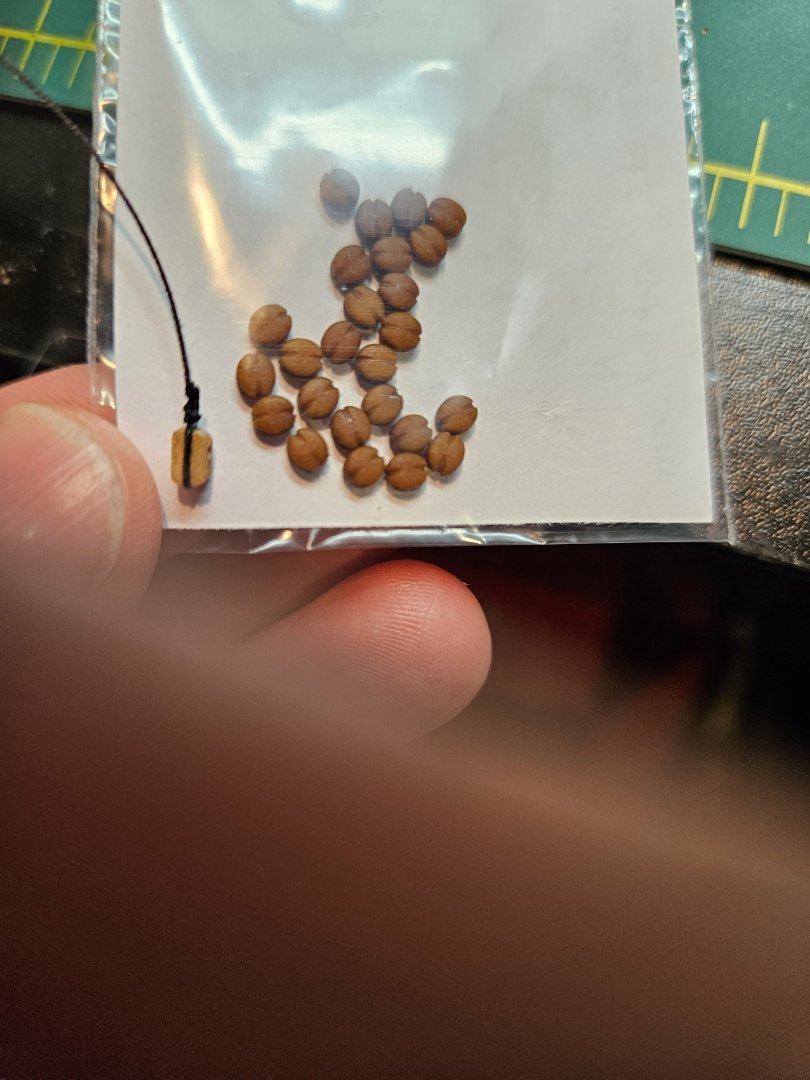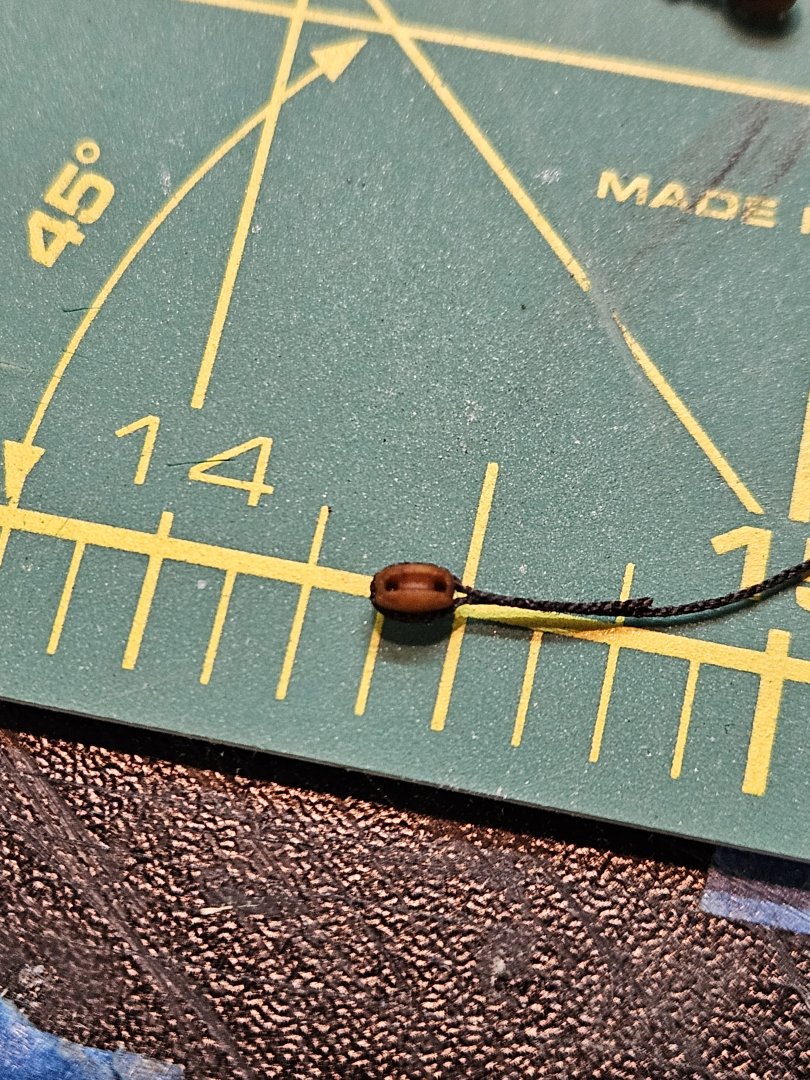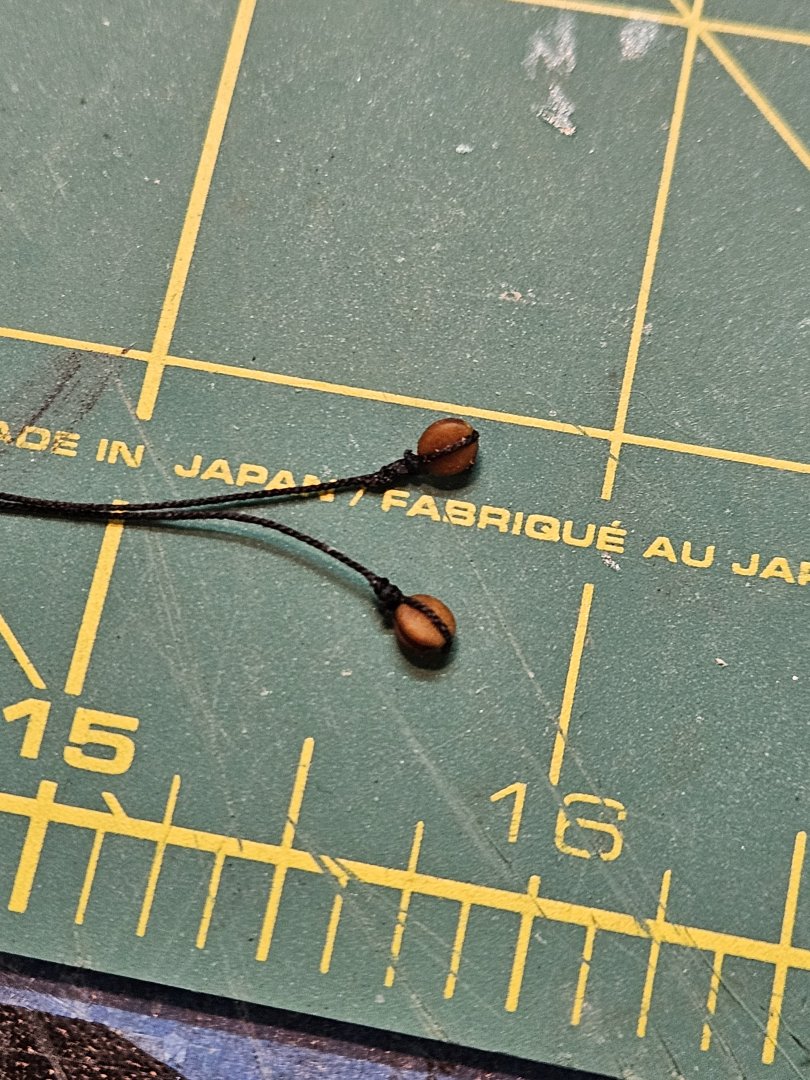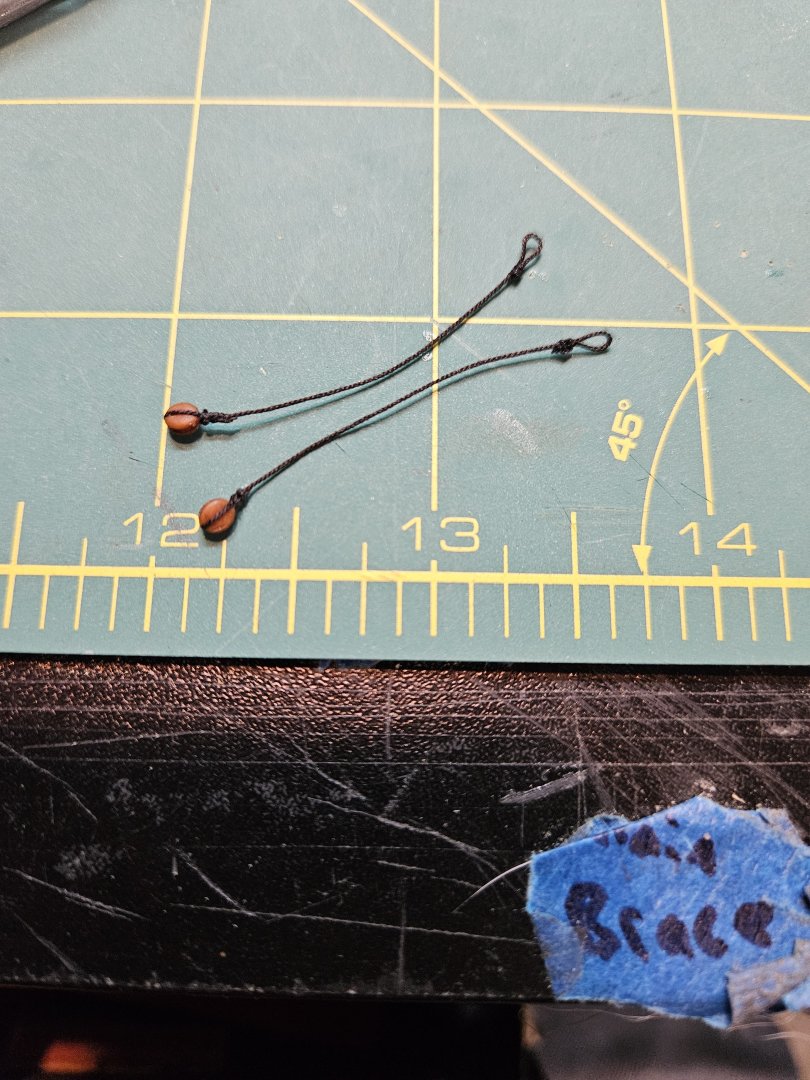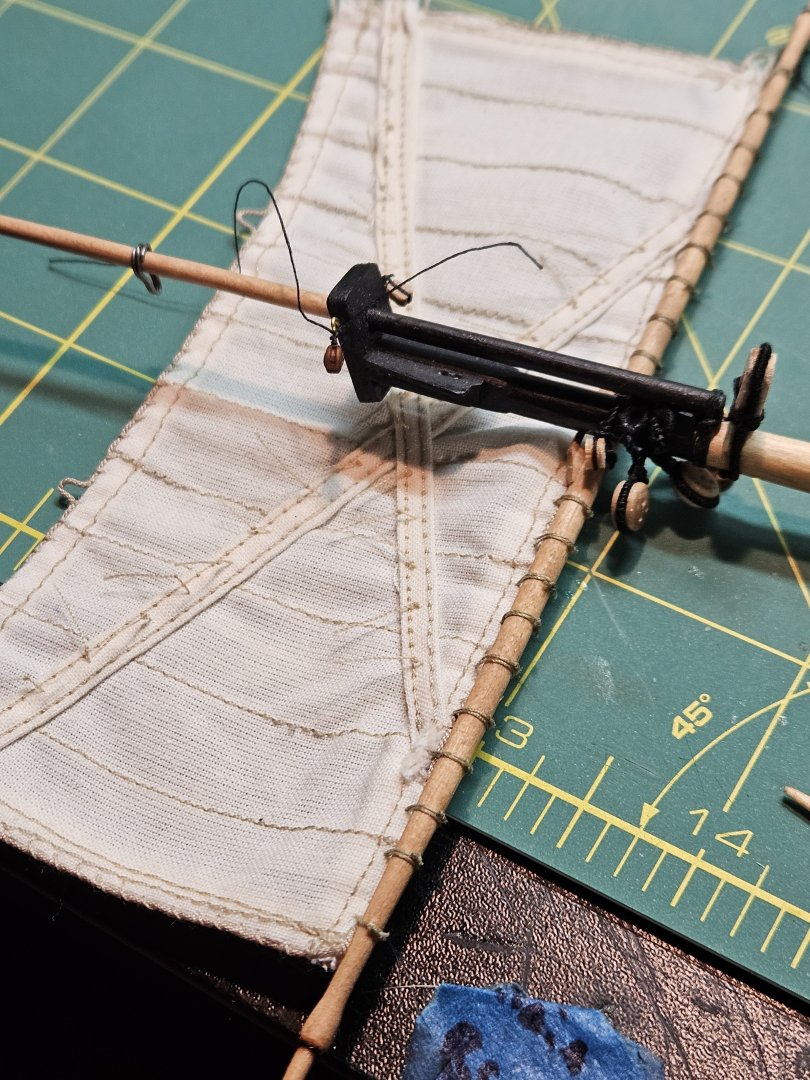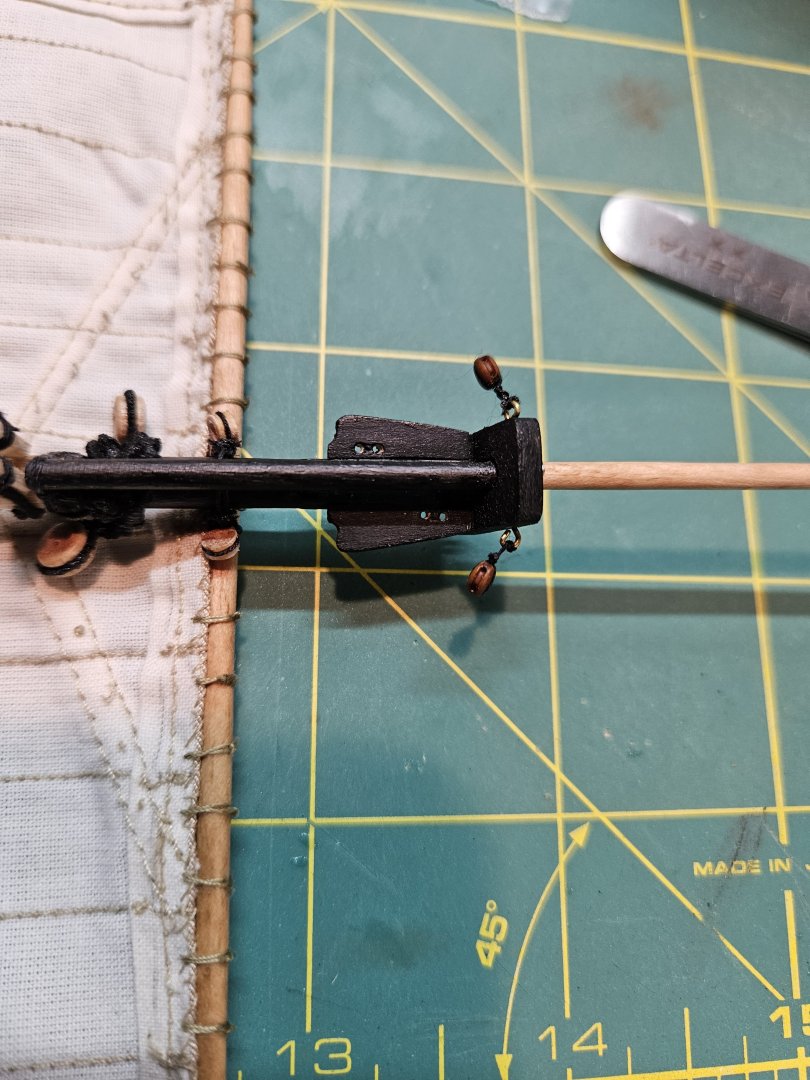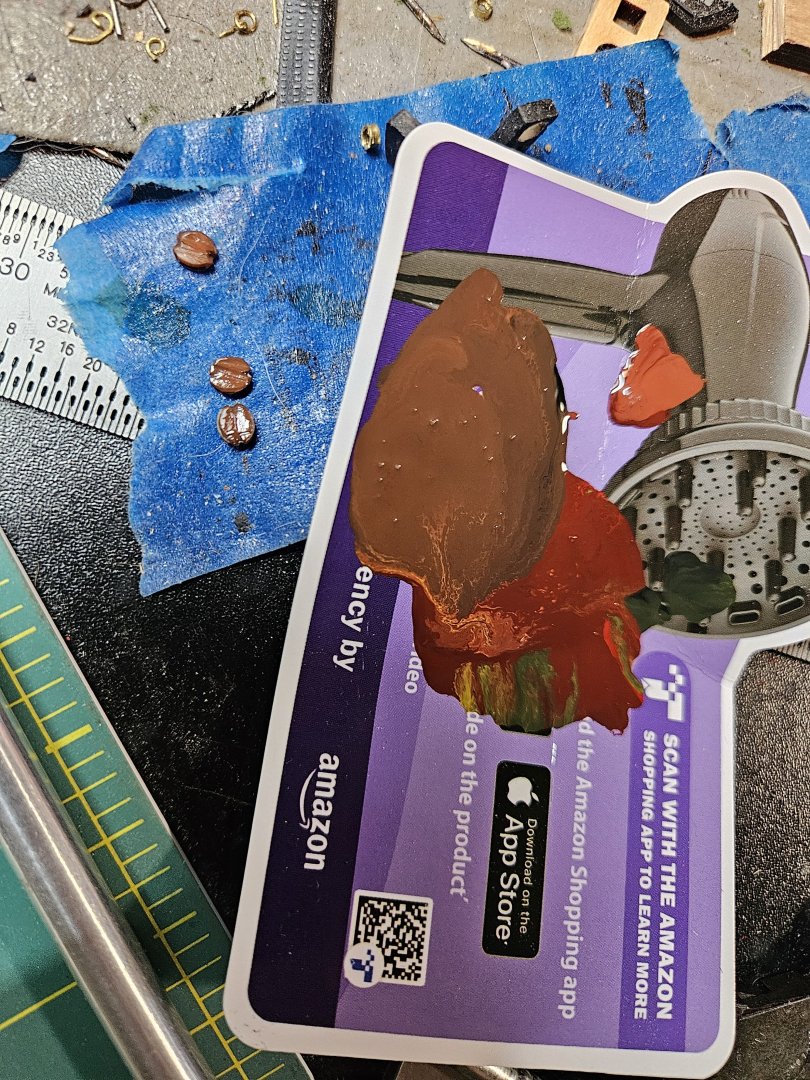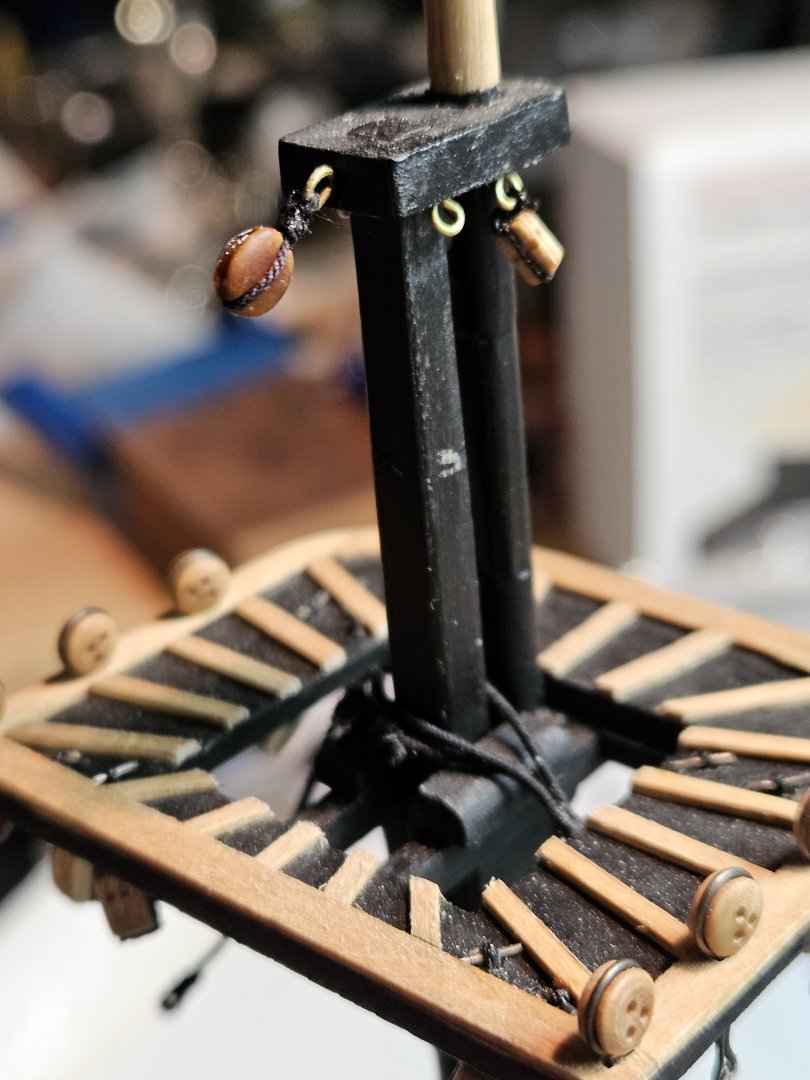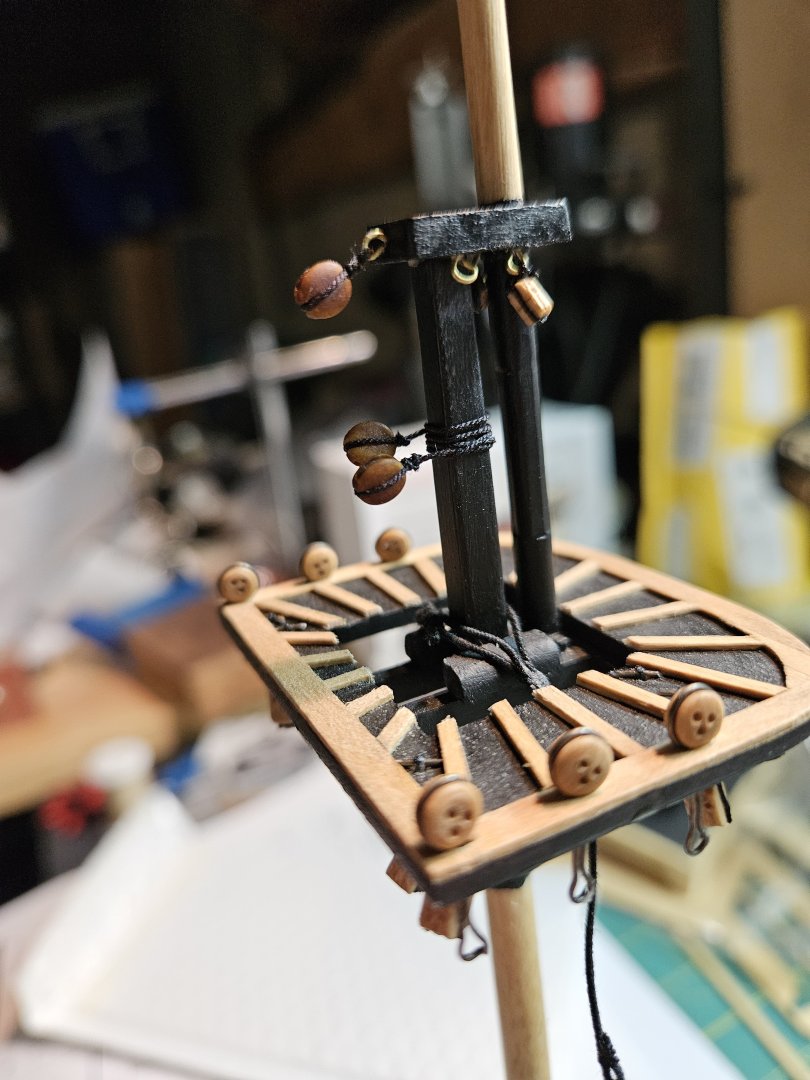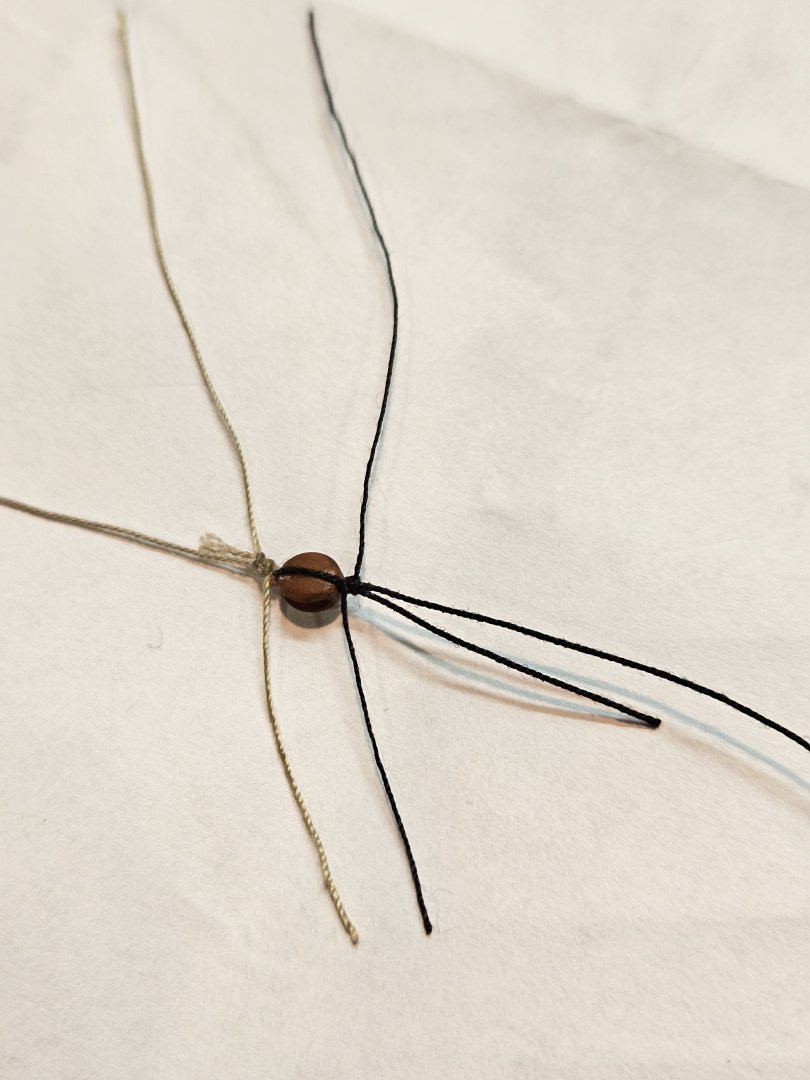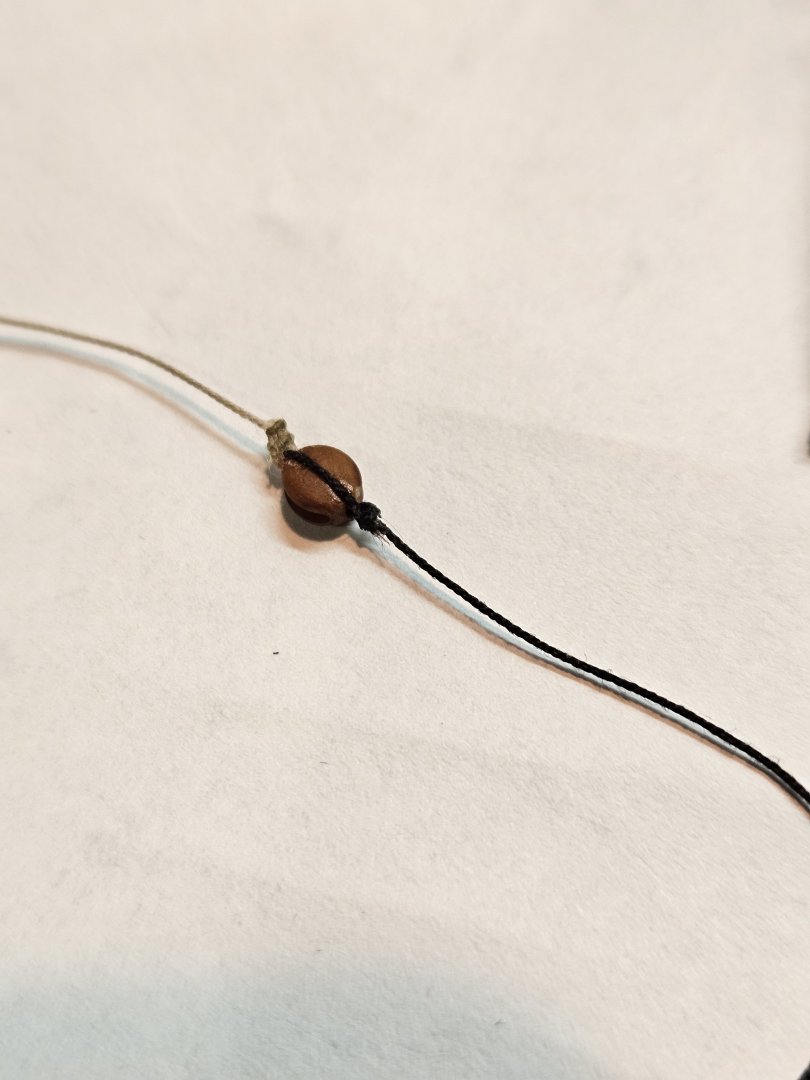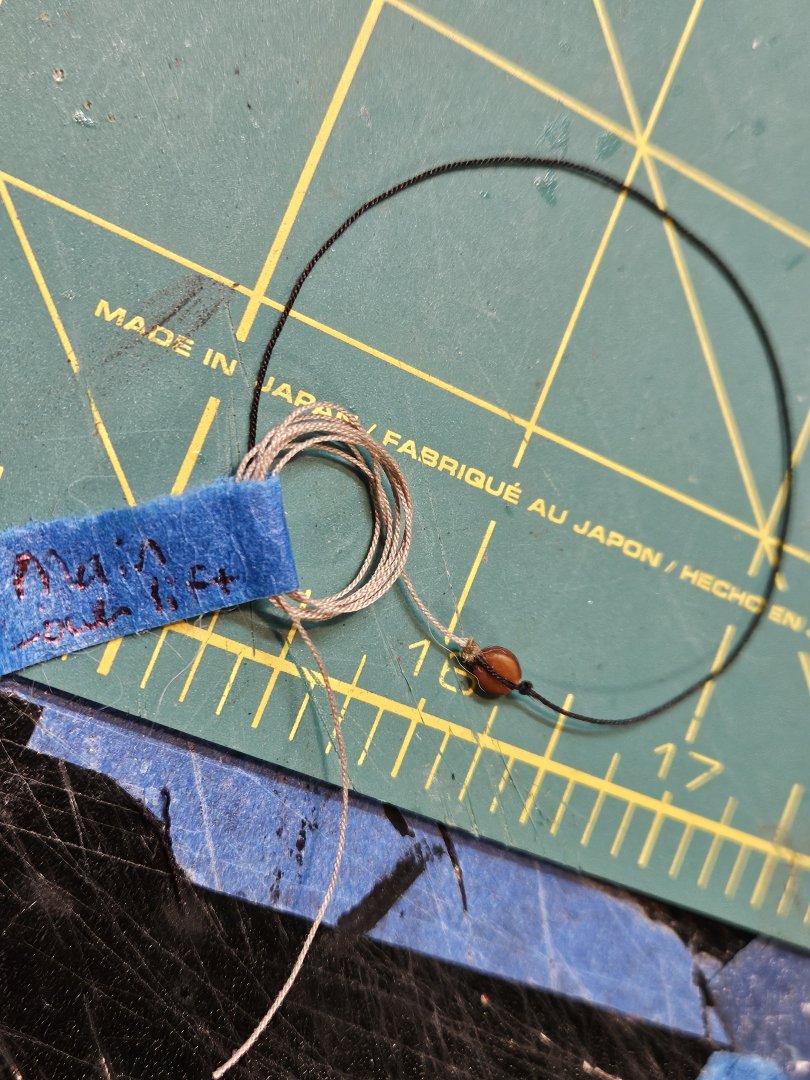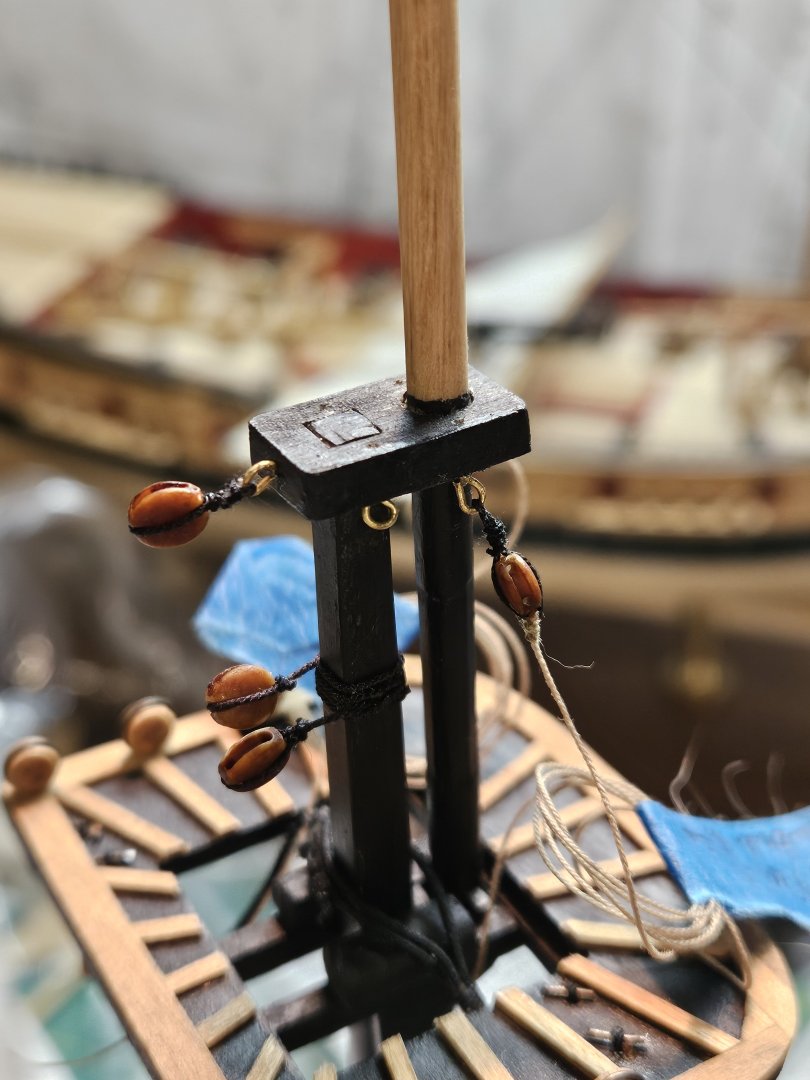-
Posts
114 -
Joined
-
Last visited
-
 ERS Rich reacted to a post in a topic:
Fair American by JLong - Model Shipways - 1:48
ERS Rich reacted to a post in a topic:
Fair American by JLong - Model Shipways - 1:48
-
 Coyote_6 reacted to a post in a topic:
Fair American by JLong - Model Shipways - 1:48
Coyote_6 reacted to a post in a topic:
Fair American by JLong - Model Shipways - 1:48
-
 dvm27 reacted to a post in a topic:
Fair American by JLong - Model Shipways - 1:48
dvm27 reacted to a post in a topic:
Fair American by JLong - Model Shipways - 1:48
-
 CiscoH reacted to a post in a topic:
Fair American by JLong - Model Shipways - 1:48
CiscoH reacted to a post in a topic:
Fair American by JLong - Model Shipways - 1:48
-
More steady progress with the Fair American There were some elements needed to be added on the channels, looking ahead at the rigging plans. The original rigging sheet shows eye bolts for lift blocks and halyards inboard on deck, but there really isn't room with the cannon right there. So, I'm adding eyebolts, etc on the channel instead, which is what is shown on the rigging plans. These sheets don't match, I'm finding. Also, adding eyebolts and blocks for the tackle, as needed. Once the shrouds are up, there won't be easy access for these later. Pre-drilled these holes for the eyebolts. I've learned, from doing the cannons, that its easier to attach a block FIRST, then put the eyebolt in. If you try to seize a block to an eyebolt after it's already installed, there's no access. So I hope I'm being forward thinking enough. Making the Fore Topsail Halyard ahead of time. This is the tackle; the brown rope end will go on an eyebolt BEFORE gluing it in place. The running end also starts FROM this block, so I coiled it for when I need it later. Its difficult (for me) to create a satisfactory becket at this scale, so I'm just going to make the 2-rope hook end look representative. I made a hook with some annealed wire, then looped the rope back over itself and seized near the block and the hook. I estimated the length from the plans. Once seized, I added some CA glue to stiffen just a little. Now they're hooked in place and ready for use later. I've also managed to add the Main Topsail to the yard, complete with bunt and leech lines. The reef points don't look as good as I'd like. I used pretty small (lower quality) rope at the time. I may elect to change them all out with Syren rope. There were so many!!! Next up was the Bowsprit Horse Netting. I doubt I'll get it to look anything near this, but the instructions aren't too bad. I made a crude, but to-scale drawing of the attachment points and features of the rope. I made measurements on the actual model for this. I'll use this as a template. I want to make the rope from one piece, so i don't use it all up, and I can serve it in sections, with extra. Thats the plan anyway. Sort-of like this. I added 'flags' to approximate where to serve, since the instructions call out the ends being served, not the whole length. After serving, I laid out the rope where I needed it, and taped in place. I'm using toothpicks as wooden spreaders. Now with the template, every thing is located how it will be on the model. I also raised up the toothpicks so I have room to weave underneath, and not directly on the board. I tacked the heavy ropes to the toothpicks on the marks I made and let them dry overnight. Then carefully seized with fine thread. These need to hold the rope spread, and not let go, so I made them pretty tight. Making little marks on the board for where the thread goes, helped somewhat early on. Clovehitching the ends was a bear - especially while holding them taught. Really tricky. The result is not very neat at all. The weaving took forever and the spaces are not consistent. The rope bowed inward, due to the tension. My fix was to glob CA glue on the rope, and push it outward with tweezers to let it dry in a semi-straight state. It helped a little bit, but could have been better. I attempted to dab the cross over points with glue and move them to position. After everything was dry, I stained the pole with some MinWax dark pine and trimmed the ends off. I didn't want to paint it black. It didn't turn out bad, but I wanted to do better. I won't install it until I have the stays in place, so it'll be stored for later. Next time, I'm doing the shrouds - another milestone! Deep breath! - Jason -
-
 JLong reacted to a post in a topic:
HMS Victory by dafi - Heller - PLASTIC - To Victory and beyond ...
JLong reacted to a post in a topic:
HMS Victory by dafi - Heller - PLASTIC - To Victory and beyond ...
-
 JLong reacted to a post in a topic:
Rattlesnake by Ed Ku20 - Model Shipways - 1:64
JLong reacted to a post in a topic:
Rattlesnake by Ed Ku20 - Model Shipways - 1:64
-
 yvesvidal reacted to a post in a topic:
Fair American by JLong - Model Shipways - 1:48
yvesvidal reacted to a post in a topic:
Fair American by JLong - Model Shipways - 1:48
-
 Ryland Craze reacted to a post in a topic:
Fair American by JLong - Model Shipways - 1:48
Ryland Craze reacted to a post in a topic:
Fair American by JLong - Model Shipways - 1:48
-
 JLong reacted to a post in a topic:
Fair American by JLong - Model Shipways - 1:48
JLong reacted to a post in a topic:
Fair American by JLong - Model Shipways - 1:48
-
 JLong reacted to a post in a topic:
Fair American by JLong - Model Shipways - 1:48
JLong reacted to a post in a topic:
Fair American by JLong - Model Shipways - 1:48
-
 Knocklouder reacted to a post in a topic:
Fair American by JLong - Model Shipways - 1:48
Knocklouder reacted to a post in a topic:
Fair American by JLong - Model Shipways - 1:48
-
 CiscoH reacted to a post in a topic:
Fair American by JLong - Model Shipways - 1:48
CiscoH reacted to a post in a topic:
Fair American by JLong - Model Shipways - 1:48
-
 Coyote_6 reacted to a post in a topic:
Fair American by JLong - Model Shipways - 1:48
Coyote_6 reacted to a post in a topic:
Fair American by JLong - Model Shipways - 1:48
-
 ccoyle reacted to a post in a topic:
Fair American by JLong - Model Shipways - 1:48
ccoyle reacted to a post in a topic:
Fair American by JLong - Model Shipways - 1:48
-
Continuing to pre-rig the Fair American model ship. Before the shrouds are rigged and in the way, I want to get as much on the masts and hull as I can. There will be sails needing additional halyards, so I'm attaching those now. The jib and main stay sails are first on the list.... For the stay sail halyard, I'll need a single block on an eye mounted under the main top....just a small one... I bend these by hand using the ultra fine long needle nose pliers: wrapping annealed wire around the very end of the pliers, then close the eye and then bend the stem straight. Trying to attach a block once the eye is in place will be near impossible to reach, so I'm attaching it to the eye first. Then it gets glued under the top, on one of the cross trees. I moved on to the fore and main burton tackle pendants. Based on the plans and estimating how much length needed to go around the mast head, plus some extra. I wrote the dimensions for Fore on top and Main under. I used the serving machine to make the .030in rope needed. I'm now using the fine black thread for serving, but I still struggle to make satisfactory eyes without them looking bulky, like the right one. After measuring lengths and taping in place, I'll cross over to form a middle eye, add some CA glue and 'tack' to each other. Then follow with seizing with fine thread. The result, again, isn't as neat as I'd ideally like, but it'll have to do. I'm figuring this out as I go, with no clear instructions on how to do this work. When slipping over the top mast, I ran into a problem with the fore burton tackle. the chocks. They were just wide enough to give me trouble sliding the eye down. I REALLY had to work on it, without breaking anything, but I got it down. Used reverse tweezers to hang the ends so they dangle more naturally. They're on there now! Before I do the main lower shrouds, I'm going to need to have access to the gaff and main boom for the spanker sheet now. The throat halyard is in a particularly tight spot. I made a very crude drawing of what I'll need: A block on the gaff jaws, and under the main top, a runner to another single block, with starting tackle for a double block attached to an eyebolt on deck, then belayed to the pin rail. Lots of lengths to get right, so I make sure to add in extra, just in case. You'll remember from several posts back, about how I attach the running and standing rope end (tan and black respectively) to the same block. The reason is the running end has to START on this block and go down; the rope needs to be attached to the block ahead of time. Now I can feed it through the eye made in the gaff jaws for hauling (halyard) up the mast. I'll need to figure out how to do a parrel of some kind later on, because obviously the instructions make no mention of one at all. Seizing the standing rope end over itself with a few turns, then trim close. That's as clean a job as I can manage. And on the after end of the main top, I added a single 4mm block, similar to the stay sail halyard block. This one was tied to the trestle tree and trimmed close. Still working on halyards, and the burton tackle pendants had to attach/hook somewhere on the top. I made a crude schematic for that too. Again, I won't easily be able to access or attach these blocks later on, so I'm making the blocks with running ends, and attaching to eye bolts and attaching the eye bolts to the top now. I won't let the running end of the halyard just hang there, so as with other rigging, I'm coiling it up and labeling with painters tape for later. Here is the finished result. You can see the empty eye bolts for the burton tackle ready to be hooked later. These details are not shown in the spar plan, so I'm discovering these as I go. So it may not look like a ton, but making all the blocks takes time. Plus double checking the measurements and looking at books and the Niagara plans as a guide of how rigging is done takes time. These details can't be rushed. I realize much of what I'm doing is probably not historically accurate, but rather made-to-work-for-me. Do other modelers have this much trouble knowing where everything goes, or is it just experience? As a model ship newbie, I'd love to hear how others have faired. Thanks for reading along. - Jason -
-
More progress on the Bowsprit of the Fair American: Now that the Gammoning is done, I've moved onto the Bobstay and shrouds. First I needed an eyebolt on each side of the bow stem. Just using some annealed steel wire to make little eyes. Once you get the hang of how to make these with the needle nose pliers, its not so bad. I apparently forgot to mount this years ago, so I'm adding it now. I also made hooks that will 'hook' the eyes for the shrouds. The bobstay will be the first to be rigged. I made a long length of .018 rope, and served it, leaving the ends long so I have enough to trim and mount later. I have a bag of deadeyes waiting, so this is the first one, since i mounted the fore and main deadeyes to the channels and chain plates years ago. Hard to see, but I wrapped the deadeye and tacked the ends close with CA glue, making sure to fold the ends over each other. Once they were tacked, I made a makeshift throat seizing with fine thread, then added two more short seizings mid way and at the end of the rope. Afterwards, the thread gets trimmed close with a razor blade. As shown in the plans, I made a little lanyard spacing tool to go through the hole in two deadeyes for a consistent distance every time. I measured the spacing from the plans a close as I could. The other end gets fed through the hole in the bow stem (which I had also forgotten to drill until now), then back over itself to form an eye. I pulled this tight, and tacked with CA glue and pinched with tweezers to hold until it dried. Once tacked, finished seizing with fine thread and later trimmed. For the lanyard, I made a sort-of figure 8 knot, as per the instructions, but added an additional knot so it wouldn't pull through the hole. I'm using .012in tan rope for the lanyard. After the lanyard is reeved, using tweezers to add some positive tension, while I tacked some glue on the bottom side of the rope to keep it from unraveling. From Petersson's book: Rigging Period Model Ships, it has this really drawing of the deadeyes. I am using this as a guide for how I'm going to do mine. So, after feeding above the deadeye, I made a few turns of the running end of the lanyard, CA glue tacked to stay in place, then seized the very end with black thread. Again, using tweezers to hold the rope in place until I'm ready to trim. It makes a very nice little lanyard. I prefer the tan rope to the black for this part, and I like the contrast it creates. Now for the shrouds, I added hooks to the ends to the eyes mentioned earlier. I have to somewhat guess at the approximate space for the deadeyes to go, since the plans show only a side view, but it has some lateral orientation, so its actually longer than is shown. As before, once I had the deadeye seized in, I have the whole shroud ready. Starting the lanyard and using tweezers to hold in tension while I tack with CA Glue on the underside. And finishing the lanyard with a few turns, to make it look all nice. When I repeated on the port side, it must have been an 3/16" longer, and the deadeye on bowsprit shroud must have been a little twisted higher, when seized: the port shroud is higher and longer than the starboard. Its not horribly obvious, but and obvious mistake on my part. I would likely have been whipped for this, back in the old days but luckily this vessel will not actually be put to sea. As long as you don't look down onto the ship from 3ft above the fore mast, you can't see it. I have a lot of other details to add to the ship to get it rigged, so I will move on. More pictures of progress soon. - Jason -
-
MichaelVitols started following JLong
-
 JLong reacted to a post in a topic:
HMS Bounty Jolly Boat by Peter S - FINISHED - Artesania Latina - 1:25 - First Build
JLong reacted to a post in a topic:
HMS Bounty Jolly Boat by Peter S - FINISHED - Artesania Latina - 1:25 - First Build
-
 JLong reacted to a post in a topic:
USS Constitution by The Bitter End - Model Shipways - 1:76
JLong reacted to a post in a topic:
USS Constitution by The Bitter End - Model Shipways - 1:76
-
Fair American by townpiper
JLong replied to townpiper's topic in - Kit build logs for subjects built from 1751 - 1800
https://www.shipmodell.com/index_files/0PLAN1C.html This is where I found them. The Fair American plans with sails are in there, but they are very challenging, since the kit doesn't come with instructions for sails. The sails need to be scaled up 1.1:1 to match the kit dimensions for the yards. Thats what I had to do. There is a significant amount of additional rigging needed for sails, which you will need to develop yourself. -
 JLong reacted to a post in a topic:
Speedwell Battle Station Kit 1752 by CiscoH - Syren Ship Model Company - 3/8" or 1:32
JLong reacted to a post in a topic:
Speedwell Battle Station Kit 1752 by CiscoH - Syren Ship Model Company - 3/8" or 1:32
-
Mounting the Bowsprit to the Fair American: This is the first ''mast'' that will be added to the ship. Once this is glued and gammoned, it isn't coming out, so I have to get this right! According to the instructions, I need 9 turns for the gammoning, using .025in rope. I could only manage 5, as you'll see... To start, I needed an eye, so after roving it through itself, I seized it with fine thread. And then trimmed it close. I doesn't need to be super pretty, since it will be primarily hidden in the gammoning, all said an done. I noticed one problem though: the bowsprit is very close to the head of the figurehead. According to the plans, it is supposed to be farther raised up. So I needed to fix this somehow. My solution was a small chock of 3/16" wide scrap basswood. With this underneath the mast, it looks more correct. So after sanding and painting, it actually matched up pretty well, even though this is a really close-up shot. Much better. I feel confident in the placement, so I can move on with mounting. I glued the bits to the deck, and the bowsprit to the bitts. This is my one shot to get it right, I can't/won't unglue it after this. I've been putting this off for a long time, so that I had all the blocks and other pre-rigging done before attaching this. While it dries, I propped it up on a little lathe tool box so that the bitts doesn't dislodge from the deck. I have to be EXTRA careful as I move the ship around now, so that I don't bump into the bowsprit and break something off. Up until now, I've been able to remove the bowsprit whenever I wanted. Now its time to start the gammoning. Making one turn over the mast, and then through the gammon hole. Following the steps in the instructions for working forward on the mast, and backwards on the gammon hole. After each turn, I would dab the rope with glue and let it ''tack'' before starting the next turn. I wanted this to be as neat as possible, so I'm pulling on the rope end as it dries so it won't sag later. I'm also tacking the gammon hole with glue so that the rope doesn't fall out of place as I wrap it. You can see how I've used reverse action tweezers to add tension while it dries. When I got to the 4th turn, I realized the gammon hole is not long enough to carry 9 full turns. I might get 5, if I'm lucky. There's no way for me to expand this now. The rails are already in place and I am not taking them off. There's no angle for a drill or a file to reach either without damaging existing rails. I'm going to resort to just 5 turns. This was a oversight 6yrs ago when it got drilled. The 5th turn almost broke me, and the ship. The 4 turns of rope were already really stuffed in the gammon hole, that I couldn't get it through. I literally spent 2 days trying before I fed it through. This consisted of stiffening the end of the rope with CA glue and stuffing it in the hole. Then it got stuck....majorly. I also attempted to use a needle to push it through - wouldn't budge. I also couldn't grab it with tweezers, because it wasn't long enough. I had to walk away one night, and come back the next day or I'd lose my cool. Finally after 3hrs of pushing with a tiny drill bit, there was just enough of the end peeking through that I could grab with tweezers. After it came through, it was really shredded. What a relief, though; I got it through. In the process though, on the port side, some things broke. Nothing important of course.... I decided to deal with this later, after I took a few days off to cool off. I needed a mental break. Of course, I also didn't make the gammoning rope long enough to finish the cross seizing, so I just tacked it in the middle on the port side. I used a separate length of .025in rope to do the cross seizing, then trimmed it short. The bitts needed to be glued some more, since it came loose. I just used some white glue on the deck line which dried clear overnight. Even though there are only 5 turns for the gammoning, it still turned out okay-looking. Last thing was glue the rails and knee back in place A lot of frustration, but the Bowsprit is mounted! A milestone for me! Now I have to not bump into it and break off the jib boom. Its starting to look like a ship now. Thanks for following along - Jason-
-
Progress at the bow of Fair American... Continuing from last week, another little block to stuff in 'somewhere' is the inner jib staysail downhaul block, as seen below. It goes aft of the cap, forward of the horse netting. Not the prettiest work, but it'll do. I am also starting to work on the Jib stay tackle. I made sure to add an eyebolt on the front of the cap to attach this block. Again doing the 'tack' the rope ends with CA glue first..... Then seize it with fine thread. I rigged the fid block with the running end, and the long standing end of the Jib Stay. I rove the standing end through the sheave in the jib boom and coiled it for later. I really didn't want to try to seize the block at a later time and risk bumping into other elements. It'll dangle a bit for now, but I'm okay with that. It also gets fed through the traveler that I smartly added to the jib boom before attaching previous blocks. I don't want to have to bend it to shape WHILE on the boom. Another thing needing to be added was the traveler downhaul. I'm using .008in tan rope for this, and the fine white thread for seizing. After the glue dries, it turns the white a little darker, so it blends pretty nicely once it's all trimmed up. Next came the spritsail yard lifts. I made small eyes with .012in tan rope. All the ends get trimmed neatly before adding to the yard, obviously. Just showing the technique, a bit... Now I was just having some fun, after feeding through the block. Seeing how the lift adjusts the yard by pulling on one rope or the other, was too cool. Maybe in a future build, decades in the future, I'll have a motorized rope action of some sails/lifts/halyards I am just about ready to mount the bowsprit to the ship, and add the gammoning. Nervous and excited. HOWEVER - the chocks for the gammoning rope is too far forward on the bowsprit. You can see the unpainted gammoning hole, just above the head rail. If I leave it, the ropes will be overly angled forward, and not in a pleasing way. They have to be moved back. So I took them off, leaving most of them intact, and sanded the mast down smooth. I marked with pencil lines where the aft ends of the chocks are supposed to go. Then I reglued them. They actually look a bit better than they did previously, in my opinion. I added a little bit of golden oak stain to the original sanded spot, and it blends in nicely So now they're back in a better position...I'm happy with the fix. Up next is the gammoning, and mounting the first mast to the ship! Fingers crossed Have a good week. - Jason -
-
Thanks Greg for referring to my build. Paul, looking at your build, I think the filler blocks are in the wrong location. The thicker/meatier part of the block should face inwards towards the sternpost, and the pointed end faces outward towards Port/Starboard. I think if you take the starboard block and put it on the port side, with the pointier side facing port, and the opposite for the starboard side, it will be correct. These blocks are meant to shape the transom to the sternpost. Not sure if that makes sense, but I believe that is what is going on. I will admit, that the transom 'shape' took some long term staring at the plans to get right. Some of the frames are tilted outwards just slightly, and it took me a while to really understand how it is constructed. Good luck! Jason
-
Continuing to make progress on the Fair American: Prepping the fore Topsail with buntline and leechline blocks. It's much harder to clovehitch these underneath the sail, once the sail is on the yard. I could have attached these first, and tucked the sail underneath, but I felt that they'd get in the way. I ended up using a needle to help feed the rope under the boltrope of the sail. Sort of worked, but still difficult to 'grab' the ends and also have them dangle in a way I was happy with. But it's done, and I'm happy with how the blocks hang. The leechline blocks are about halfway along the head of the sail, on the yard. The buntline blocks are not directly above the cringle, but just inward. I also placed it between other existing ropes for clue/sheet blocks, which are aft. In continuing to prep for the sails and all it's components, I am also going to add bowlines. The blocks for these need to be in place on the masts before I really get to the rigging. I'm doing all of this up front - i hope it pays off. We have the Fore Topsail bowlines, which go forward to the bowsprit cap ''somewhere''... The Fore Topgallant bowlines, which go to blocks on the Jibboom And Fore course bowlines reeve through blocks behind the Fore Stay... On the Jibboom, I already had a block for the Topgallant stay, but I am repurposing it as the Jib staysail downhaul, and the existing holes/sheaves will be for the stay itself. There is VERY little room up here, so attaching the block(s) were extremely challenging. The strop-rope kept un-looping. itself. Kind of crammed in there, but I got it done. Two bowline blocks ready for 'service'. Though they don't exist on the original plans for the bowsprit cap, I added two eyebolts to attach the topsail bowlines blocks to. Forced some room in for the remaining Fore Course bowline blocks. I'm looking at the wealth of books and plans I have for the belaying points for bowlines. With the existing pins on the ship now, I may end up doubling up on some pins. More on this later. Moving on to the preventer stay and heart next. Once the lower shrouds are rigged, I won't be able to get access to attach this little guy, so I'm doing it now. I'm not sure what size standing rigging rope to use here, so I'm going with .018in. After serving it with .005in Mara 220 thread that Chuck suggested, that adds .010in in diameter, so it's about .028in I carved the heart to this very specific shape and dimension. It was very easy since the plans and instructions provide absolutely no measurements whatsoever. This is best attempt. I'd wrap around the mast, and add a drop of CA glue and ''tack'' the rope ends together, and let sit overnight. I don't want it coming apart when I add the heart. I added some turns of 220 thread to keep it together. Then I spread the running ends out forming a 'flat' of sorts, and a blot of glue to tack the heart in place. It worked initially but then kept falling out when I went to finish the long ends around. VERY annoying. The serving also started to unravel, so I needed to fix it...somehow. I ended up abandoning this two rope end approach, and cut one off. Instead, I wrapped the long end all the way around the heart past the flat spot. I fashioned a sort of throat seizing there. Getting it tight enough and not-falling-out-enough was very difficult. Tweezers and rope and fingers got in the way everywhere. Finally got something satisfactory, and kept seizing with fine thread. Trimmed the end close....It turned out better than I thought, but what a pain. I also added a small drop of glue to the mast below where it will finally rest, then slid the loop down. I don't want this thing sliding up and down the mast, so it's where it belongs now. I also managed to add the main topgallant brace blocks, for the running ends to the Fore trestle trees. The final thing I went about making was the Lead block for the Main Topmast stay (Letter I.) This needed to be a 3/16in block, so I used .018in rope to secure it to the mast. Because of the square cross section, it was difficult to clove hitch and have the block at center, so having it just to one side, and a slight tail - it will be centered enough. There were no chocks on the mast to support its height, so just a few dabs of CA glue, blotted with my fingers was sufficient. That's all for this week; I plan to post more progress next week, if I can. I've got some momentum going... Thanks for reading/following along - Jason -
-
 JLong reacted to a post in a topic:
Speedwell Battle Station Kit 1752 by CiscoH - Syren Ship Model Company - 3/8" or 1:32
JLong reacted to a post in a topic:
Speedwell Battle Station Kit 1752 by CiscoH - Syren Ship Model Company - 3/8" or 1:32
-
Continuing with Fair American mast preparation.... Lot of progress this time... I've moved on the to the Fore Topsail Yard sling. I had to study the plans to attempt to understand how it's rigged. I made a drawing of how it looks like it goes. The runner goes to a single block, which then goes to tackle on one fall, and the other fall goes ??? somewhere. The instructions are no help either. I cannot for the life of me, understand where this fall goes. Because of this, I'm going to omit the runner block entirely and have it go directly to the tackle double block. This will not apparently be accurate, but I will be able to sleep at night. For the tye, as per the plans, I turned it round the topsail yard, and double seized it as neatly as possible, and made the running end extra long, so I can seize a double block for the tackle later, once its gone through the topmast sheave. Getting all the blocks and ties on the yard, before I attach the topsail. Using the Vulcan trim technique I described previously, I also made the lift blocks for the topsail yard. Coiled and labeled for rigging later. As before, looping the standing end rope through the eyebolt and over itself again, before seizing with fine thread. When it's done, it will hang and move more freely once the lifts are rigged. Again, making it as neat as possible. I did both sides, then hung the cap on the topmast until I'm ready to secure it with the topgallant later. Moving on the the yard parrels. These will go around the topmast and down. I am not adding the yard yet, so I'll build the parrel and loop it around just one side for now. I'm going to try to make the eye small, by looping one end through the rope itself, then seizing with thread. It didn't turn out too bad, but I was only able to get one loop through, instead of the two I wanted. It just means I'll have to trim the end off super close. Best I can do.... For the beads, my wife had some small ones for making bracelets. They come in a set of many different colors and shapes. These little 1/16" ones will do just fine for me. The ribs for these things are really small. I had some left over 1/32" planks, so I just roughed out a shape from there. I drilled the holes first before shaping them. I won't be able to hold these little things to drill later... This is what a scaled rib looks like, compared to the instructions. I used the needle files to make the B shape, while it's still attached to the plank. I need 6, but I'm only making 5, since I broke a couple. Frustration is winning out here. Finally cutting it free with a scalpel, then I'd grab the round ends in my fingers, and file the flat end straight, since the cut is a little crooked. Once they were all made, I fed 5 ribs and 4 beads/trucks through the top hole, up to the eye. Then around the yard between the cleats on the starboard side. So that it doesn't come unraveled later as I handle the yard, I eventually run the running end through the eye temporarily. After the Tye and parrel is done, I went about securing the topsail to the yard. I used my ''clamp one side, and robband the other to get it started'' technique as before. I add two robbands per strip of canvas. I make sure the sail is mostly forward, and not hanging under the yard too much. The thread gets trimmed close, once the dab of CA glue is dry. The scalpel makes 'sharp' work of that. The scissors can't get close enough, I've found. The Topsail bunt and leech lines go to a double block, attached to the cross tree. I'm also following Steel/Peterson for where the blocks should reside. Those were just 3mm double blocks, one for each side. I make the standing ends an inch or two long, so that I have enough to clove hitch them to cross trees. I'm attaching them close to the mast. Afterwards, I'll blot with CA glue twice to make sure the knot doesn't come undone. Then I'll trim the end close. While the glue dries, I use tweezers to grip and hang the blocks so they're not sticking forward. They actually need to hang. The finished product makes them look like earrings. I was off the Labor Day week on vacation (at home), so I got a lot done. I've been riding the momentum as much as I can, since I want to finish by the end of the year. This is a fun project for me. I'm enjoying all the challenges and skills to make a fully rigged model. I can't stop now!!!! Have a good week, all. - Jason -
-
 JLong reacted to a post in a topic:
Speedwell Battle Station Kit 1752 by CiscoH - Syren Ship Model Company - 3/8" or 1:32
JLong reacted to a post in a topic:
Speedwell Battle Station Kit 1752 by CiscoH - Syren Ship Model Company - 3/8" or 1:32
-
 JLong reacted to a post in a topic:
Fair American by JLong - Model Shipways - 1:48
JLong reacted to a post in a topic:
Fair American by JLong - Model Shipways - 1:48
-
More rigging prep on the Fair American... Replaced buntlines and leechlines for the lower yards. I'm using clovehitches to attach each block to the yard, and leaving a short tail so it moves more freely with rope. Once tight, a drop of glue and blotting with my finger a few times so it isn't too shiny, then trimmed short. Also, the sheet and clue blocks turn out looking very nice now. As stated previously, the main lower yard braces are rigged forward, not aft. I added two 4mm blocks to the foremast, again leaving some short rope tail to allow for natural movement once running ends are fed through. You can clearly see the kit's wonderful rigging plan drawing of these blocks between 24 and 59. Moving along with replacing on the topsail yards with new Syren blocks. According to the Fair American plans with sails I found online, the topsail yard lift has two blocks, one on the mast cap. So I'll need to add some eye bolts there. I've shown this a long time ago, but I bent the eyes myself with fine needle nose pliers. They look crude up close, but they're rather tiny as you can see. The cap isn't glued in place yet, just visualizing where it'll be. As before, I made a drawing of the rigging layout, approximating where the yard will be, once raised. Also making sure to measure correct length of rope for the running end, which starts at the mast cap lift block The following is an account of how I stropped blocks from here on out. Now that I have the ultra fine thread, I can make very neat blocks. I'm sure there are many other ways to do this, but its the most effective, yet tedious method I came up with. I have to attach the running/tan end first, where the black stropping rope is going to loop around later. My method is to wrap the running end around the block, perpendicular to the notches, covering the holes in the block. I'll pinch it in place, and add a drop of glue to 'tack' it, then blot with my finger a few times, so it's not too shiny when it dries. Now it's tacked on there and won't fall off while I do the next part... Now I can wrap the black stropping rope around, feeding it into the notches, and going OVER the running end, trapping it. On the opposite end, I'll add a small drop of glue to the black rope Before it dries, I'll pinch the ends together with my fingernails. When I release, it's tacked together temporarily This allows me to make an overhand knot with fine thread, and pass it over the pinched ends, up close to the block. I'll make two overhand knots, pulling tight. Afterwards, a dab of glue, and blot with my fingers a few times so this 'seizing' is set. Then it gets trimmed close with a razor blade - both the thread ends and the short rope end. Once that's done, I can fold the running rope back over itself again so I can repeat on that side... Dab of glue, and pinched between my fingernails until dried/tacked. Adding two knots of fine thread, as before.... This is the key technique for trimming that works the best (for me): I hold the block with my thumb and forefinger. Using my pinky and ring finger to hold the thread end, and pull down by stretching my fingers. This is the Vulcan-Trim. Star Trek comes in handy here: ''Live Long and prosper" I'm doing that with my fingers, practically. It adds tension to the thread. I'll take a scalpel and slice the thread as close to the knot as possible. Then I'll flip and do the other side. I have to remember to keep the thread ends long, so I can grab them. Too short, and my fingers won't grab. So that's how it's done. A stropped block with a running end seized-in, Vulcan-Trimmed. Its tedious, and that's just one, but I feel very confident in the method. I give the ends a good tug to make sure they're snug. I make sure to coil the running end and labeled properly, so I know what it is later. An finally, secured to the mast cap on both sides. It takes a while to do all this, but worth it in my opinion. I'm doing as much block rigging as I can, off-model. Once the masts are mounted, I won't have near the accessibility to these components. Lets hope it pays off in the end. Hope you enjoyed reading. Have a good week! - Jason -
-
Thanks Greg. I took your suggestion of better blocks to heart, and it's paid off. I did try the Bic lighter approach a while ago, and it burnt through. Probably too close or too slow. I can try that tip again. I also considered using Bee's Wax, but if I'm trying to glue it, the wax isn't going to dry right. Thanks for following along. -Jason-
-
Moving along with new Blocks, etc on the Fair American Starting with the Main Lower Yard, I'm replacing the braces, and lift blocks with new Syren ones. These look so much better. Short serving of the brace pendant with neat little half hitches. I still cannot manage to simple do turns and then glue without it unraveling, so I'm doing tight hitches. It serves...hehe....me well. After trimming everything, I made the other brace. These will be rigged forward, not aft, as per the rigging plan, but it doesn't make much sense to me. I also replaced the yard tackle block with a 4mm double. I will continue to label each so I know which block is which as I go along. From Chuck Passaro's discussion about stropping at the conference, I have been using the 'sharp-scalpel' trim method, and the stropped blocks look much better than my method. Kept working on replacing the clue and sheet blocks on the Main and Fore Lower Yards. There's a nest of yard slings and foot ropes in there too, so I had to be careful with seizing to the right black rope. Methodically removing old blocks, and replacing with the better Syren blocks. Because of the square cross section of the mast, I can't (easily) seize the block in the middle. Therefore, clove hitching it just to one side is sufficient. I left the standing end with a little tail, so it can 'find' center once it is rigged later. Again, it doesn't say or show HOW to attach the blocks to the model, so I'm coming up with this as I go. A quick note about running rigging length. That whole measure twice, cut once thing? - Needed to follow that more readily. For the yard lift, I measured approximate distances from block to block and to the deck. What I forgot, was that rope goes down, AND BACK through blocks, so I need to count twice, plus extra. A crude drawing, but I labeled 1,2,3,4 for the path the rope takes. In this case 5in + 5in + 6in to deck. I had to remake one of the blocks seized with running rope because it'd be too short. I hope I got the others I've made right too! For replacing the buntline, leech line, blocks under the tops, I went ahead and made them in sets of 8 (2 port, 2 starboard, 2 fore, 2 aft) To attach them to the the underside of the tops, I need to strop them with a little loop at the top. This will feed through the hole, and a little pin will be glued to keep it from pulling out. Its hard to prevent fraying at this scale, but it's very small, so to the untrained eye, it won't easily be noticed. This is the final double block... Thats one! You can see the little pin I put on the top side, to hold the loop. Then it gets glued. This is all of them in place under the top. I also had to battle with making sure they faced forward correctly, so when they are rigged, they won't be twisted. I didn't want to add too much glue and make them stiff, but I did the best I could. They will hopefully self-center when they're rigged later. Much more progress to come later this week or next. Have a good week - Jason -
-
Replacing kit blocks with quality Syren Ship Model Co. bocks on the Fair American. As mentioned last post, it was recommend by Greg to replace the kit blocks with higher quality ones. I ordered a variety of sizes, typically 2 packs of singles and one pack of double blocks. As you can see in the picture, the kit blocks are rather poor quality, but the Syren blocks are more correct shaped. I like these better already. labeled each bag with metric sizing for my own reference. After listening to Chuck Passaro's talk about his block stopping technique during the conference, I followed something very similar. Tacked the rope with CA glue on the left/bottom, and blotted with my finger immediately so it's not glossy looking, but matte. Then dabbed glue between the two opposite ends and pinched it between my fingers to get them to tack. After it dries for a minute, I'll use fine thread to make two overhand knots tight up against the block. Added a dab of glue and blotted with my fingers again, as per Chuck's method. I couldn't just make a few turns and stop, it came unraveled for me. So two small knots was enough. Once the glue dries, I would hold the block with two fingers, and use my pinky and ring finger to hold the thread ends taught, so I could trim them close with a razor blade. This became the best method to strop blocks from here on out. Much much neater than using the sewing scissors to cut. These two are spritsail braces I removed the old-block ones, and replaced with the new Syren block versions. Also added 3mm single blocks for the lifts, on the cap eyebolts I made sure not to add too much glue to the ropes, so they can naturally belay from the yards. These blocks also have top and bottom holes, which is what real blocks would have. I really like these, over the kit blocks. For the boom topping lift blocks, I need 3/16" or 5mm single blocks. Somehow, I only ordered doubles - two bags of them. I need singles. If you remember my posts in February about cutting double blocks in half? I did the same thing here, except after cutting, I painted the cut side a matching brown. The block will be stropped anyway, and you'd have to look really close to see the difference. Besides, I'm going to have the ''good'' side facing starboard - I'll likely have the finished model's port side facing the wall, when its mounted. Here's one of the topping lifts on the mast cap, in the way I described. Again, much better quality than the kit block you see in the background. I kept working my way down the main mast, replacing the blocks as I go. I agree with Greg - these look so much better. For the main lower yard lift, I decided to use to single blocks, though the instructions just have the lift ends going over the mast cap. Other models use lift blocks, and I think this is more correct. I used a 4mm block, and .018in black rope for stropping and attaching to the yard/eyebolt. I used tan for the running end, coming from the same block. So Black rope, black thread knots, tan rope, tan thread knots. I'll post later in detail how I made these - they're tedious. Once all the thread ends are trimmed close I have a ''short'' stopped end of rope, and a running end on the same block. For later rigging, I like to coil the running end and label it so I know what's what. These are also Syren Model Ship Co. ropes, which are very nice quality. Now I've got the lift attached to the eyebolt on the mast cap. It's a little messy because I fold the standing end through the eye, and back over itself. Then two thread knots to secure and glue, and trim. My seizing thread is about .008in diameter. It works just fine, but I wish I could find something smaller. I'll post some more block-work soon, as I go through the other elements, like the buntline blocks, leechline blocks, etc. Hope you enjoyed reading - Jason -
About us
Modelshipworld - Advancing Ship Modeling through Research
SSL Secured
Your security is important for us so this Website is SSL-Secured
NRG Mailing Address
Nautical Research Guild
237 South Lincoln Street
Westmont IL, 60559-1917
Model Ship World ® and the MSW logo are Registered Trademarks, and belong to the Nautical Research Guild (United States Patent and Trademark Office: No. 6,929,264 & No. 6,929,274, registered Dec. 20, 2022)
Helpful Links
About the NRG
If you enjoy building ship models that are historically accurate as well as beautiful, then The Nautical Research Guild (NRG) is just right for you.
The Guild is a non-profit educational organization whose mission is to “Advance Ship Modeling Through Research”. We provide support to our members in their efforts to raise the quality of their model ships.
The Nautical Research Guild has published our world-renowned quarterly magazine, The Nautical Research Journal, since 1955. The pages of the Journal are full of articles by accomplished ship modelers who show you how they create those exquisite details on their models, and by maritime historians who show you the correct details to build. The Journal is available in both print and digital editions. Go to the NRG web site (www.thenrg.org) to download a complimentary digital copy of the Journal. The NRG also publishes plan sets, books and compilations of back issues of the Journal and the former Ships in Scale and Model Ship Builder magazines.


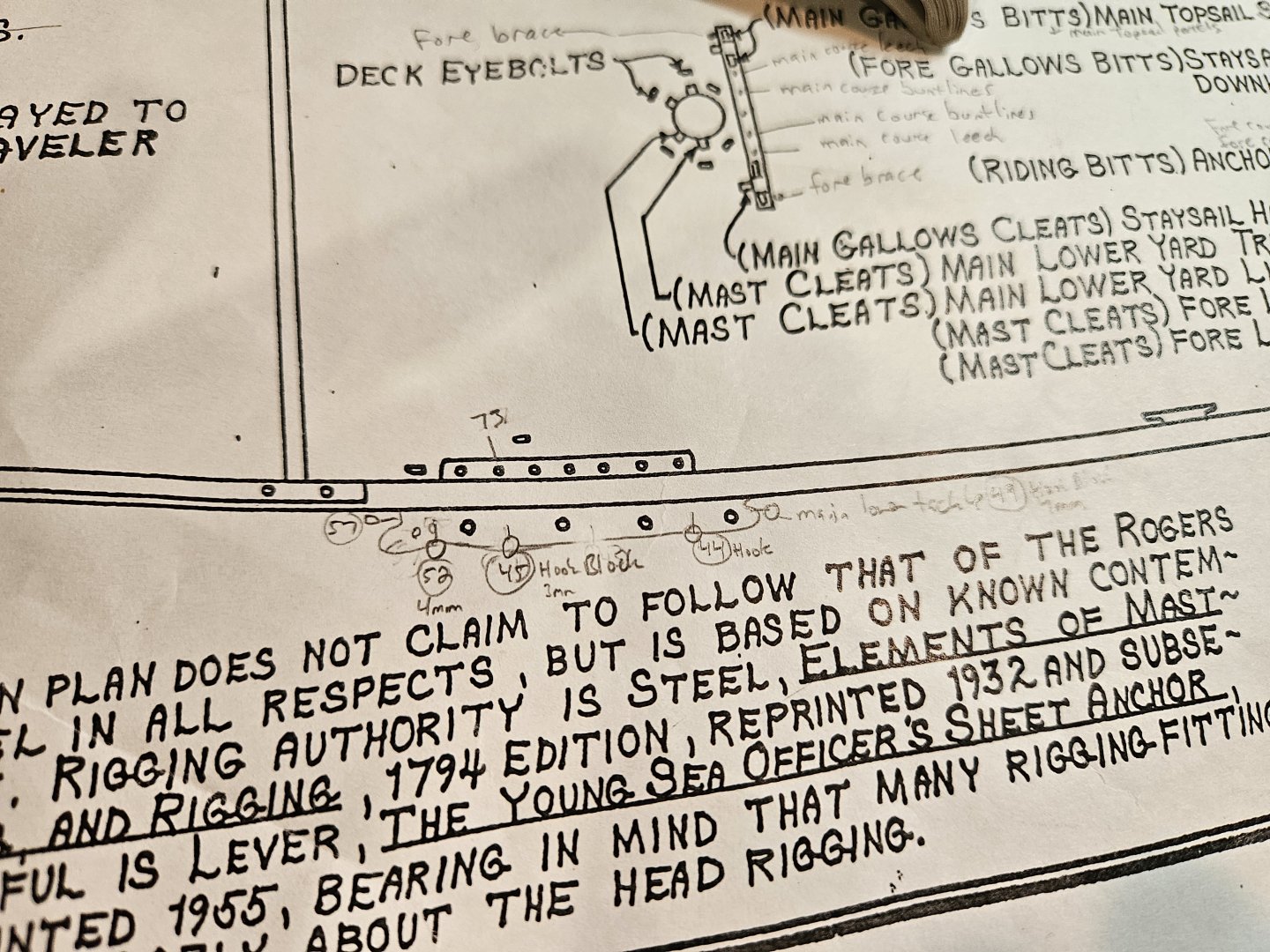
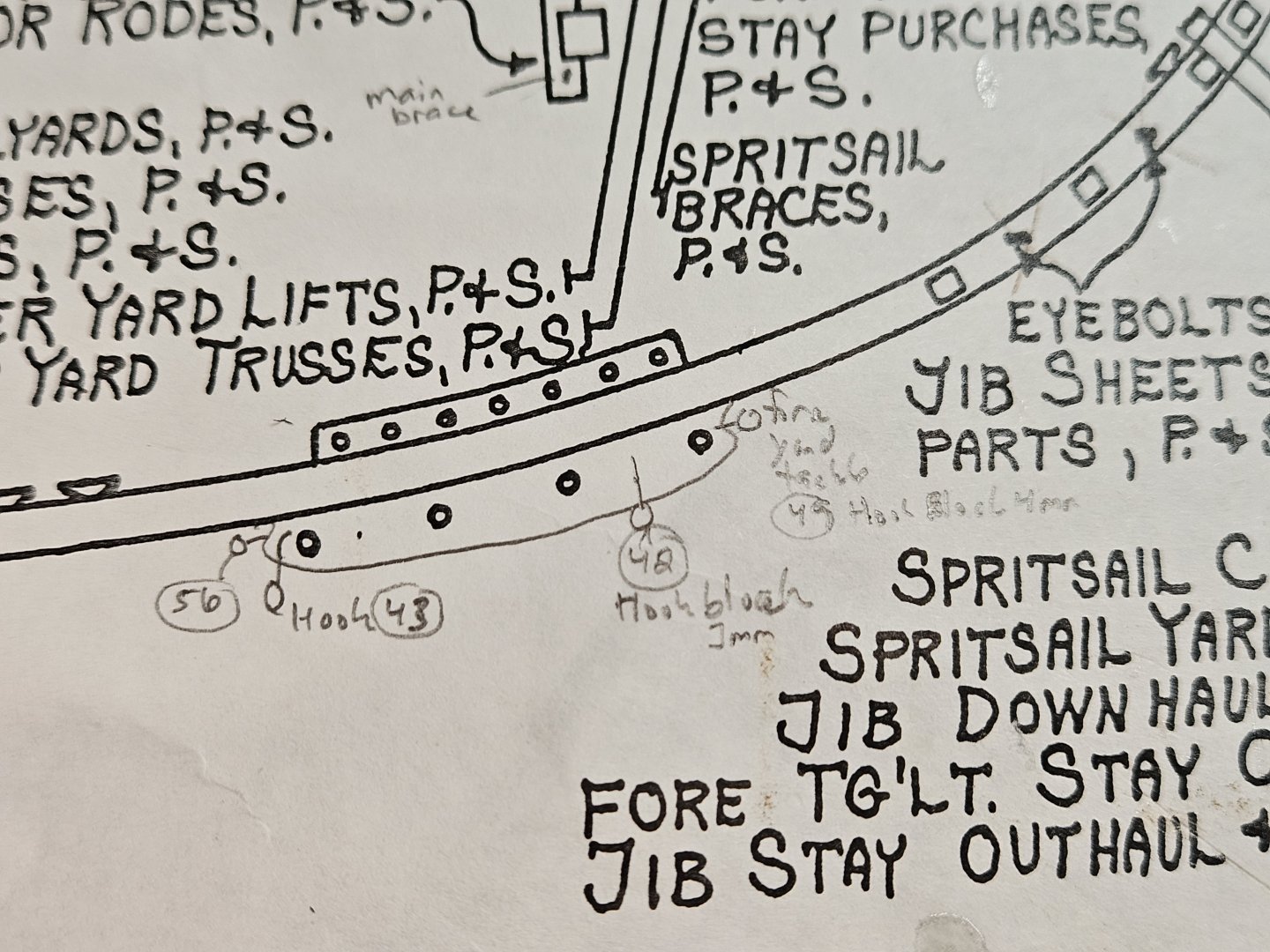

.thumb.jpg.d4762c4ceafc75991fdd65e4d633ae93.jpg)
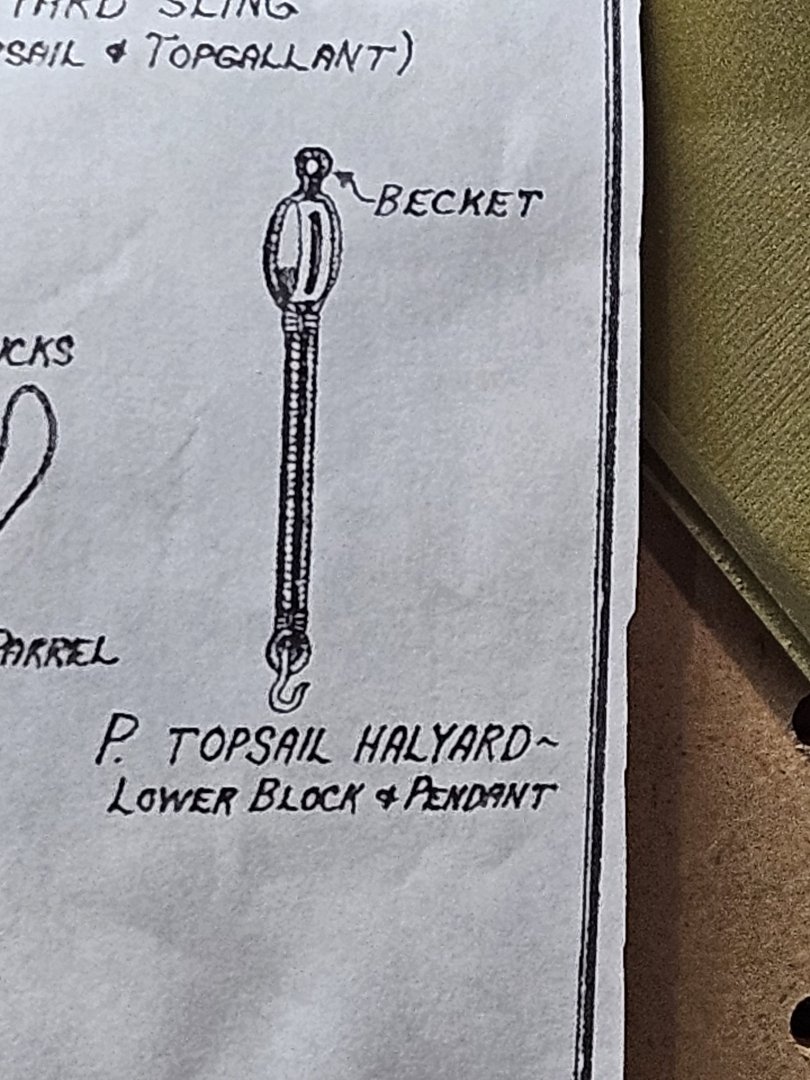
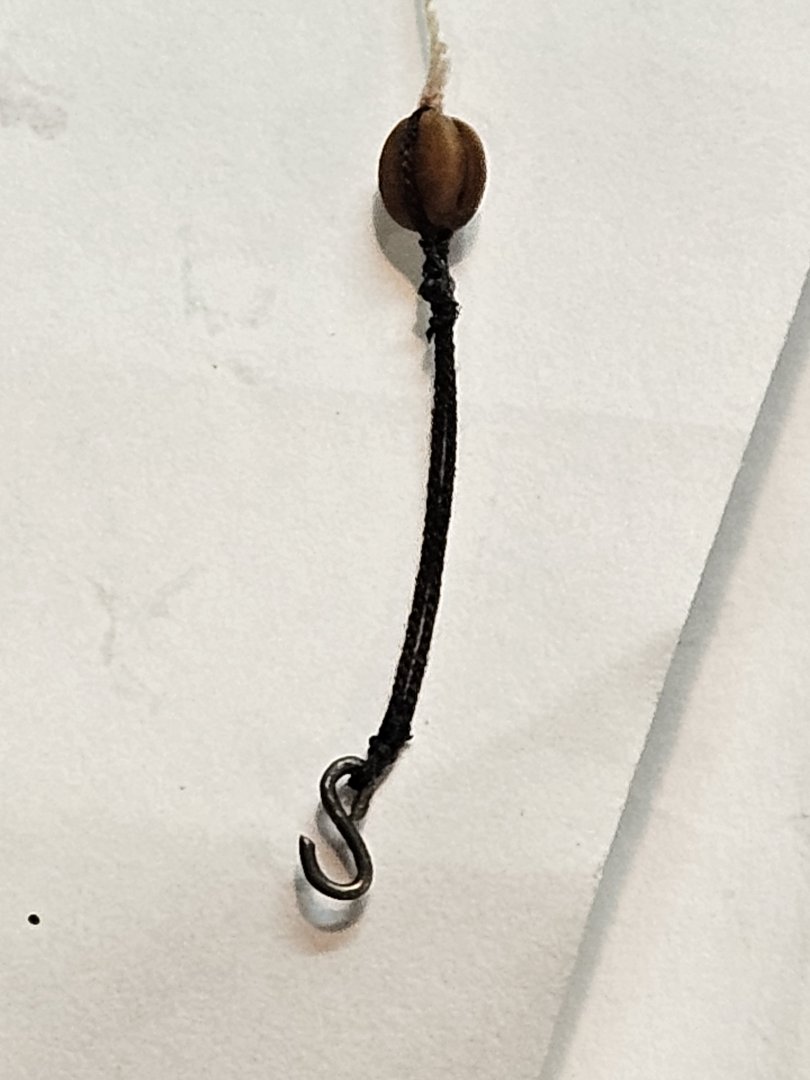
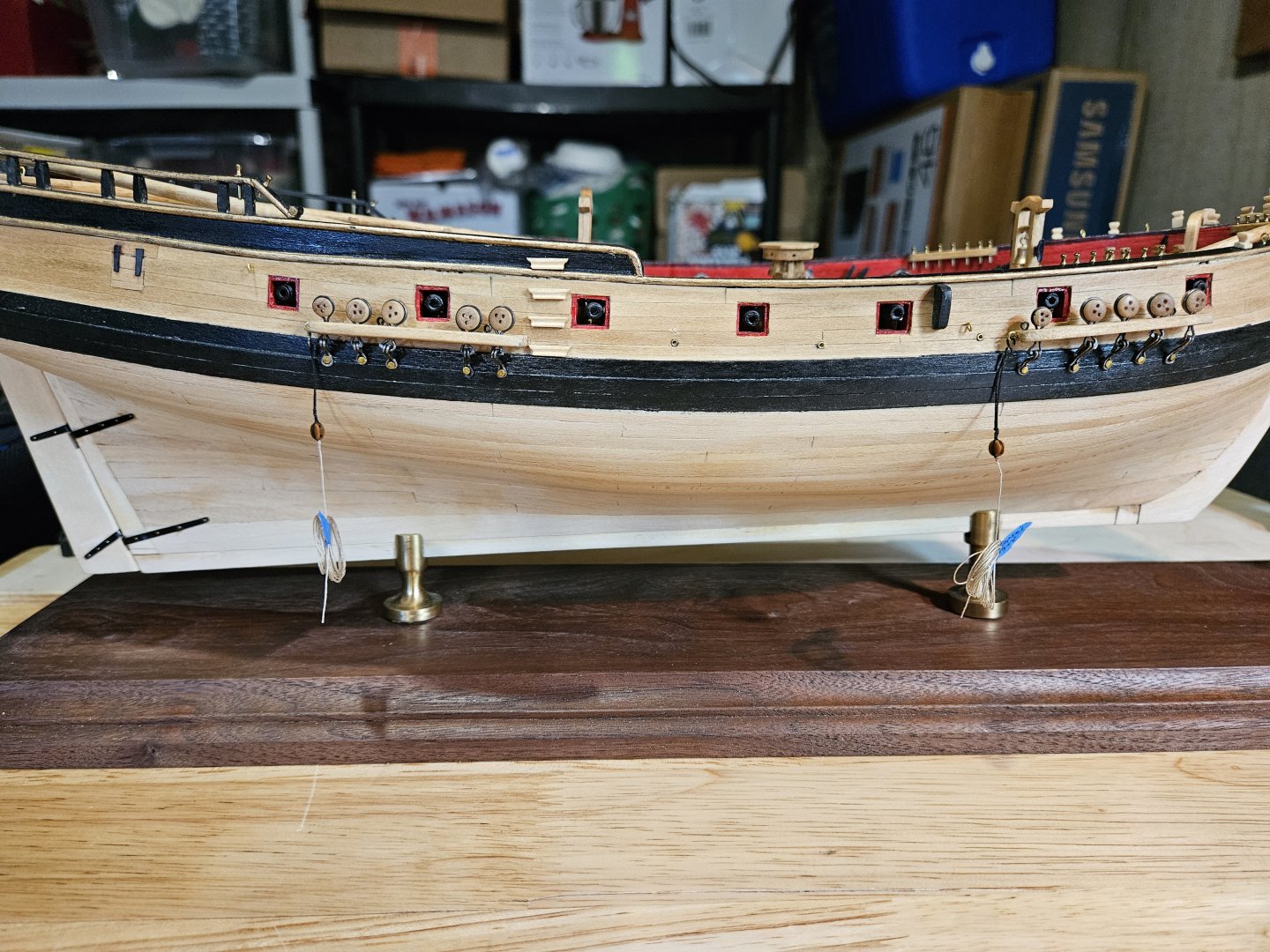
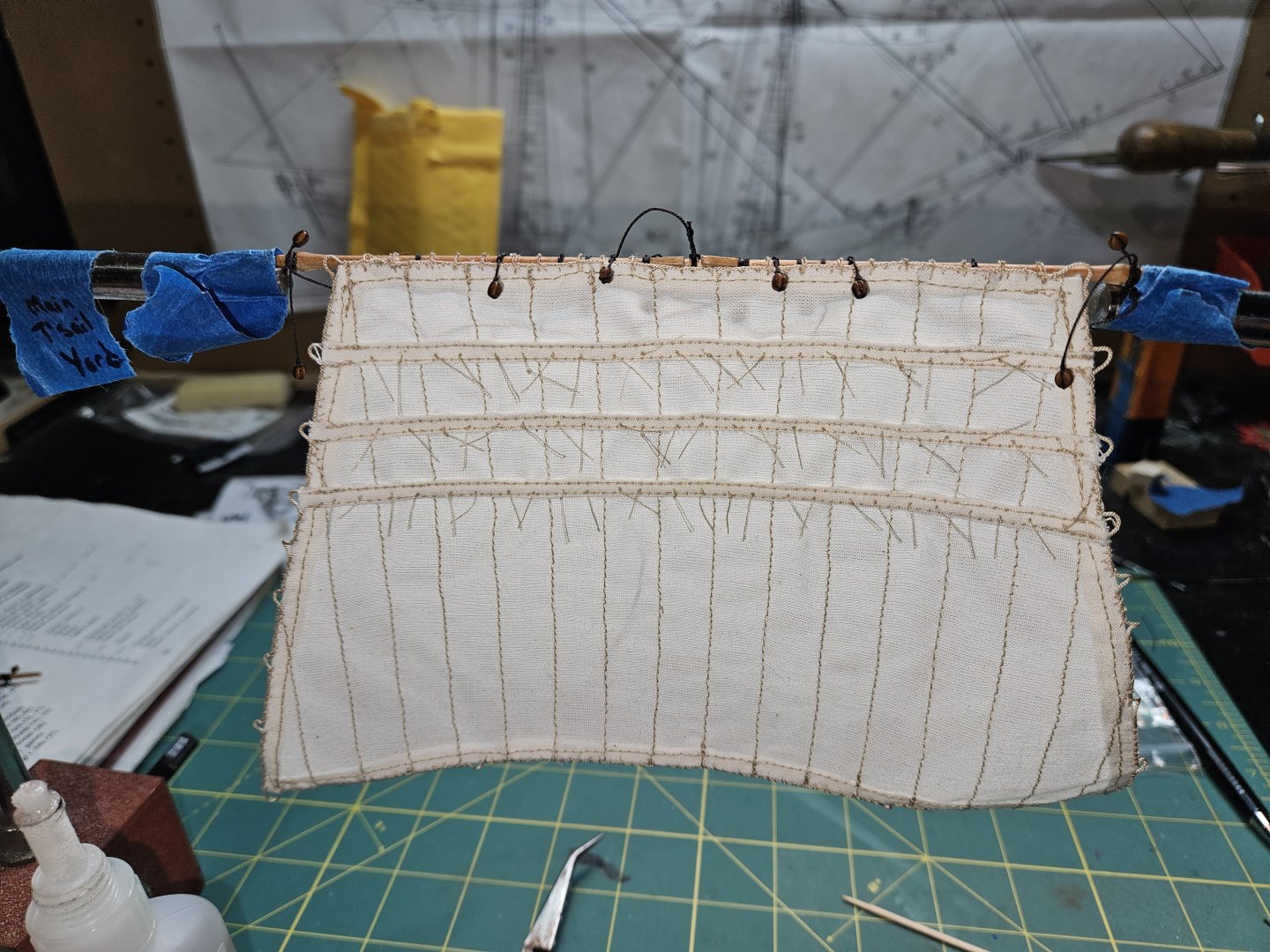
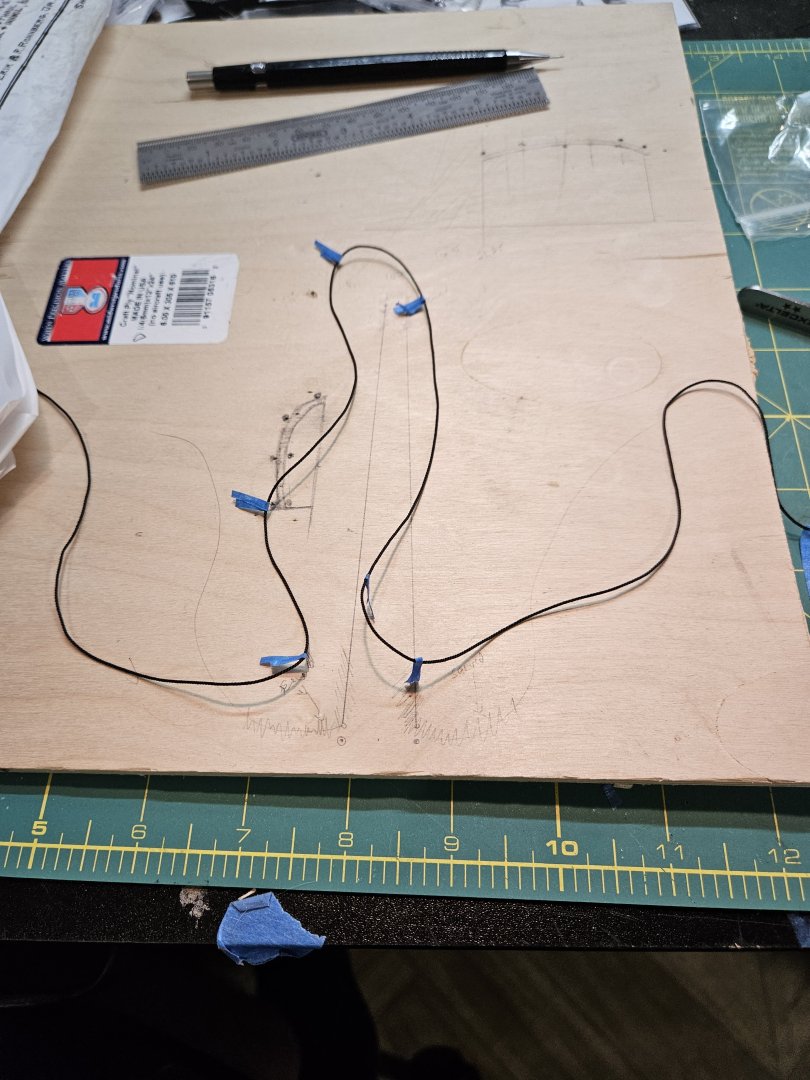
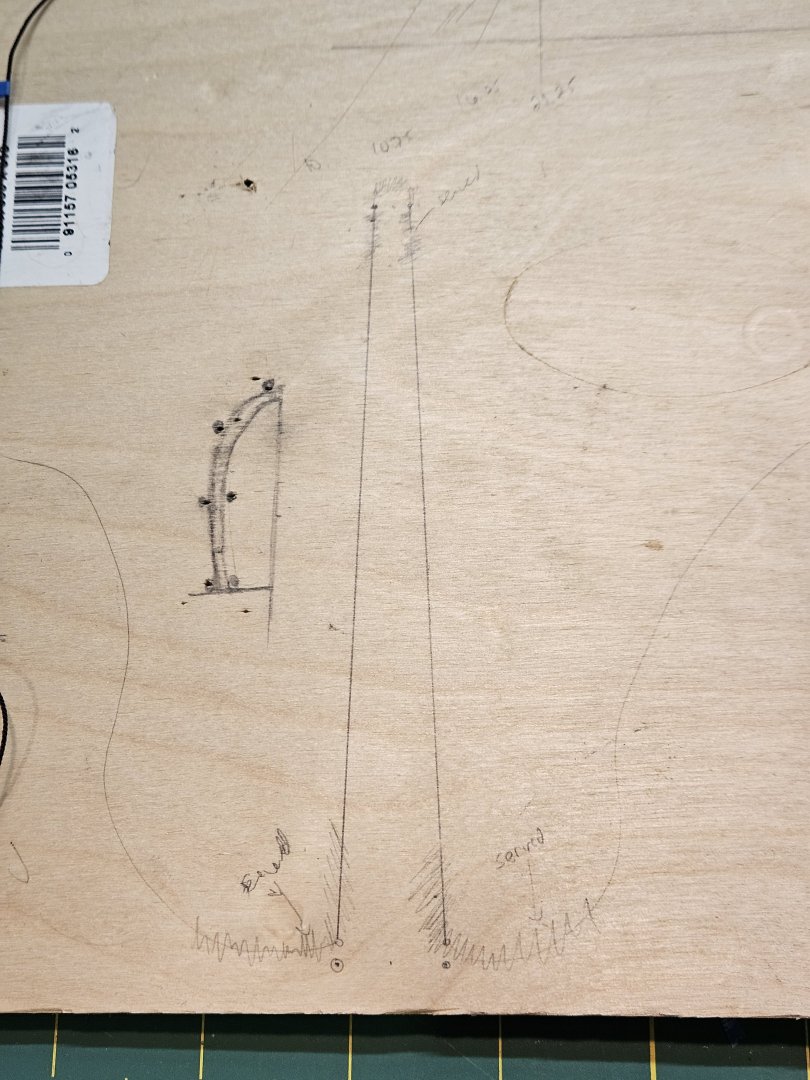
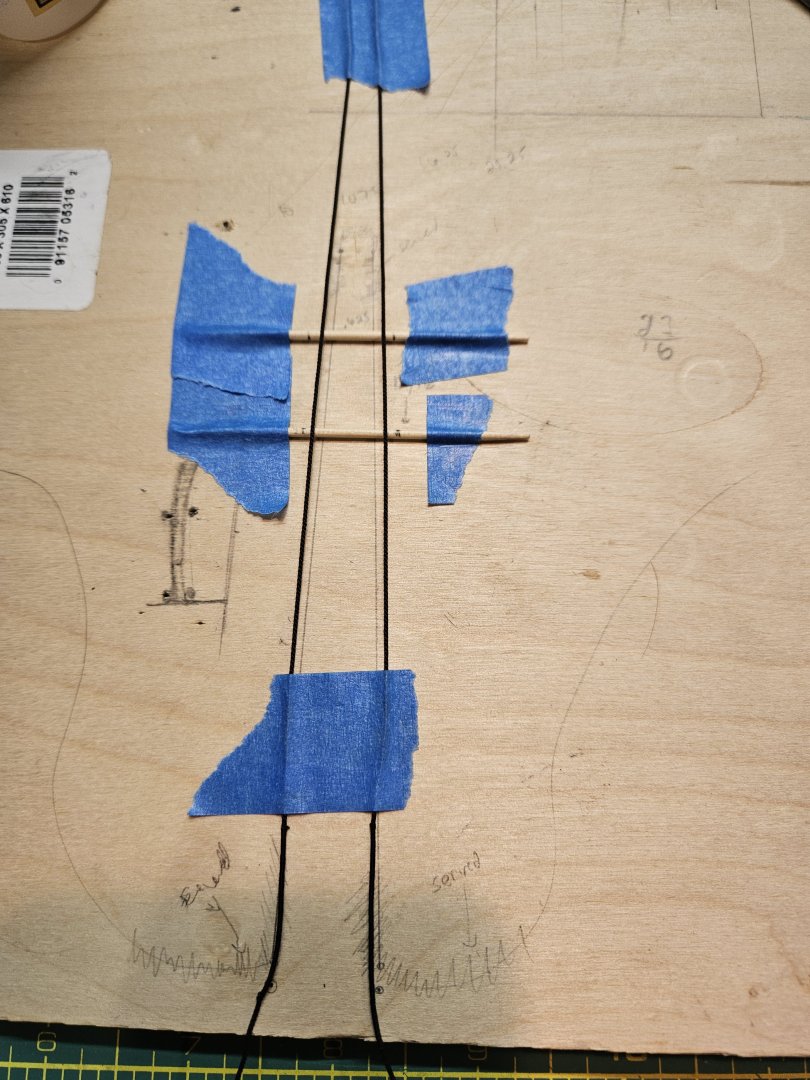
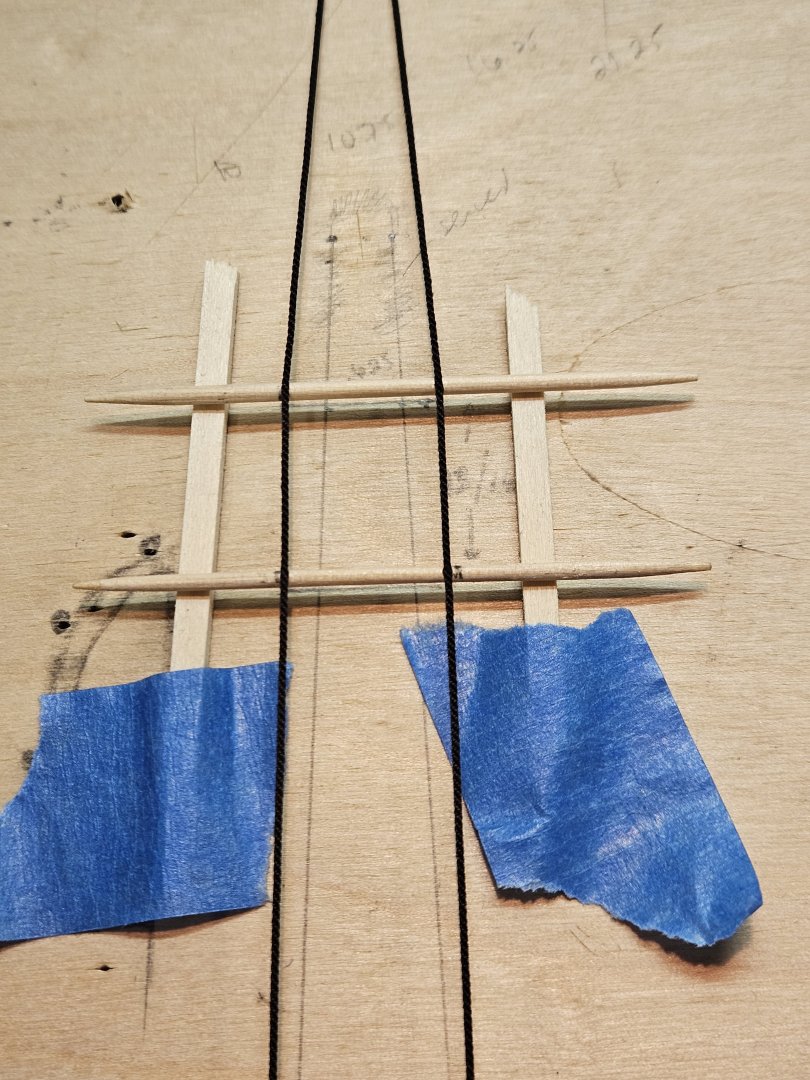
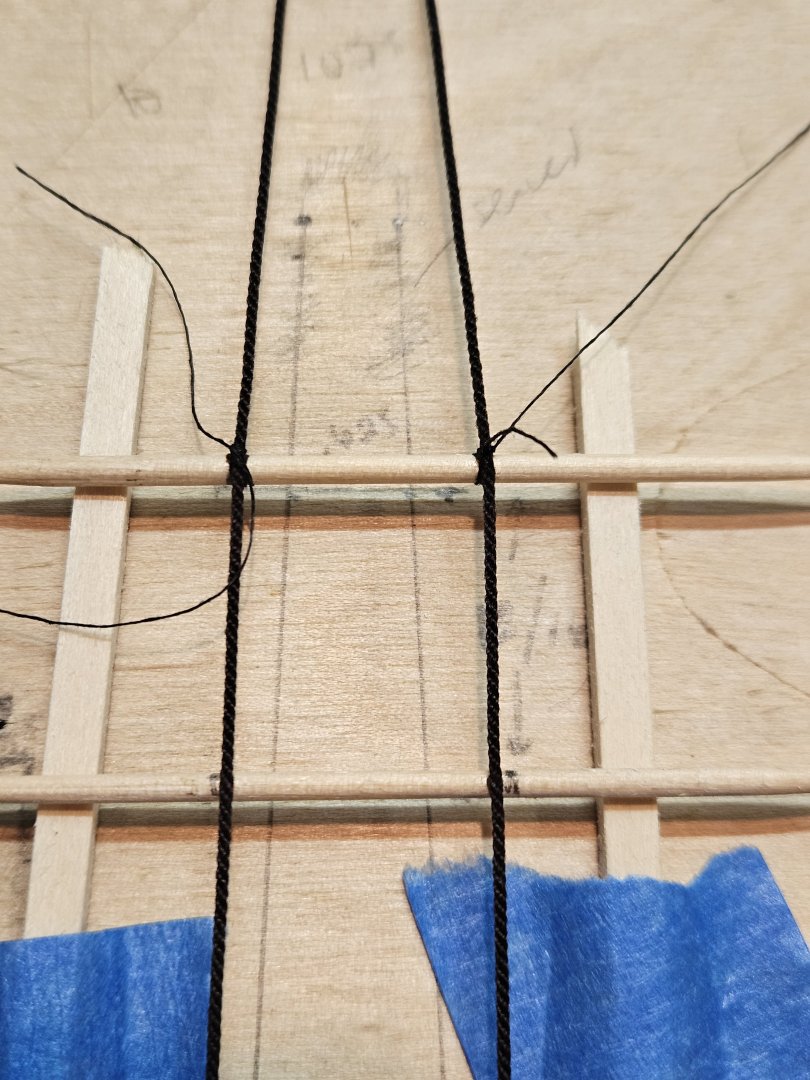

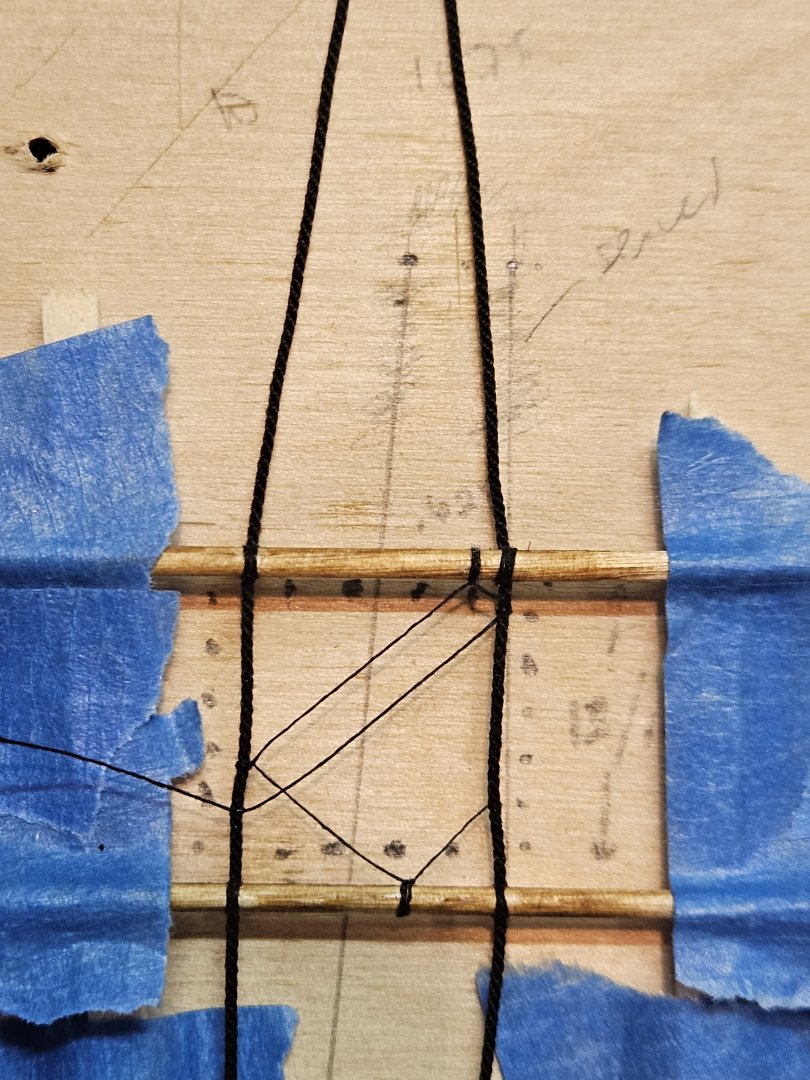
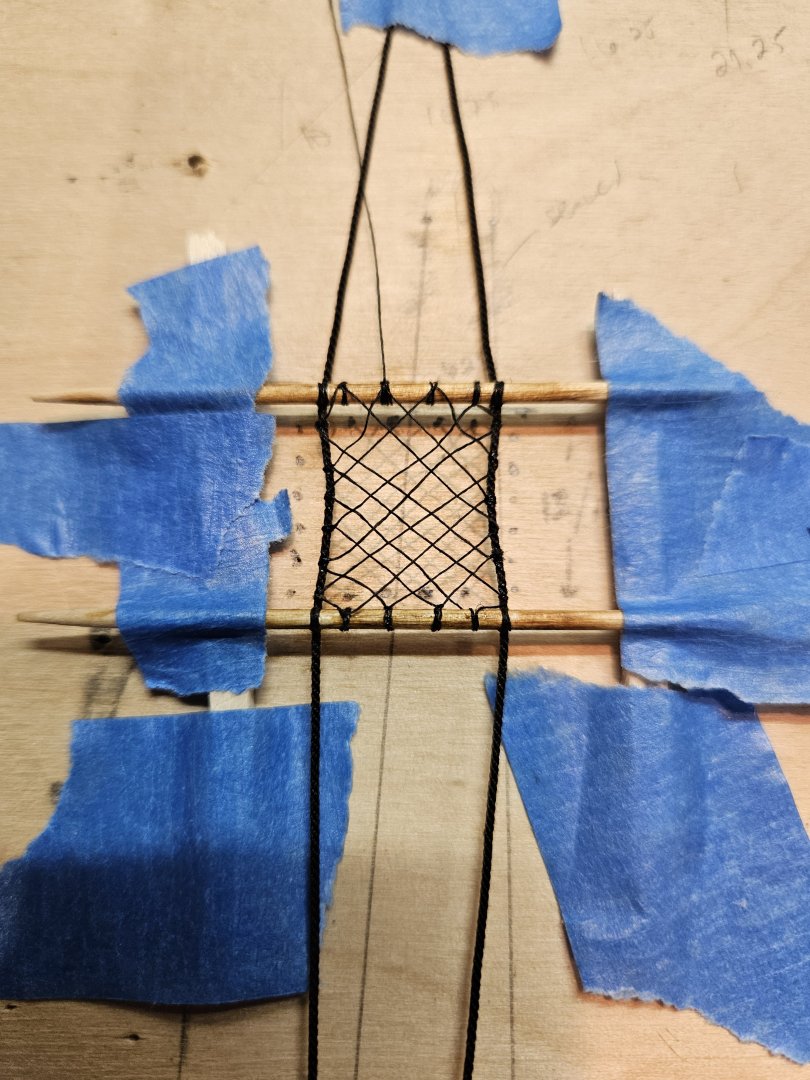
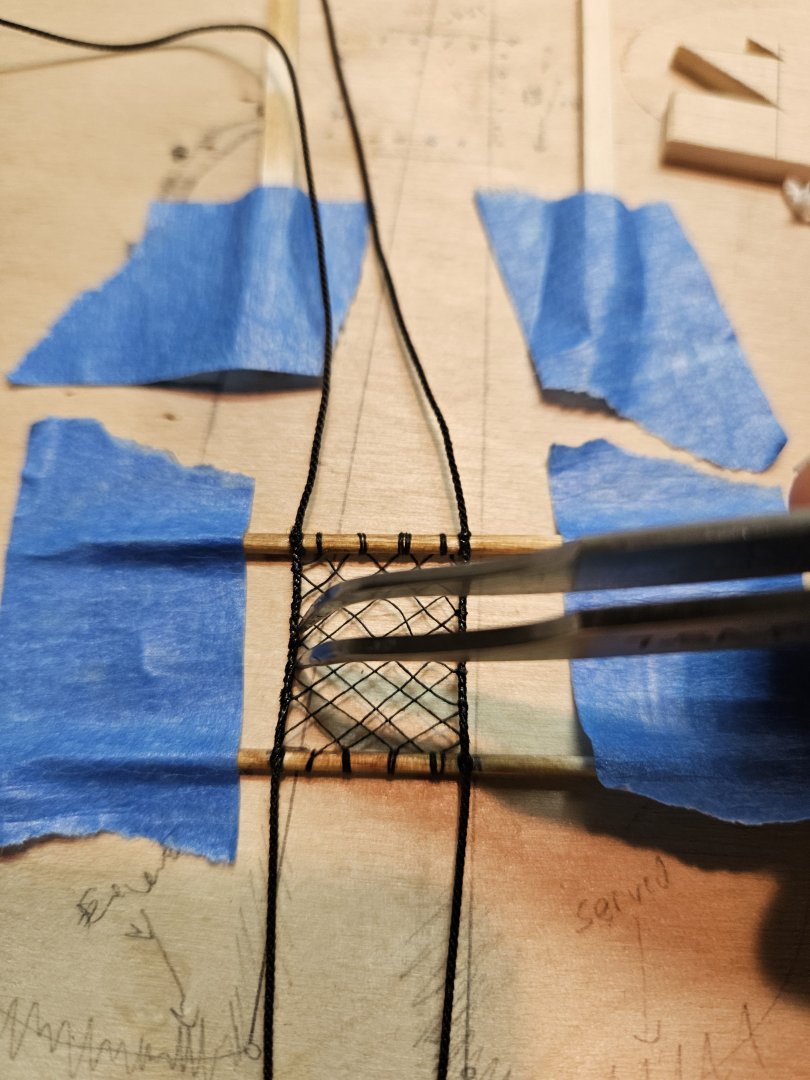
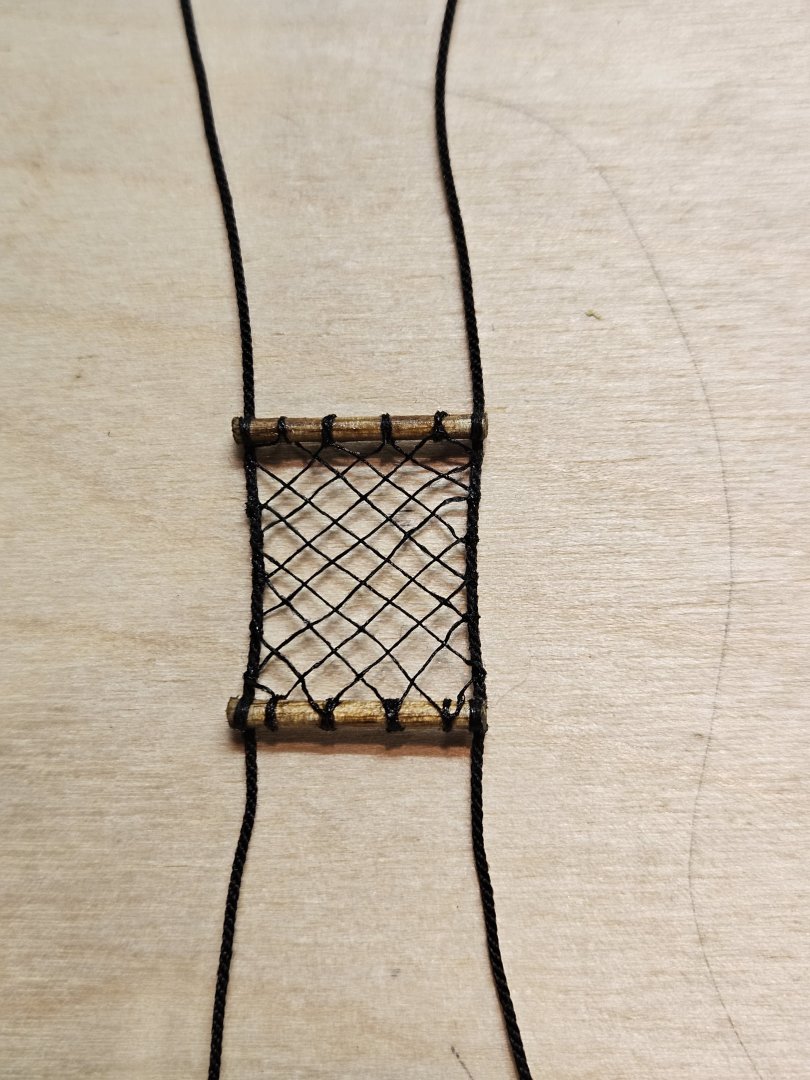
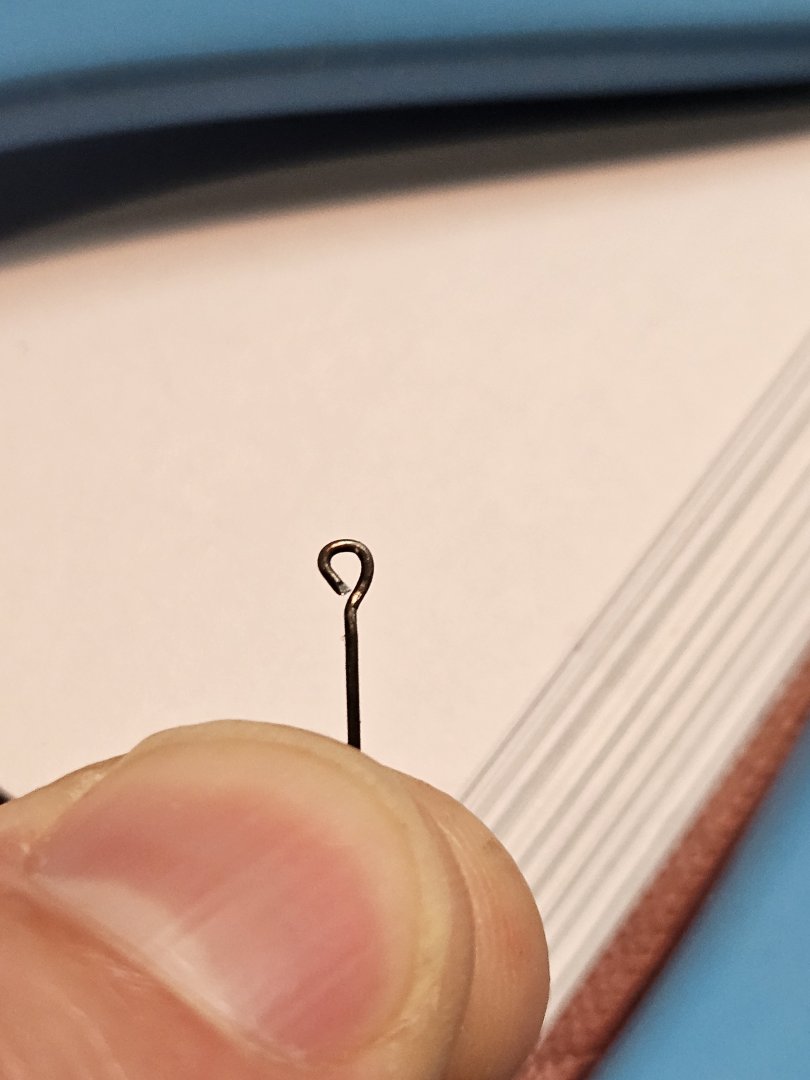
.thumb.jpg.9a6fd5cec2a51f43da52dfccbb5df888.jpg)
